French Castles Tour – 2024
Chateaux of paris and the loire valley.
Home > Major Tours > French Castles

Visit and tour Paris, the capital of France, and spend three nights there altogether - two at the beginning and one at the end.
Spend four nights in the Loire Valley, the garden of France. With its mild climate the Loire was the favourite residence of kings and their kin. It remains a corner of paradise, with its dream-like palaces, elegant towns, quiet landscapes and majestic rivers. The vineyards are a feast to the eyes and their fruits a joy to the palate.
Castle, palace and regional highlights include the Montmartre district, the Palace of Versailles, the Eiffel Tower, a Seine Cruise, and Notre Dame in Paris; Fontainebleau Palace, Orléans, Chenonceau Palace, Amboise Castle and village, Manor Clos-Lucé, Cheverny and Chambord Châteaux, Blois Castle and town, Villandry Château, and Tours.
The Slideshows in the In Depth section provide a quick overview of tour destinations and features.
Top Map Itinerary Features Images In Depth References Dates & Prices Contact Bottom


Day 1 – DEPARTURE
Board your flight from your home destination to Paris, France.
This itinerary assumes this to be an overnight flight.
Air fare independently arranged.

Day 2 – WELCOME TO PARIS
Arrival in Paris, France.
Individual transfer to your hotel in Paris.
Tonight you'll meet your travelling companions and tour director, and enjoy a welcome dinner in Montmartre, the artist district high above the city with great panoramic views.
> Your tour includes: Transfer from airport to Paris hotel, welcome dinner with menu choices and wine (or, of course, something else), hotel in Paris

Day 3 – PARIS - VERSAILLES, EIFFEL TOWER
After breakfast, board your sparkling clean coach to go for a guided tour of VERSAILLES, perhaps the most famous palace in the world. From 1682, when King Louis XIV moved from Paris, until the royal family was forced to return to the capital in 1789, the Court of Versailles was the centre of power in France. Spend several hours visiting the Palace of Palaces and the famous gardens with the fountains.
In the afternoon we go up to the second floor of the EIFFEL TOWER for majestic views. This tower, built for the 1889 World's Fair, is one of the most recognizable structures in the world and is the most visited paid monument anywhere.
Dinner tonight is on your own.
> Buffet breakfast, door-to-door transportation, tour of Versailles, entrance to Eiffel Tower, hotel in Paris

Day 4 – FONTAINEBLEAU, ORLÉANS, LOIRE VALLEY
We leave Paris this morning to visit nearby FONTAINEBLEAU. Used by kings of France from the 12th century, the royal hunting lodge of Fontainebleau was enlarged and embellished in the 16th century by François I, combining Renaissance and French artistic traditions.
We continue on to ORLÉANS, the city which Joan of Arc liberated in 1429. Breaking the English siege was one of the great episodes in the history of France, and marked the rebirth of a country and of a people that had been sinking into despair. Enjoy free time here for lunch.
Later continue to your chateau in the heart of the Loire Valley, our new home for the next four nights.
> Buffet breakfast, door-to-door transportation, guided tour of Fontainebleau Castle, three-course dinner with menu choices, one beverage, and coffee or tea, hotel - Château de Razay in Céré La Ronde

Fontainebleau
Day 5 – CHENONCEAU PALACE, AMBOISE CASTLE, CLOS-LUCÉ
In the morning we go first to visit nearby CHENONCEAU, the "Ladies Castle". This beautiful castle stretches across the River Cher in a harmonious natural setting of water, greenery, gardens and trees. Over a period of 400 years this castle was shaped by women, royal wives, mistresses and queens.
We continue on to Amboise for lunch, and afterwards visit the CHÂTEAU D'AMBOISE, once a very important royal residence and home for several French kings. The palace is a mix of Gothic and Renaissance architecture, and is now less than a third of the size it was in the 16th century.
Leonardo da Vinci lived nearby in MANOR CLOS-LUCÉ as a guest of King Francis. We visit this palace, now a museum with period furniture, sketches and working models of the ideas of this renaissance genius.
> Buffet breakfast, door-to-door transportation, entrance fees and guided tours of the above castles, three-course dinner, hotel - Château de Razay in Céré La Ronde

Day 6 – CHEVERNY, CHAMBORD, BLOIS CASTLE AND TOWN
This morning our first visit is to the CHÂTEAU DE CHEVERNY. The symmetric design and harmonious grandeur of the façade of are characteristic features of the period of Henri IV and Louis XIII. The interior is sumptuously appointed, with beautiful furniture, sculptures, gilt work, marble and multi-coloured paneling.
We continue with a short ride to CHÂTEAU DE CHAMBORD, the largest by far of all the Loire chateaux, built on a scale foreshadowing that of the Palace of Versailles.
On to the Royal City of Blois where we visit the ROYAL CHÂTEAU DE BLOIS, the residence of several French kings. Built in the middle of the town that it effectively controlled, the Château de Blois comprises several buildings constructed from the 13th to the 17th century around the main courtyard.
Free time for dinner in this beautiful city on the hillside overlooking the river Loire where many of the medieval streets still remain.
> Buffet breakfast, door-to-door transportation, entrance fees and tours of the above castles, hotel - Château de Razay in Céré La Ronde

Day 7 – VILLANDRY, TOURS
Today we visit CHÂTEAU DE VILLANDRY, one of the last great Renaissance chateaux to be built in the Loire Valley. Villandry’s international fame is based largely on its gardens, among the most fascinating in all of France and Europe.
In the afternoon we drive to TOURS, the capital of Touraine, a thriving economic and cultural centre. Go for a stroll in Place Plumereau, a picturesque and animated square, once a marketplace, lined with 15th century timber-framed houses alternating with stone facades. Enjoy a café au lait in the square and get your final Loire Valley souvenirs.
Tonight we are having a nice dinner in a medieval village.
> Buffet breakfast, door-to-door transportation, entrance fees and tours of the above castles, three-course dinner, hotel - Château de Razay in Céré La Ronde

Day 8 – PARIS - NOTRE DAME, SEINE RIVER CRUISE
We leave the Loire Valley this morning and head north again to Paris, arriving in time for your lunch break.
We are all saddened by the April 2019 fire at NOTRE DAME CATHEDRAL. After lunch you will have time to see restoration work at the site, but from a distance.
Then a short walk across Île de la Cité to visit SAINTE CHAPELLE, a royal chapel in the Gothic style, part of the residence complex of the Kings of France until the 14th century. Marvel at one of the most extensive 13th-century stained glass collections anywhere in the world.
Later we board a River Boat for a scenic cruise on the SEINE RIVER. We see many of the city's most famous landmarks from the river, and pass under many of the three dozen bridges over the river in Paris.
Then a short ride to your overnight hotel near the Charles de Gaulle (CDG) airport in Roissy. Enjoy a great farewell dinner and celebrate a wonderful week in France with your travelling companions.
> Buffet breakfast, door-to-door transportation, Seine River cruise, three-course dinner, hotel in Paris-Roissy

Day 9 – TIME TO SAY AU REVOIR
After breakfast individual transfers to the nearby Charles de Gaulle Airport to catch your homebound flight, which arrives the same day.
> Buffet breakfast, transfer to Airport

Tour Features
- All features as per itinerary, departure guaranteed
- Door-to-door transportation (all modes). Leave the navigating to us.
- 7 breakfast buffets
- 5 three-course dinners with menu choices, one beverage, and coffee or tea after dinner
- 7 nights' accommodation
- All entrance fees, taxes, and local guide fees paid
- No hidden extras, no optional excursions – already included
- Maximum group size of 30 people, fewer on most tours
- The tour language is English only.
- Packing and unpacking is minimized. Four nights at Château de Razay in the Loire Valley.
- The days are well planned to offer you many highlights, but you are never rushed. Ideal combination of free time and planned activities.
- Skip the lines at must-see attractions.
- All visits are inside, not drive-by. Learn the stories that bring old buildings to life.
- You will see not only the highlights but also the spots where only the locals go.
- Tour director – Let our experts make every day and destination fascinating!
- Satisfaction assured – backed up by our money-back guarantee.
Complete printable itinerary in PDF format > French Castles Itinerary

Hall of Mirrors, Versailles

Loire Valley Hotel
The hotel for the four nights spent in the Loire Valley will be the Château de Razay in Céré La Ronde, south-east of Chenonceau Palace. The chateau was built at the end of the 15th century and is surrounded by 85 acres of grounds and woodlands.

Latona Fountain, Versailles

Amboise Castle

Bridal Chamber, Cheverny

Blois Castle

Plumereau Square, Tours
There are more pictures of tour destinations in the In Depth section below, in larger formats. There are two automated Slideshows and a Gallery for selecting and examining larger images.
The Slideshows and the Gallery present the same images in the same sequence, but using different techniques. The Slideshows are effortless. The gallery has more comprehensive captions.
Thank you so much for a fabulous tour of the Loire castles and Paris last week. It all seems like a fantastic dream now!
You covered so much more than I expected, while giving us enough rest times and independence that I didn't feel overwhelmed, either. So thank you for such a well-orchestrated tour.
- Cathy Wolz, Virginia
Taking Astrid’s French Castles Tour was a dream come true for me! .... The chateaux in Loire Valley were magnificent and the pace of the tour was just right. Very little driving, centralized lodging in a fabulous location, and plenty of free time. Astrid is very personable and everyone loves her. I’ve taken two of Astrid’s European Castles tours and can’t wait to take another!
- Leslie Granger, California Read more ...
Castles, breathtaking scenery, quaint towns, vintage wines, gourmet food, Paris, history, culture, 653 photos.
All this and more, in an awesome location with an amazing tour guide. The French Castles tour was an exceptional deposit in our memory bank and we cannot wait to follow Astrid again!
- Rick and Suzanne Handley, Texas
Additional comments on this and other Castles Tours are provided on a separate References Page .
Comments, experiences and recommendations from guests on past tours are featured in our References Video
Dates, Prices and Reservations
Complete printable itinerary in PDF format >
This tour is offered on the following basis:
Tour prices are for the land segment only. Air fare is not included.
Prices are per person, in U.S. dollars, based on double occupancy.
Single occupancy is available for a single supplement charge, triple occupancy rates are reduced, and there is a special rate for a child 8 to 16 years old sharing a room with two adults.
Guaranteed Departure: This tour is guaranteed to operate as scheduled and will not be cancelled due to a low level of participation.
A deposit of US $ 400 per person is required to secure a reservation on these tours.
Personal expenses, lunches and gratuities for the driver and local guides are not included.
Note re Inflation: Due to inflation in the general economy and additional inflation in the travel industry prices may need to be increased in mid-season. Prices in effect at the time deposits are paid are guaranteed not to change.
French Castles Tour – Remaining 2024 Departure Date
French Castles Tour – 2024 Prices
Reservation info and online form >
Dates for all scheduled major tours >
Private Tour Option
If our dates do not work for you we can arrange the tour for you or your party as a private tour. Same itinerary as above in a private limousine or van, with bilingual, professional private guide / chauffeur. Prices per individual are the same as for the regular group tour, plus a US $ 400 per day private tour premium for the group.
Contact us with your preferred dates and specific requirements at this private tour email link ... or phone one of the numbers below, or write to the address on our Contact page.
Contact Information
Email is fast, flexible, and free. You can write to us at this email link (or [email protected]).
You can call us in Germany (Eastern Time + 6 Hours):
U.S. Phone: (202) 580 - 8732 / Direct number in Europe: +49 171 546 6839
- US +1 (800) 860-1034
- AU +61 1300 313 343
- UK +44 (0)800 098 8175
Our Picks: 11 Must-Visit Châteaux in France
Fluffy choux, fine Champagne and fabulous châteaux – where else could it be but the spiritual home of romance? Read on as we unearth some of the very best châteaux in France.
If you enjoy soaking up culture, history, fine art and gorgeous gardens, then these beautiful French stately homes will make for must-do excursions during your next visit.
Cameras at the ready, it’s time to explore…
What is the French definition of a château?
Before we dive deeper into the best French châteaux to visit, let’s take a moment to define exactly what a château is.
The word can refer to many things, however the true definition of a château is a French power house – a manor house or historic home associated with nobility. In this sense, châteaux are not too far removed from English stately homes in their appearance and purpose.
While the words castle and château are often used interchangeably, there is a difference. Castles were built for military or religious purposes, while châteaux were built for private residence.
Additionally, châteaux can be used to describe wine-growing estates in some areas of France, although in this rundown, we’ll focus solely on historic homes with public access.
Where are most of the châteaux in France?
Châteaux can be found across the country; it is understood that there are around 6,500 manor house châteaux, adding to a reported total of around 43,000 châteaux of varying descriptions in France. Many of these are found towards the west of France in Bordeaux and the Loire Valley.
However, you will also find châteaux in regional areas surrounding popular cities such as Lyon, Dijon, Reims, and Paris – these are the areas we’ll be focussing on, as they are often less overrun by visitors and thus can deliver a better experience.
The best châteaux to visit near Lyon
While the Auvergne-Rhône-Alpes region is better known for its picturesque villages and culinary mastery , the area has a handful of must-see châteaux.
Image: chateaudeflecheres.com
Château de Fléchères
Around 40 minutes north of Lyon, the magnificent Château de Fléchères was built between 1606 and 1625, which is very impressive considering the scale of the building. This serene château features inspiring frescos by Pietro Ricchi, a third-floor Calvinist temple, and an English-style garden, along with views of the renowned Beaujolais area.
Image: Loic Julien
Château de Grignan
Admittedly pushing the boundaries of ‘near Lyon’, Château de Grignan is simply too gorgeous to leave off this list. Part castle, part Renaissance mansion, this architectural gem is perched high above the quaint village of Grignan and offers sensational views across the region. If you can tear yourself away from the panoramic vistas, you will find a treasure chest of 16th-century artwork, furniture and other treasures to admire inside.
Image: Ultimate Driving Tours
Château de Bagnols
Nestled among the vineyards of Beaujolais, Château de Bagnols is certainly one of the more fortified châteaux on this list, with towers, drawbridge, and moat – yet it’s also modernised and welcoming thanks to its conversion into a luxury hotel. While it doesn’t offer the same museum experience as some of others mentioned here, you can spend ample time absorbing the architecture and interiors by relaxing in the stunning spa, the lavish rooms, or the Michelin-starred restaurant, 1217. To experience it for yourself, why not join us at Château de Bagnols as part of our luxury French driving tour ?
Famous châteaux in Burgundy
One of France’s finest wine regions , Burgundy is home to around 100 châteaux, peppering the vineyard-covered countryside. Here are some of our favourite châteaux in Burgundy.
Image: chateau-ancy.com
Château Ancy le Franc
A product of the famous Italian architect Sebastiano Serlio, Château Ancy le Franc is a portal to the Renaissance era in the heart of Burgundy. Wander the long corridors and sumptuous galleries of this 16th-century masterpiece, and enjoy one of the largest Renaissance mural collections in the country. After this, there’s a sprawling estate to explore, including perfectly sculpted gardens, stables, and orangery.
Image: worldofwanderlust.com
Château de Cormatin
Set in Southern Burgundy, among wide moats and pond-dotted gardens, the 17th-century Château de Cormatin is another Renaissance treasure, and includes a 21-metre high staircase, which was an architectural feat of its time. The sumptuously decorated apartments are a pleasure to meander around, while outside the splendid gardens are equally fascinating, with an ornamental maze, green theatre, and vegetable gardens.
Image: closdevougeot.fr
Château Clos de Vougeot
Vin enthusiasts may have heard of Château Clos de Vougeot, which is viewed as the heart of Burgundy’s wine history. It was originally used as a vineyard by Cistercian monks in the 12th century, before the construction of a Renaissance palace around four centuries later. The estate no longer produces its own wine, but its vines are still put to use by other producers. There’s plenty to see inside the château, including the original kitchens and a huge cellar that can house 2,000 barrels.
The best châteaux to visit near Paris
A visit to Paris is always a sensory overload, being home to magnificent architecture, famous works of art, and many of the best restaurants in Europe . However, taking time to visit the châteaux just outside the city will reward you with some of the finest sights in this area of the country.
Image: en.chateauversailles.fr
Château de Versailles
Originally built as a hunting lodge in 1623, the breathtaking Château de Versailles has been extended over the centuries to its current state as a UNESCO World Heritage site and one of France’s most iconic buildings. Once home to French kings, the palace has been a national museum since 1883 and now attracts around 15 million visitors a year. Explore lavish rooms, ever-changing exhibitions, and the pristine gardens that will host the equestrian competition at the Olympic Games in 2024.
Image: chateaudefontainebleau.fr
Château de Fontainebleau
Around 50km south of Paris, Château de Fontainebleau is another of France’s largest châteaux with 1,500 rooms and 800 years of history. Today an enthralling tribute to French art, history and architecture, the 12th-century building once served as a residence for French monarchs. This extravagant palace is a wonder to explore, with a Napoleon Bonaparte museum, Chinese museum, a Jeu de Paume court, and multiple gardens and courtyards.
Image: chateaudechantilly.fr
Château de Chantilly
Another of the excellent châteaux to visit near Paris is the distinctive Château de Chantilly. Built in the 11th century and expanded over the years (including a complete rebuild after the French Revolution), this famous château is an architectural marvel that’s as beautiful as it is idiosyncratic. It’s a haven for art buffs – after the Louvre, it boasts the second largest collection of antique paintings in the country, as well as 60,000 volumes in its grand library.
Beautiful châteaux to visit in the Champagne region
The region of Champagne has more to offer than just beautiful bubbling wine – you can also quench your thirst for history and culture by exploring some of the area’s most famous châteaux.
Image: aube-champagne.com
Château de La Motte-Tilly
Built in 1754, Château de La Motte-Tilly truly brings to life the grace and finesse of 18th-century France. Inside this stunning sandstone stately home, you will find preserved rooms that are richly furnished, while exploring the surrounding gardens, lake and lush 60-hectare parkland is a delight. Magnifique!
Image: chateaudecirey.com
Château de Cirey
Château de Cirey is an elegant 17th-century château that remains a private residence, while also opening its doors to visitors. It’s most notable for its association with the famous French writer François-Marie Arouet – better known as Voltaire – who took refuge here in 1734 to avoid arrest after the publication of his controversial Lettres sur les Anglais. Interesting highlights include the dining room, living room, chapel and the small theatre where Voltaire rehearsed his plays.
Discover our ‘Michelin star’ tour: Châteaux & Champagne
If the idea of driving through rustic French countryside in a fleet of supercars, staying in stunning châteaux (including the aforementioned Château de Bagnols), and sipping vintage Champagne is your idea of heaven, then you will adore our luxury driving tour of France .
As an intimate group of enthusiasts and luxury-seekers, we explore Lyon, Bussière, and Epernay, enjoying the very best of French culture and cuisine. To learn more, reach out to our friendly team today.

Castle Library
Ultimate 7-day french chateaux tour guide: the loire valley, monte schumacher.
- Castle Tour , French Chateau

Bienvenue! Welcome to the enchanting world of the Loire Valley, where history, romance, and architecture converge to create an unforgettable journey. If you’re a traveler with a penchant for fairy-tale castles, you’re in for a treat. This comprehensive guide will take you on a 7-day adventure through the magical realm of French chateaux. From the grandeur of Chateau de Chambord to the romantic allure of Chateau de Chenonceau, prepare to be captivated by the Best French Chateaux Tour.
Day 1: Arriving in the Loire Valley
Getting there.
The Loire Valley is easily accessible from Paris, making it an ideal day trip or a longer getaway. Here are a few transportation tips:
- Train : The quickest and most convenient way to reach the Loire Valley from Paris is by taking the high-speed TGV train. The journey takes approximately 1.5 to 2 hours, with stations in Tours, Blois, and Amboise, among others.
- Car : If you prefer flexibility and plan to explore the Loire Valley extensively, consider renting a car in Paris. The drive takes around 2 to 3 hours, and it allows you to explore smaller villages and chateaux that may not be easily accessible by train.
Personal Tip : If you’re taking the train, book your tickets in advance to secure the best rates. Be sure to check the train schedules to make the most of your time in the Loire Valley.
Where to Stay
The Loire Valley offers a plethora of accommodation options to suit every budget. From luxury chateau hotels that promise a royal experience to cozy bed and breakfasts that offer a homely atmosphere, there’s something for everyone. Make sure to book your stay in advance for a seamless trip.
Day 2: Chateau de Chambord
On day two, it’s time to kick off your chateau-hopping adventure with the grandest of them all, Chateau de Chambord. This magnificent chateau is renowned for its stunning French Renaissance architecture, complete with turrets and intricate details that seem straight out of a fairy tale.
- History : Chateau de Chambord’s history is as grand as its architecture. Commissioned by King Francis I in the early 16th century, it’s a testament to royal extravagance.
- Architecture : The pièce de résistance is the double-helix staircase, believed to be designed by none other than Leonardo da Vinci. It’s an architectural marvel worth lingering over.
- Best Times to Visit : To avoid the crowds and capture the best photos, arrive early in the morning or later in the day. Don’t forget to explore the surrounding gardens and forests for a serene experience.
Additional Chateau : If you have extra time, consider visiting nearby Chateau de Cheverny, known for its well-preserved interiors and the fascinating daily dog feeding ritual.
Dining Recommendation: Le Grand Saint-Michel (1 Michelin Star)
For a delightful gastronomic experience, head to Le Grand Saint-Michel, a Michelin-starred restaurant located near Chateau de Chambord. The restaurant offers a refined menu featuring seasonal and local ingredients, providing a culinary experience that complements your chateau visit.
Day 3: Chateau de Chenonceau
Your next stop is the exquisite Chateau de Chenonceau, often referred to as the “Ladies’ Chateau.” This chateau is an epitome of romance, built on the banks of the River Cher.
- Romantic History : Chateau de Chenonceau’s history is intertwined with remarkable women who played pivotal roles, such as Diane de Poitiers and Catherine de’ Medici. Their stories add an extra layer of charm to the chateau.
- Gardens and Bridge : Explore the stunning flower gardens that surround the chateau, and don’t miss the unique bridge that spans the River Cher, adorned with flower boxes.
- Best Times to Visit : To experience the chateau’s magic with fewer visitors, consider early mornings or late afternoons.
Additional Chateau : For those who appreciate art and culture, Chateau de Chaumont offers an annual international garden festival, showcasing innovative garden designs.
Dining Recommendation: L’Orangerie du Chateau (2 Michelin Stars)
Indulge in a memorable dining experience at L’Orangerie du Chateau, a Michelin two-star restaurant located within the estate of Chateau de Chenonceau. The restaurant combines gourmet cuisine with a picturesque setting, offering a perfect blend of taste and ambiance.
Day 4: Chateau de Villandry
Day four takes you to the Chateau de Villandry, known for its remarkable Renaissance gardens. It’s a chateau where the exterior beauty is only surpassed by the interior splendor.
- Gardens : The meticulously maintained Renaissance gardens at Villandry are a work of art. Divided into distinct themes, they are a testament to the French art of gardening.
- Lunch at the Orangerie : The Orangerie offers a delightful lunch setting amid the lush gardens. Savor local delicacies while enjoying the beauty that surrounds you.
- Guided Tours : If available, consider a guided tour to gain a deeper understanding of the chateau’s history and the intricacies of the gardens.
Additional Chateau : Just a short drive away, Chateau d’Azay-le-Ferron is a hidden gem known for its beautifully furnished rooms and serene ambiance. It’s a delightful place to explore the lesser-known chateaux of the Loire.
Dining Recommendation: Le Montfort (1 Michelin Star)
Le Montfort is a charming Michelin-starred restaurant located in the heart of Tours, making it a perfect stop for lunch or dinner after visiting Chateau de Villandry. The restaurant specializes in creative French cuisine with a focus on locally sourced ingredients.
Day 5: Chateau de Amboise
Chateau de Amboise, perched high above the town, beckons you on day five. With its historical significance and breathtaking views, it’s a must-visit.
- Historical Significance : Chateau de Amboise played a significant role in French history, serving as the residence of Charles VIII and a place where Leonardo da Vinci spent his final years.
- Clos Lucé : Visit the nearby Clos Lucé, where da Vinci’s inventions and artworks are on display. It’s a captivating insight into the mind of the genius.
- Events and Festivals : Check if any local events or festivals are taking place during your visit. The town often hosts concerts and cultural events.
Additional Chateau : If you have the time, Chateau de Brézé, with its underground tunnels and unique troglodyte features, offers a fascinating stop for history enthusiasts.
Dining Recommendation: L’Epicerie (1 Michelin Star)
L’Epicerie is a Michelin-starred restaurant in the heart of Amboise, offering a contemporary twist on French cuisine. The restaurant’s elegant yet cozy atmosphere and exquisite dishes make it an excellent choice for a memorable dinner.
Day 6: Chateau de Azay-le-Rideau
On day six, you’ll encounter the charming Chateau de Azay-le-Rideau, a fairy-tale-like gem nestled in a tranquil setting.
- Fairytale Setting : Azay-le-Rideau is a picture-perfect chateau surrounded by water. Stroll around the moat and admire the reflections of the chateau in the water.
- Local Dining : Make sure to savor local cuisine in the nearby town. Taste the flavors of the Loire Valley in local dishes prepared with fresh, seasonal ingredients.
- Cultural Events : Check for any cultural or art events taking place in Azay-le-Rideau during your visit. The town often hosts art exhibitions and performances.
Additional Chateau : If time allows, Chateau de Langeais, with its well-preserved medieval architecture and collection of tapestries, offers a unique contrast to the other chateaux in the region.
Dining Recommendation: La Ciboulette (1 Michelin Star)
La Ciboulette is a Michelin-starred restaurant located in Azay-le-Rideau, offering innovative French cuisine with a focus on regional flavors. The restaurant’s charming ambiance and creative menu make it a delightful choice for a special lunch or dinner.
Day 7: Chateau de Blois and Departure
As your incredible journey nears its end, day seven brings you to Chateau de Blois, a chateau with a rich history and striking architecture.
- History and Architecture : Delve into the chateau’s history and its distinct architectural styles, representing different periods of French architecture.
- Souvenir Shopping : Explore the local shops for unique souvenirs to commemorate your trip. Local crafts, wines, and artisanal products make for fantastic gifts and mementos.
- Departure : Wrap up your tour and prepare for your departure from the Loire Valley. Take a moment to reflect on the incredible chateaux you’ve explored and the memories you’ve created.
Additional Chateau : Consider a visit to Chateau de Gien if you’re interested in exploring a chateau with a rich collection of hunting and equestrian-related art and artifacts.
Dining Recommendation: La Maison d’à Côté (1 Michelin Star)
La Maison d’à Côté is a Michelin-starred restaurant located in Montlivault, near Blois. The restaurant offers a creative and elegant culinary experience, showcasing the finest local ingredients and innovative French cuisine.
Additional Chateaux Recommendations
Chateau de ussé.
Known as the inspiration for Charles Perrault’s “Sleeping Beauty,” Chateau de Ussé is a dreamy chateau with a touch of the fantastical. Explore its opulent interiors and the enchanting gardens.
Chateau de Sully-sur-Loire
With its medieval charm and strategic location on the Loire River, Chateau de Sully-sur-Loire offers a glimpse into history. The castle is remarkably well-preserved and boasts an impressive moat.
Tips for a Memorable French Chateaux Tour
General travel tips.
- Packing : Pack comfortably, with sturdy walking shoes, layers for changing weather, and a raincoat. A comfortable backpack is essential for carrying essentials.
- Local Customs : Familiarize yourself with local customs, such as dining etiquette and greetings. Learning a few basic French phrases can enhance your experience.
- Wine and Food : Don’t miss the opportunity to taste the local wines and indulge in the delicious cuisine of the region. Seek out local markets for fresh produce and regional specialties.
Personal Tip : While touring the chateaux, consider purchasing a Loire Valley Pass, which can provide significant savings on entrance fees and allow you to skip the lines during peak tourist seasons.
As you conclude your 7-day journey through the Loire Valley and its exquisite French chateaux, take a moment to savor the memories created in this enchanting land. The stories of kings and queens, the architectural wonders, and the romantic gardens have left an indelible mark. We hope this guide has inspired you to embark on your own adventure and discover the beauty of the Loire Valley. Bon voyage!
Remember to share your experiences or any questions in the comments below. We’d love to hear from you!
Ticketing and Reservations:
- Train Tickets (TGV): To book high-speed train tickets to the Loire Valley from Paris, visit the official SNCF website here .
- Car Rentals: If you plan to rent a car for your journey, consider using websites like Avis or Hertz .
- Accommodation Booking: For reserving accommodations, you can use popular websites such as Booking.com or Airbnb .
- Chateau de Chambord Tickets: Purchase tickets for Chateau de Chambord and check opening hours on their official website here .
- Chateau de Chenonceau Tickets: To secure your entry to Chateau de Chenonceau and learn more about visiting, visit their official website here .
- Chateau de Villandry Tickets: Find ticket information and plan your visit to Chateau de Villandry by visiting their official website here .
- Chateau de Amboise Tickets: For ticket reservations and details about Chateau de Amboise and Clos Lucé, visit their official website here and here .
- Chateau de Azay-le-Rideau Tickets: Book your tickets for Chateau de Azay-le-Rideau and get more information from their official website here .
- Chateau de Blois Tickets: Plan your visit to Chateau de Blois and check ticket availability and opening hours on their official website here .
- Loire Valley Pass: To save on entrance fees and gain priority access to multiple chateaux, consider the Loire Valley Pass. Learn more and purchase it here .
Please note that it’s essential to verify the most up-to-date information and check for any changes or special requirements, especially for reservations and ticketing due to possible updates or seasonal variations.
#1 MEDIEVAL HISTORY PODCAST—SAVING HISTORY CHANNEL
Get 4 Additional Bonus Episodes Every Month! Your decision to become a subscriber will fortify our efforts, enabling us to unlock hidden castle gates, interview esteemed historians, and delve deeper into the realms of history. With your support, we can conjure the magic of storytelling and continue to craft captivating content that will transport you to enchanted worlds.
SHOW YOUR SUPPORT BY SUBSCRIBING!
🎧 SUBSCRIBE on SPOTIFY
🎧 SUBSCRIBE on APPLE PODCASTS
🔥 FREE THINGS
Discover more about your families past on MyHeritage! Free 14 Day Trial and 50% Off .
READY FOR MORE MEDIEVAL MARVELS?
Join saving history on patreon today and unlock your free trial.
Feast your eyes upon the wonders of the past and unlock exclusive content just for history enthusiasts like you! Dig deeper into the world of castles, chateaux, and medieval mysteries with Saving History Patreon . Podcasts, e-books, videos, and more await you behind the gates of our exclusive community. Don’t miss out on the adventure—join us now and let the journey through medieval history continue!
Planning a Castle Adventure?
Introducing our Saving Castles Ultimate Castle Tour Guides – your passport to the hidden wonders of Europe’s most stunning castles and chateaux. Our curated tours take you beyond the typical tourist routes, offering:
Exclusive Regal Rankings
Interactive Maps
Time-Travel Tours
Castle Explorer Insider Tips
Whether you’re a history buff, an architecture enthusiast, or simply someone who appreciates the finer things in life, our Ultimate Castle Tour Guides offer an unforgettable journey through time and luxury.
As you contemplate your trip to Europe, treat yourself to this unique experience. After all, what better way to understand the soul of medieval Europe than by walking in the footsteps of those who shaped its history?
Why not start your journey with a tour that’s nothing short of majestic? Your castle adventure awaits!
Ultimate Castle Guides
Related posts:.

The Best Scotland Castle 7-Day Tour Guide

A Guide to Living and Loving Life in the French Countryside

Ashford Castle Review: A Royal Experience in the Heart of Ireland

How French Châteaux Achieve Coveted Historical Landmark Status

Monte is the seasoned Co-Founder of Saving Castles, having amassed over 30 years of experience as an antiques expert, world traveler, and history author.

Sixteen Ramos-Schumacher
Sixteen is the Editor of Saving Castles. Besides being an accomplished author and speaker, Sixteen is also an experienced global traveler who has explored the world's most fascinating destinations.
Recent Posts

UNLOCK THE WORLD OF CASTLES AND MEDIEVAL HISTORY
Get Your FREE Castle Wallpaper Pack
Join our Saving Castles global community of over 350,000 castle enthusiasts! Access exclusive content, including interviews with experts, delve in medieval history and get insider tips on castle travel. Stay updated on the latest community news, uncover the history of iconic castles and the famous people who inhabited them.
Castle / Chateau Guides
United Kingdom
Stay Connected
Work with us
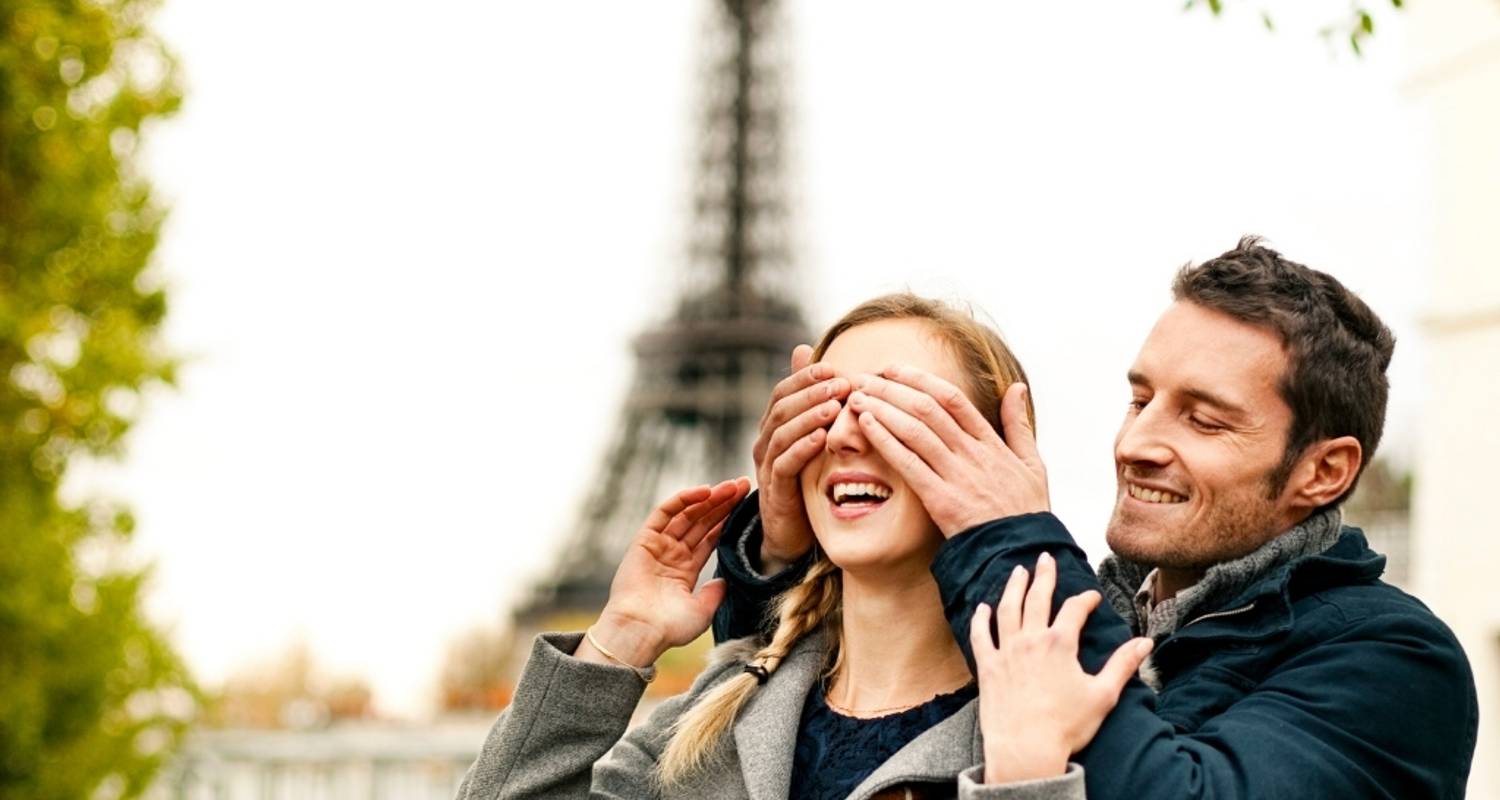
Tours & Trips to France Castles
- Choose from 6 France Castle tours
- 33 verified reviews from TourRadar travelers
- 24/7 customer support
6 tour packages to France Castles
Compiled by

Melissa France Castle travel expert at TourRadar
3-Day Guided Normandy : D Day Beaches, Mont Saint-michel And Loire Valley Chateaux From Paris (NBC3)
Loire valley castles, the crusader trail - cathar castles walk, castles of the loire valley - amboise to blois, loire valley classic - villandry to chambord castle tour, romantic france ( 8 days ).
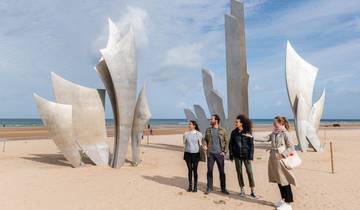
- Explore Normandy, St Malo and Mont St-Michel
- Discover the world-famous Châteaux of the Loire Valley from Paris
- Travel by luxury air-conditioned coach
“Was a great tour with a sampling of many sites.”
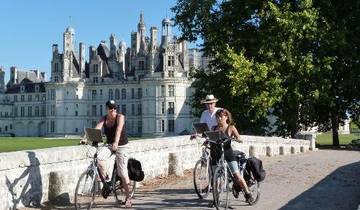
“The whole trip was excellent.”
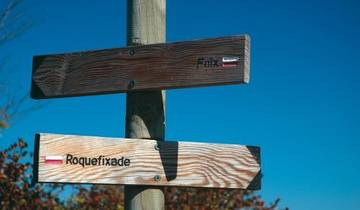
- Mountain Hikes

- Self-Guided Cycling
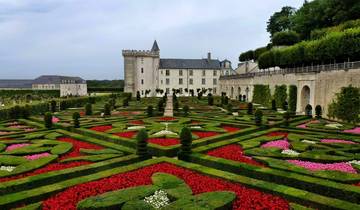
- In-depth Cultural
“We were not very happy with this to say the least. If we had at least ben close to downtown we could have gone to a nice restaurant and walked around.”
Travel Styles
Discover TourRadar
Culture Travel
12 Incredible French Castles & Chateaux You Must Visit
A visit to France isn’t complete without a tour of an extravagant French castle, known as a chateau . France has quite a few to offer. Gothic, Renaissance, and Medieval-style castles are all at a traveler’s fingertips. With tours about art, history, and gardens to wander, the French castle scene is one not to miss!
First things first. What’s the difference between a chateau and a castle? Even though the words are used interchangeably in English, there is a difference. In France, a chateau is considered private property, a manor, or a country house. A castle was used for more widespread purposes such as military defense or religious service.
In any case, many chateaux and castles are now open to the public to tour the lovely interiors and walk the grounds. Visiting a castle or chateau during a summer trip to France can give you an inside look at French history in one form or another!
French Châteaux
Here are the top French châteaux you must visit when in France! Many of these can be visited during a day trip from Paris .
Château de Chenonceau
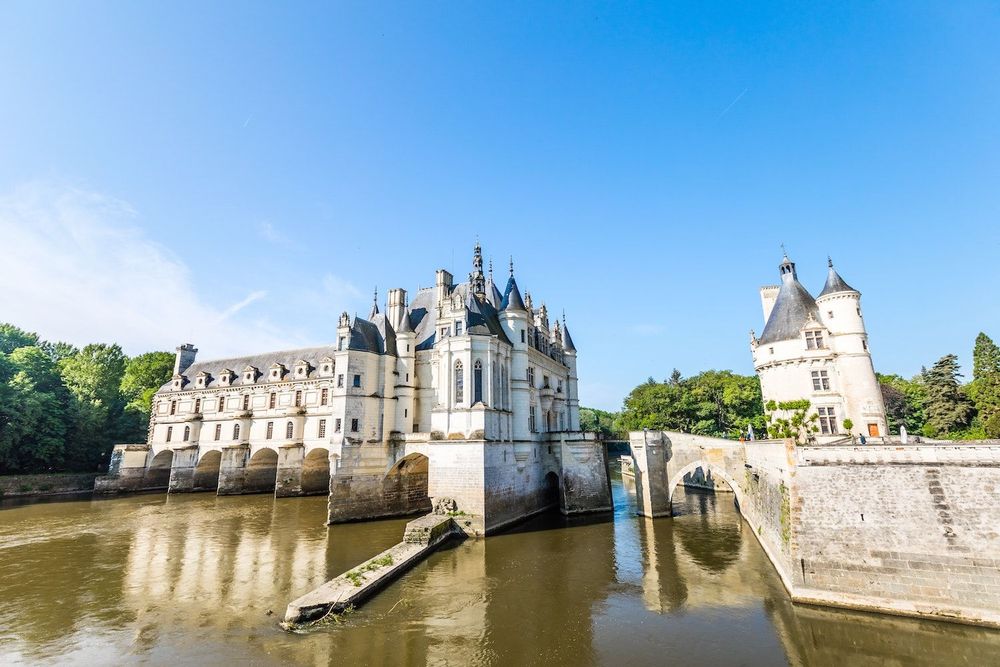
Located in the Loire Valley, the Château de Chenonceau is one of the most visited and photographed castles in France. In addition, the castle often referred to as the ‘ladies’ castle’ offers a unique perspective of women in French history.
The original building of the castle was commissioned by Thomas Bohier in 1512, however, the design was overseen and directed by his wife, Katherine Briconnet. With an original keep leftover from Medieval times, the castle primarily had a Renaissance style and interior under Katherine’s command. The castle ended up in royal hands when the monarchy demanded payment for debts.
While in royal possession, Henri II gifted the castle to his mistress, Diane de Poitiers. She added the iconic bridges that are one of the most beloved architectural aspects of the castle. However, peace was not to be hers in the estate. After Henri II died, his wife, Catherine de Medici forced Diane out of the castle and added her own touch.
She designed and built the gallery and ballroom that sit atop Diane’s bridge. The work, design, and additions of these three women, even when fueled by jealousy, have made Château de Chenonceau the architectural marvel it is today.
Visitors today can walk through the castle’s furnished rooms and imagine how its past occupants lived. The castle features exhibits about its history and the history of its owners. A cafe sits in Catherine de Medici’s gardens to provide coffee and treats to guests.
Château de Chantilly
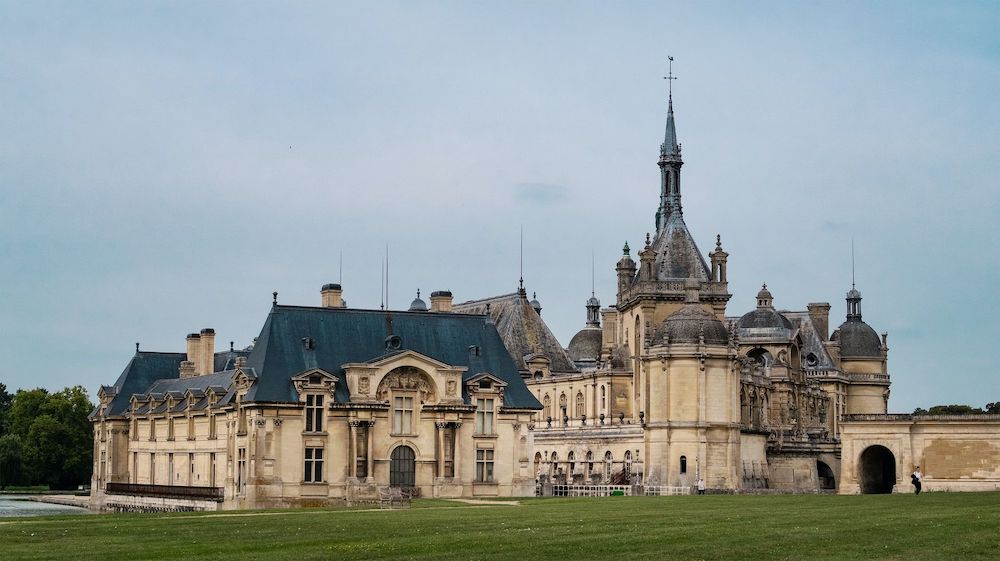
With gardens and art, Château de Chantilly is as much of an attraction to visitors today as it was to its designer, Henri d’Orleans, the Duke of Aumale, and son of King Louise-Phillip. Built in the 17th century, the palace was designed to show off. Here, the Duke displayed his collections of art and cultural artifacts. After being gifted to the Institut de France in 1866, the collection has grown so large it rivals the Louvre.
Visitors to Château de Chantilly can explore both gardens and the palace’s royal interiors. Ceremonial reception rooms, art galleries, private suites, and France’s most extensive library are all open to the public. In these rooms, visitors can connect with France’s greatest bibliophile and collector of his time.
The gardens offer rustic gardens, hamlets, and other treasures throughout. One of the garden favorites is the Temple of Venus, a French shrine to a Greek goddess. Streams and flowers cover the 115 hectares of garden space on the palace grounds. Tickets can be purchased on-site.
Château de Versailles
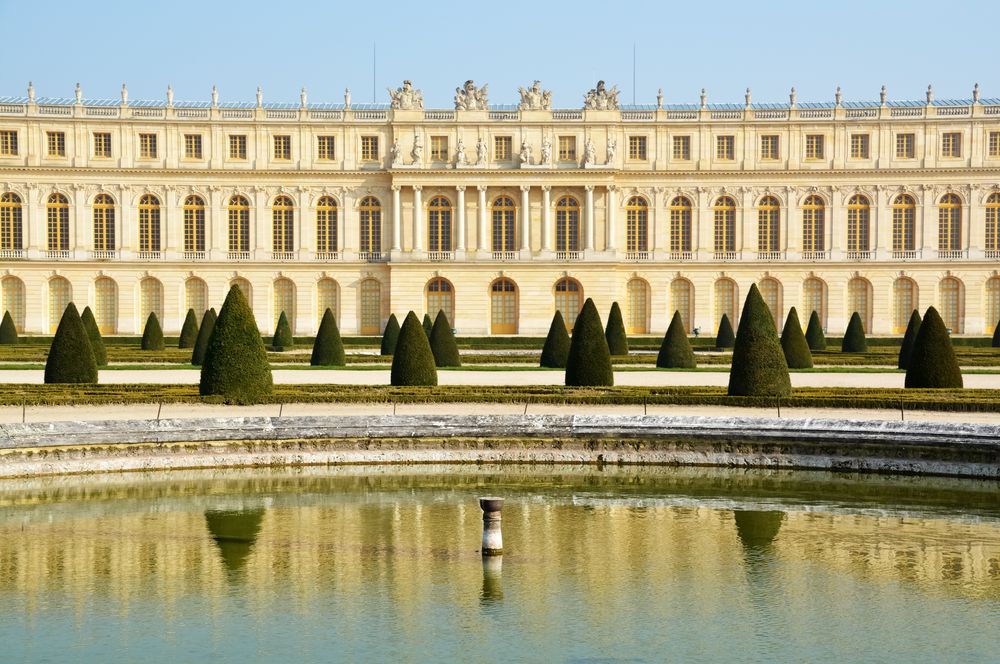
One of France’s, and Paris’, most visited sights is the beautiful Château de Versailles . Built in 1661, the palace was once home to King Louis XVI and his famous queen, Marie Antoinette. This is one of the most famous and well-known of the French castles and chateaux.
This castle gives visitors the opportunity to explore and experience the lavish lifestyles of the French aristocracy. Spread across 2,300 rooms, visitors can roam the royal suites (with a tour guide, of course!) and take in all of the beautiful architecture and interiors. Many tourists visit Château de Versailles just for the Hall of Mirrors, one of the palace’s most luxuriously designed rooms.
The interior isn’t the only attraction at Château de Versailles, The Grand Perspective, a promenade through the palace’s gardens, has been maintained and replanted every 100 years. This site is one of the most famous in Château de Versailles’ gardens and was designed in the 1600s by a team of architects and artists.
The palace became a museum after the French Revolution. As the Museum of the History of France, the palace began to house art collections and other artifacts from the revolution. Now, after it has been restored to its lavish beginnings, the museum serves as a reminder of the French aristocracy’s wealth and lifestyle.
Visitors must purchase a ticket to access any and all parts of the estate. A separate ticket and mandatory time slot must be booked in advance to access the interior of the palace. Tickets can be found on Château de Versailles’ website.
Château de Chambord
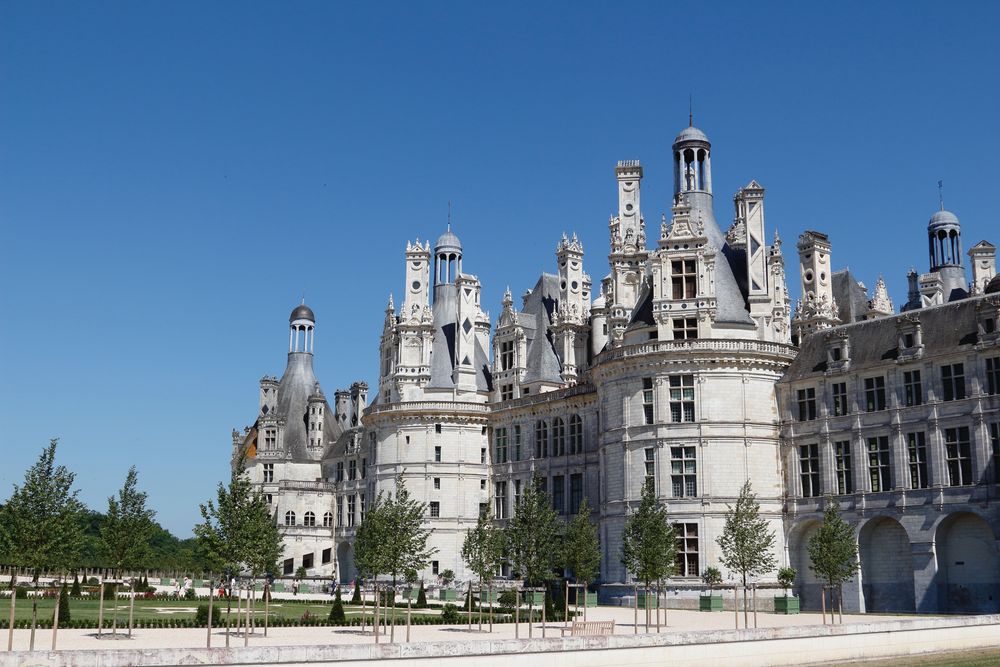
One of France’s most unique castles, Château de Chambord towers above its grounds with domed turrets dispersed throughout. Considered the Mona Lisa of architecture, Château de Chambord has been a marvel since its creation.
In 1512, King François I commissioned the castle’s construction in the Sologne marshlands. This castle was never a permanent residence for François I, but rather a show of his power and ode to Leonardo Da Vinci’s designs.
The castle is built around its central axis and the double helix spiral staircase. This ascends to the upper levels which are decorated with chimneys, terraces, and sculptures. François I never finished construction on the castle, leaving it to Louis XIV who resided for a time in the castle and completed the gardens surrounding the estate.
After the French Revolution, the castle fell into a state of neglect until the Duke of Bordeaux found it and resided there for a time. The castle was passed down to his sons until 1930 when the castle became the property of France.
Thus began work to restore the property to François I’s original Renaissance vision. This included demolishing the attics built by Louis XIV and restoring the interiors. In 1981, the castle was added to the list of UNESCO World Heritage Sites .
Visitors today can explore 60 of the castle’s rooms and wander the formal gardens and adjacent nature preserve. There are tours available and tickets can be purchased online.
Visits are suspended until September 10th, 2021 as the American series, The Serpent Queen is being filmed on the castle grounds.
Château de Vaux-le-Vicomte
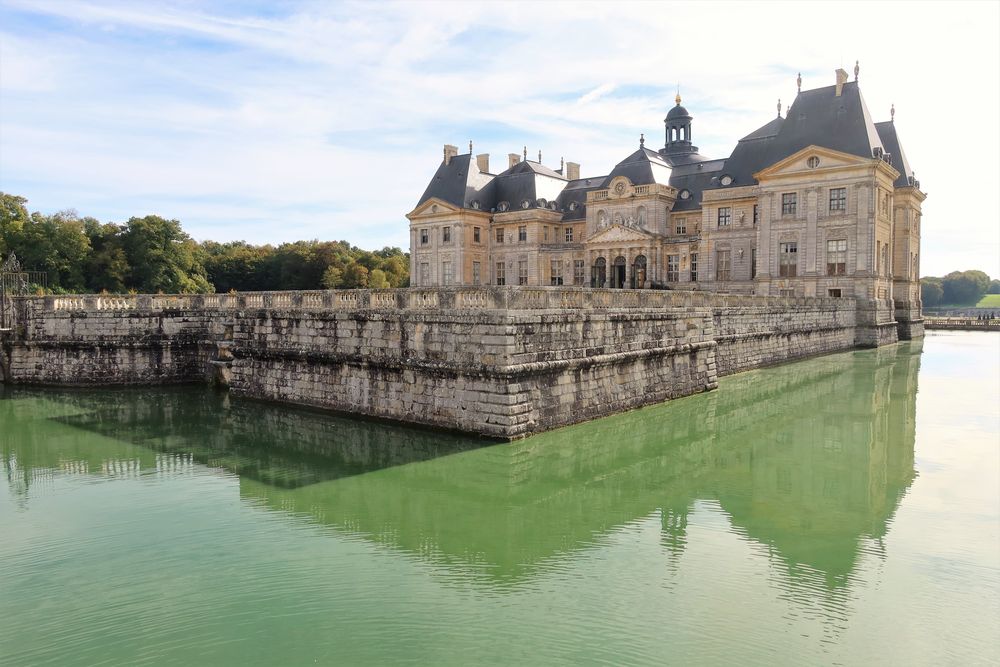
Château de Vaux-le-Vicomte began its succession of successful French aristocrats in 1641 when Nicolas Fouquet purchased the manor and its castle. Under his direction, the castle and grounds were transformed into a vision of luxury and grandeur. Fouquet brought on designers Louis Le Vau, Charles Le Brun, and André Le Notre to complete the project and make the castle and grounds an exhibit of natural harmony.
Unfortunately, in 1661 Fouquet was arrested and the castle and its furnishings, art, and other collections were seized by King Louis XIV. Fouquet’s wife eventually recovered the estate and lived on the property until her death. After this, the estate was sold again to Marshal de Villars.
The de Villars family occupied the estate for a few years, but the estate was sold again in 1764 to Duc de Prasin. A century later the estate was put up for auction and after spending 50 years abandoned and neglected.
Alfred Sommier bought the estate in 1881 and restored the castle to its former glory. His descendants continue this stewardship today maintaining the interiors, exteriors, and gardens.
Visitors today can walk the castle grounds, visit the carriage museum, or enjoy a candlelit dinner in one of the castle’s three fine-dining restaurants. Picnics in the gardens are another popular activity for visitors and tourists.
Reservations are required for candlelit dinners. Visitors can purchase admission to the grounds and reserve their spot for candlelit dinners through the castle’s website.
Château de Fontainebleau
The Château de Fontainebleau is another unique castle in France. Built in 1167, the Château de Fontainebleau predates the Château de Versailles by five centuries. Located on the royal game preserve, the Forest de Fontainebleau, the castle was passed down from king to king during Medieval times until the 19th century. Each year the kings would visit the castle for hunting season.
During these times, each king would commission France’s greatest architects to add new architectural additions. Due to this, the Château de Fontainebleau has become one of the best places to see France’s architecture and design evolve over the centuries. All of the artifacts and architecture have been restored or remain in their original state, allowing visitors to truly see an illustration of France’s cultural evolution.
Château de Fontainebleau also offers visitors a unique trip into Italian Renaissance design and art. After Henri II married Catherine de Medici of the Medici family, the couple commissioned frescos, sculptures, and the Salle de Balle ballroom from Italy’s most prominent painters, sculptors, and architects. The style added by Henri II and Catherine blended traditional French and Italian styles making the castle a unique place to experience both prominent 14th-century styles.
Located in the Loire Valley, Château de Fontainebleau is the less crowded version of the Château de Versailles and makes for a lovely afternoon of culture. Tickets can be reserved in advance online. There are also tickets available on-site at the ticket office.
Château Royal d’Amboise

Though Château d’Amboise is now an image of Renaissance style and French luxury, the castle began as a small manor on a vantage point of the Loire River used since the Neolithic times. Julius Caesar even visited the site and was impressed by the Amboise oppidum, the main settlement located there.
In the 400s the meeting of Clovis occurred and Château d’Amboise housed the Counts of Anjou after the Norman invasions. In 1214, the king of France moved into the castle and the Amboise-Chaumont family became the king’s vassals. This feudal relationship continued until 1431 when Louise of Amboise was condemned for plotting and conspiracy. Though eventually pardoned, the estate was seized by the Crown.
After the estate was seized by the Crown, additional buildings and wings were added as many kings used the castle as an escape to the Loire Valley. Charles VII was born in the castle in 1470.
During Charles VII’s reign and after his marriage to Anne of Brittany, the king decided to transform the castle into a Gothic-style palace. As the palace’s main architect, Charles VII made significant changes to the castle adding towers, ballrooms, a chapel, and calvaries. He also commissioned Flemish sculptors and Italian artisans to work on the palace and its interiors. By the time he was finished, the castle had 220 rooms. The king’s emblems and monogram and Anne of Brittany’s ermine are still visible on the walls of the castle.
François I, the designer of the Château de Chambord, grew up as a student in the Château d’Amboise. He added many of the Renaissance influences the castle exhibits today and often invited Italian artists and architects to the castle, including Leonardo da Vinci. Da Vinci was later buried on the property in the Chapel of Saint-Hubert. At this time the Château d’Amboise was the center of the French Court.
Henri I and Catherine de Medici often spent time at the castle, but after Charles IX and Henri II’s reign, the French kings stopped coming to the castle and it was no longer the center of French culture and courtship.
After this, the castle was used as a guest house for French sovereigns, a prison, a detention center during the French Revolution, and fell into neglect and ruin. Over this time parts of the castle were demolished, ransacked, or replaced.
In 1974, projects began to restore the castle and bring back some of the value it once held.
Visitors today can walk the castle grounds, visit Leonardo Da Vinci’s tomb, and learn of the centuries of history this castle has seen. Tickets can be purchased online on the castle’s website.
Château d’Ussé
Originally built in 1000, the Château d’Usse was first a Medieval stronghold of wood and stone. In the 13th century, Jean V de Bueil, a supporter of Joan of Arc, began construction to beautify the stronghold and turn it into the beautiful piece of architecture we see today.
Over the centuries the castle was passed down between French aristocrats and continually added to. In the 19th century, the Duke of Blacas and his family made residence in the castle. To this day, they still reside in the castle and manage its maintenance and preservation.
The most notorious aspect of the Château d’Usse was its inspiration to Charles Perrault, the author of The Sleeping Beauty. After visiting the castle he declared it a place of fairy tales and wrote his now-famous story.
Visitors can now step into this privately owned, fairytale property. With an admission ticket, visitors can explore 20 rooms of the castle, learn from the traveling exhibitions put up on the estate, and walk the gardens. Tickets can be purchased onsite!
Château de Cheverny
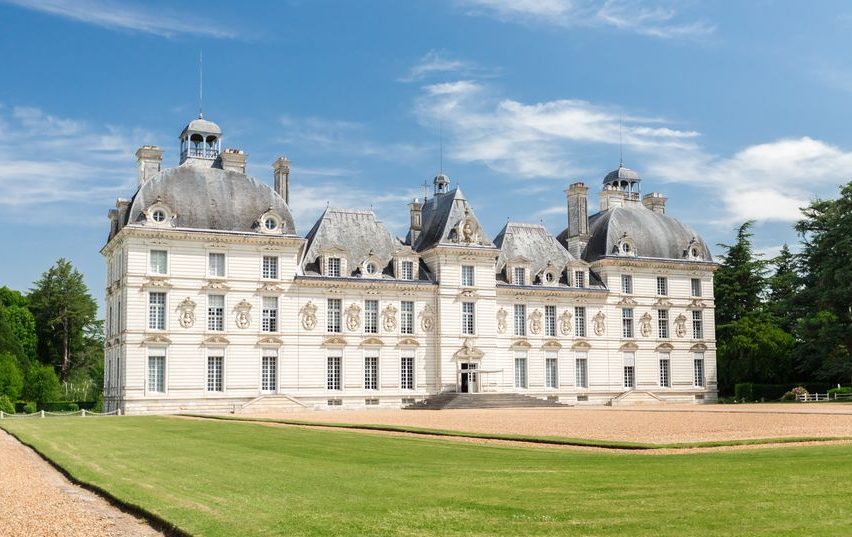
As one of the first private castles to open to the public, a tour of the Château de Cheverny and its grounds is unique. Owned by the Hurault de Vibraye family, the castle has been passed down through generations for six centuries. Originally gifted to the family for their financial services to the kings of France, the castle is a gift that has remained to the present day.
Modeled after the Luxembourg Palace, the castle was occupied for a short time by Henri I’s mistress, Diane de Poitiers, before she was ousted by Henri I’s wife, Catherine de Medici. Both of these women had some influence over the castle’s interiors and its classic French style.
Today, the Hurault de Vibraye family still lives in the right wing of the castle. The owners maintain and care for any restoration or preservation projects on the estate. They opened the castle to the public in 1922 in an effort to share its history and culture with as many people as possible.
The castle also inspired the setting of Herge’s Adventures of TinTin. Due to this the Herge Foundation has set up a permanent exhibit displaying Herge’s Mouslinart and provides an immersive experience into TinTin’s world. TinTin’s pup isn’t the only dog associated with the Château de Cheverny. The kennels house one hundred French tricolor dogs.
Visitors can explore the castle’s public exhibits, wander the estate’s gardens and forest, or visit the kennels. The castle is open most days of the year and tickets can be purchased online.
French Castles
These are the best French castles you must visit.
Château Comtal de Carcassonne

The Château Comtal de Carcassonne is not just known for its citadel, but also for being the largest European city with still intact walls. This Medieval castle has been a stronghold for France for hundreds of years and was even a battleground during the Crusades in 1209.
The castle is made up of single-story buildings and primarily showcases Roman and Gothic styles. Due to the castle’s location in France (the castle was originally in Spain), it has been substantially restored and preserved as a historic monument.
The castle still showcases Medieval defensive strategies with rings of walls containing slits for firing arrows at invaders. Though French royalty never inhabited this castle, its history and close connection to the Crusades make it a historical trip not to miss.
Visitors can access the castle grounds with a ticket admission to the museum. The museum offers historic exhibitions, battle reconstruction, military art, and more about this Medieval stronghold’s history. Tickets to visit can be purchased on site.
Palais des Papes
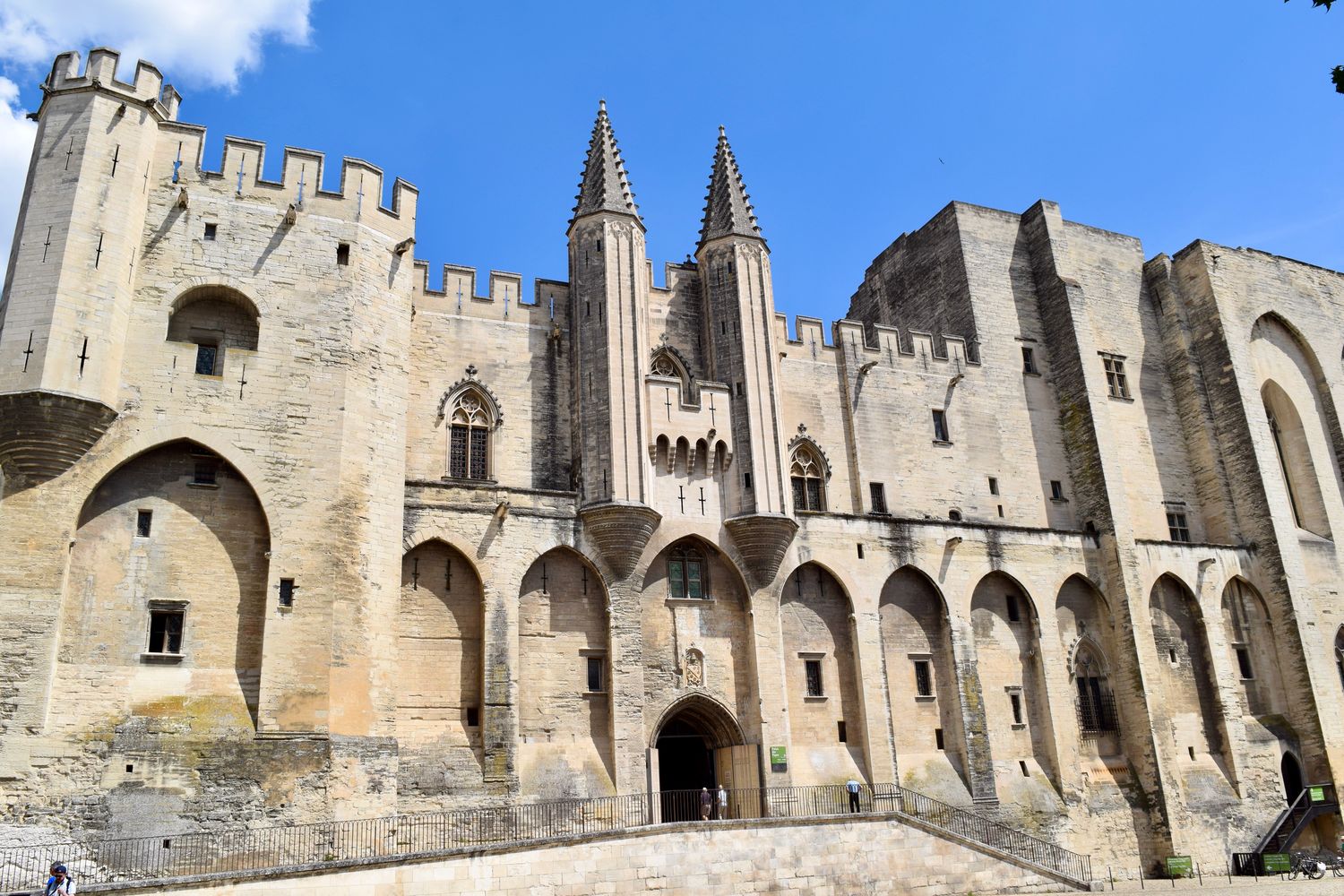
Palais des Papes , or “Palace of Popes,” was designed and built by two popes when Avignon was the center of European catholicism. It is the largest Gothic palace in Europe. The floor space alone takes up the same area as four Gothic cathedrals! Construction started on this castle in 1335 and continued for another 20 years under the direction of Pope Benedict XII and his successor Clement VI.
One of the most remarkable aspects of the Palais des Papes is the preserved frescos decorating the castle’s chapels and papal apartments. These frescoes were painted by a variety of French and Italian artists of the 14th century. The most prominent of these artists was Matteo Giovannetti.
After the French Revolution, the Palais des Papes was used as barracks until the early 1900s when it was opened to the public. Today, you can explore the castle’s interior and learn about its construction on a guided tour. In addition, each summer the Palais des Papes hosts a prominent art exhibit. During July, the palace hosts the Avignon Theatre Festival .
Mont Saint Michel

Mont Saint Michel may be one of France’s most famous sites and certainly one of Normandy’s finest. Perched atop a tidal island, the commune sits above a bay and has served as a pilgrimage destination for many years.
Though not quite a chateau or castle, Mont Saint Michel has the same feeling of magic as the homes of the French aristocracy, however, much of this magic comes from a legend.
In 708, Archangel Michael appeared in a dream to the Bishop of Avranches, St. Aubert. For three nights the archangel visited the bishop with one demand: to build a sanctuary atop Mont Tombe in his honor. Mont Tombe did not seem the ideal place to build a sanctuary as it sat on a rocky island above the sea. St. Aubert resisted and the Archangel burned a hole in the bishop’s forehead. The bishop followed through with the archangel’s demand in 709 when he built a church in his honor atop Mont Tombe.
200 years after the church was built, a monastery and abbey were added to the island along with tall walls that kept the city from the sea. Eventually, kings of France and other dukes contributed funding to the island and developed the commune into a place of learning and a center for pilgrimage. Now, the commune is a UNESCO world heritage site and a hot spot for tourists and locals alike.
Museums, restaurants, and souvenir shops line the cobbled streets of Mont Saint Michel. The abbey offers tours and visitors can explore the mudflats surrounding the island. At high tide, however, the castle is still surrounded by the sea thanks to the restoration and preservation projects happening in Mont Saint Michel Bay.
Visitors do not need tickets to explore Mont Saint Michel. Attractions, such as the abbey, do require ticketed entry, but those tickets can be purchased on-site. Visitors will also need to park on the mainland at Place de Navettes and take a shuttle to the island.
As you can see, there is a wide variety of French castles and chateaux to explore in France. From the Middle Ages to the 19th century, France has so much to offer in terms of stunning architecture!
We are travel writers and photographers around the world. Culture Travel is a place to discover unique cultural attractions and once-in-a-lifetime experiences.
Read These Next

Cafe vs Restaurant vs Bistro vs Brasserie in France

15 Best Classic French Novels Every Literary Nerd Must Read
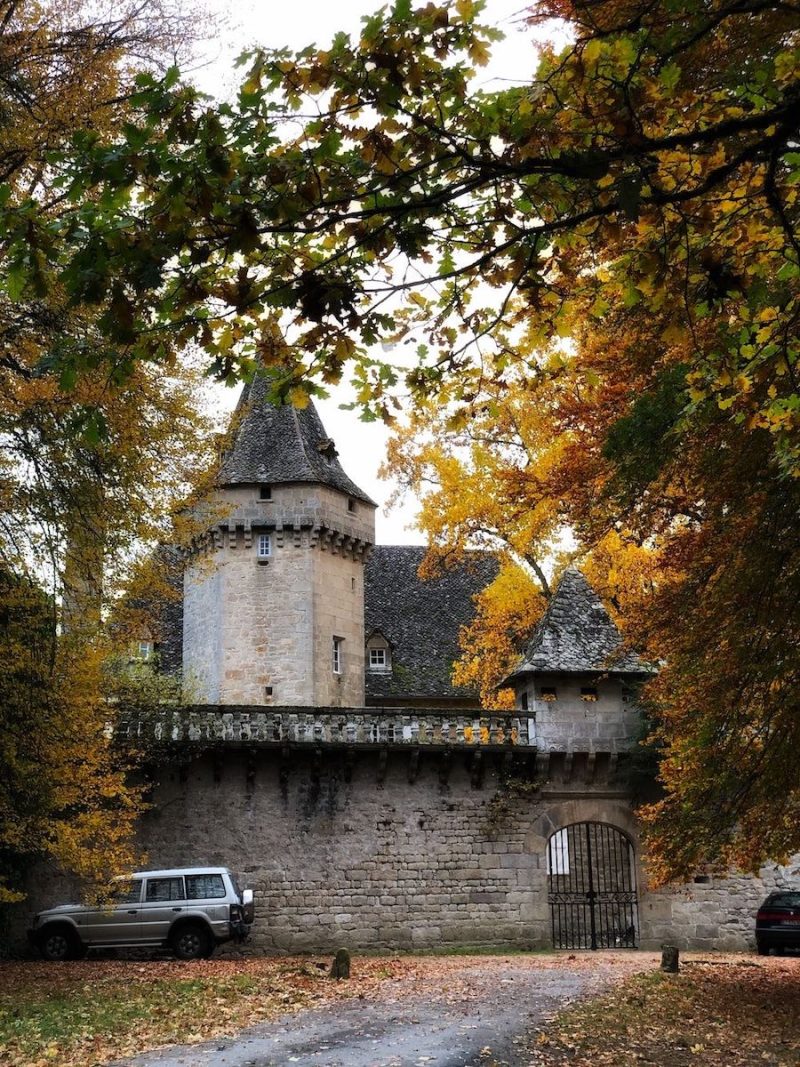
Fall in France Travel Ideas & Best Destinations

10 Best Cities to Visit in France (by a Local)

8 Charming Small Towns in France to Visit
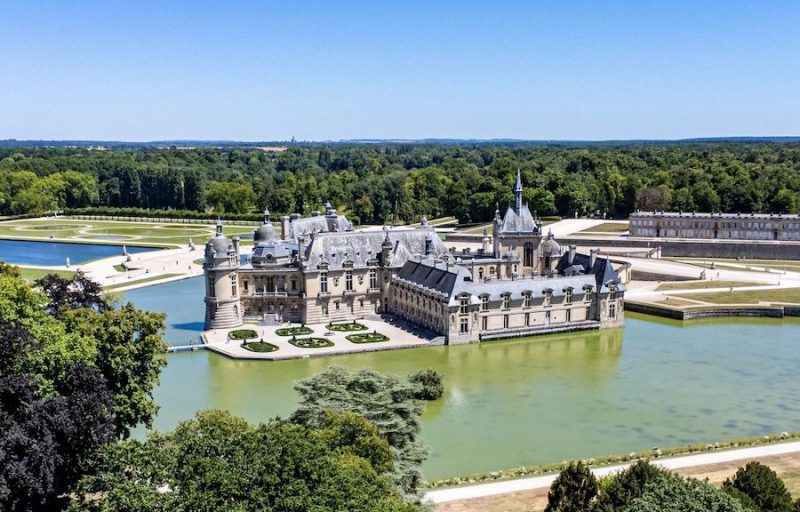
12 Interesting Things to Do in Northern France This Year
One Comment
You can add Chateau of Pierrefonds in your list ! One of the most beautiful and tallest chateau in France, with beautiful middle-age architecture, which deserve to be in this ranking.
Leave a Reply Cancel reply
Your email address will not be published. Required fields are marked *

8 Beautiful Châteaux in France You Can Visit—or Even Spend the Night In
Spending the day in fantastical splendor yes, please..
- Copy Link copied

Versailles is just as worthy of a visit for the gardens as it is for the château.
Andy Sutherland/Shutterstock
Thousands of châteaux across France have set a certain storybook aesthetic for centuries. Many of these sprawling estates were once reserved for nobility, with gilded interiors (Hall of Mirrors, anyone?) and turreted roofs, but today you don’t need royal lineage to experience a beautiful château. Simply clear your schedule, fork over 20 euros, and indulge in the regal luxury and history. Here are eight beautiful French châteaux to visit on your next trip.
1. Château de Versailles
- Where: Versailles, France
- When to visit: Open from 9 a.m.–6:30 p.m; palace is open year-round except Mondays and May 1
- Visit: Palace tickets start at €21, chateauversailles.fr
What King Louis XIII built as a hunting lodge 10 miles southwest of Paris , his successor, Louis XIV, and Queen Marie Antoinette transformed into a glittering, 721,182-square-foot palace—and symbol of French power: Château de Versailles . Today, visitors can tour magnificent rooms like the Hall of Mirrors, admire thousands of paintings and pieces of furniture, and wander the vast manicured gardens for a look at royal indulgence. As of 2021, guests can even stay the night, thanks to the opening of Airelles Château de Versailles, Le Grand Contrôle , a luxury hotel located within the Château de Versailles .
Versailles is open all year (except on Mondays and May 1), but the gardens are especially attractive on summer evenings when the fountains are illuminated. Tip: To beat the crowds, book a skip-the-line ticket in advance.

Château du Clos Lucé is famous for being Leonardo da Vinci’s final residence.
Photo by Léonard de Serres/Château du Clos Lucé
2. Château du Clos Lucé
- Where: Amboise, France
- When: Operating hours vary depending on the month; open year-round except December 25 and January 1
- Visit: Tickets start at €18, vinci-closluce.com
This stately brick manor house is famous for being the official and final residence of Leonardo da Vinci; it is located a quarter mile from the beautiful Château Royal d’Amboise , where the artist’s tomb lies. Besides an ornate interior with more than 800 years behind it, the château also has a 15-acre park that showcases 20 models of da Vinci’s inventions.

Château d’Azay-le-Rideau showcases early French Renaissance design and architecture.
Photo by Neirfy/Shutterstock
3. Château d’Azay-le-Rideau
- Where: Azay-le-Rideau, France
- When to visit: Operating hours vary depending on the month; open year-round except January 1, May 1, and December 25
- Visit: Full-price tickets are €11.50; tickets.monuments-nationaux.fr
The UNESCO-recognized Loire Valley is home to striking buildings and castles, including the two-story Château d’Azay-le-Rideau. Constructed in the 1500s, this château’s sharp roofs, turrets, and other features showcase early French Renaissance design and architecture. The château was originally built on an island in the Indre River by Gilles Berthelot, treasurer of France and adviser to King Louis XII.
While the stone-carved details (look for the salamander and ermine motifs, which symbolize King Francois I and Queen Claude, respectively) and open loggia staircase are captivating enough, take a step back to appreciate the building as a whole. A moat surrounds it, offering a reflection of the château.

The château and museum are reason enough to visit, but the beautiful estate and garden are reasons to stay and picnic.
Jessie Beck
4. Château de Chantilly
- Where: Chantilly, France
- When to visit: Open daily (except Tuesdays) from 10 a.m. to 5 p.m. It’s best to visit on a nice day, when you can take advantage of the large park and gardens.
- Visit : Tickets start at €18 chateaudechantilly.fr
The town of Chantilly, which is located about an hour north of Paris by train or car, is known for its strong equestrian heritage, the invention of Chantilly cream, and a beautiful, historic mansion called Château de Chantilly. Originally built for the Montmorency family in the 16th century and later enhanced by the Duke of Aumale, the château today is a public museum and garden. It’s easy to spend a full afternoon here, thanks to the exquisite art collections within the Musée Condé, and the beautiful gardens and park (both included with entry) adjacent to the main house. Come hungry: there’s also a small cafe and restaurant tucked away in one corner where you can try the region’s most famous dessert, Chantilly.

Don’t just visit for the day—spend the night in a château at this property just north of Paris.
Photo by Jessie Beck
5. Château de Maffliers
- Where: Maffliers, France
- When to visit : Year-round, though it’s best to visit in spring, summer, or fall to take advantage of the outdoor activities.
- Book now : demeures-de-campagne.com
If you want to turn your day trip into an overnight, pair your visit to Chantilly with a stay at another, smaller château nearby called Château de Maffliers, Demeures de Campagne . Renovated in 2020, this 19th-century home turned hotel gives travelers the chance to spend the night in a historic French mansion, complete with ornate, over-the-top decor like velvet sofas, chandeliers, and marble bathrooms. The decadence extends to the hotel’s fine dining restaurant, Augustine, where diners can indulge in regional classics like roast duck, pâté, and fresh strawberries with Chantilly cream. Guests also won’t want to miss the chance to experience the region’s renowned equestrian heritage by going on a morning horseback ride with the property’s on-site horseback riding school.
Note: Be sure to book a suite to snag a room in the château. There is also a more basic hotel called Novotel on the property in a separate building.

The Château de Valençay’s architecture is mainly influenced by Renaissance and classical styles.
Photo by Joaquin Ossorio Castillo/Shutterstock
6. Château de Valençay
- Where: Valençay, France
- When to visit: Opening times vary depending on month; open year-round except December 25 and January 1
- Visit: Tickets are €14.50; chateau-valencay.fr
With its L-shaped layout, the Château de Valençay’s two wings demonstrate the main architectural influences—Renaissance and classical—on its design. The d’Estampes family created the foundation for the Château de Valençay in the 1500s with a very Renaissance flavor (thanks in part to the influence of the Great Italian Wars ). In the 1700s, the west wing was modified in the classical style, as seen by details like its Ionic capitals.
Since the château’s creation, it’s changed hands with many different owners from the upper echelon—most famously Charles Maurice de Talleyrand, who was the foreign minister to Napoleon. Many of the interior relics you can see come from Talleyrand’s collection of swords, medals, and other treasures.

Live out your Sleeping Beauty dreams at this château.
Photo by Sergio da bosco/Shutterstock
7. Château d’Ussé
- Where: Rigny-Ussé, France
- When to visit: Opening hours depend on the month; open from February 13 to November 13
- Visit: Adult tickets are €14,50; chateaudusse.fr
While many châteaux have a storybook appeal, the Château d’Ussé has a special claim to fame as the inspiration for the original Sleeping Beauty . The fun is in the very ornate details, from the intricately designed ceiling of the guard room to the 16th-century tapestries decorating the walls. Visitors (particularly children) will delight in the mannequins displayed in its various rooms that re-enact scenes from the classic story.
Even if you’re not a fan of the fairy tale, there’s plenty to enjoy here. Walk through the ramparts of the château’s towers, and you can reimagine a time when the building was used as a strategic fortress circa 1000 C.E.

The different architectural styles of the Chateâu Blois make its details all the more appealing to explore.
Photo by Yuri Turkov/Shutterstock
8. Château de Blois
- Where: Blois, France
- When to visit: Opening hours vary depending on the month; open year-round, except December 25 and January 1
- Visit: Chateau + Sound and Light Show tickets are €21; chateaudeblois.fr
Unlike many châteaux, the Château de Blois isn’t a shining example of a particular architectural era or influence. Instead, this Loire Valley palace is recognized for being a hodgepodge of medieval, Gothic, Renaissance, and classical architecture, due to it frequently being torn down and renovated. As a result, each part of the exterior serves as a marker for the popular architectural style during a renovation, including the château’s iteration as a 13th-century fortress and the Renaissance-style home of King Louis XII.
From April through September, the château’s exterior becomes the backdrop of a sound and light show portraying its complex history, offering a modern way to experience the chateau’s past.
This article was originally published in 2019 and was most recently updated on February 12, 2024. Kimberley Lovato and Jessie Beck contributed reporting.


YOUR CHOICES
Taking time to unwind with family and friends to enjoy new places and experiences is an important part of life. One of the best places in the world to do this is the Bordeaux wine region of South West France, with its renowned wine, idyllic vineyard landscape, historic villages and châteaux, a World Heritage city, broad rivers and seaside, too. Château Living all-inclusive french chateau vacations combine the best of these ingredients to create experiences which are always extraordinary!

All-inclusive French Chateau vacations in Bordeaux, France
Whether a long weekend, a seven day getaway or a two week vacation, we offer a range of themed packages that include:
Private luxury transfers to & from your château A personal welcome from our hospitality team Signature breakfasts each day Private dinners & lunches prepared by your own chef A choice of amazing experiences to suit you
If your passion is for French cooking and cuisine, savouring the local wine or a vacation centred around golf, we have something to suit your taste.
Exquisitely presented, these French masterpieces are private château in wine-producing vineyards, set among their own vines, producing wine you can enjoy during your stay. Add a swimming pool and tennis court and you have the perfect recipe for the ideal vacation retreat.
YOUR CUVÉE OPTIONS
Long weekends.

- Become a Member
26 French Châteaux You Have to Visit in 2023
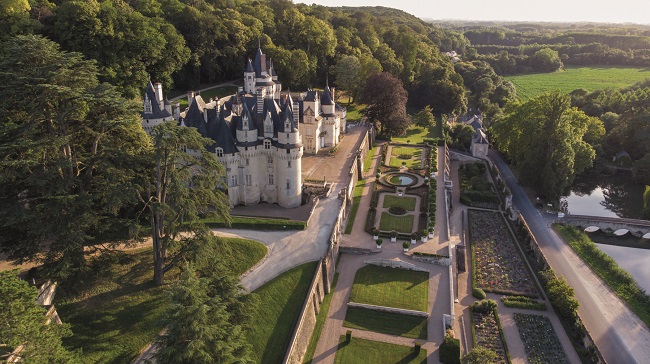
No other country can boast as many well-preserved castles and country houses as France. Step back in time and immerse yourself in beautiful gardens and architecture: from the riverside beauties of the Loire Valley to the fairy tale castles of Alsace to the hilltop forts of the southwest, there are hundreds of châteaux available for visits across France, offering an intriguing glimpse into the life, culture and decadence before the Revolution.
Châteaux to visit
Indulge your love of architecture and interiors as you wander in awe around these beautiful châteaux. And if you’re lucky, a bit of French aristocracy might rub off on you.
Château Royal de Blois , Loir-et-Cher Architecture from the 13th to the 17th centuries is on display at this fine château in the Loire Valley . There are four distinct wings surrounding a central courtyard: medieval, Gothic (from the reign of Louis XII), early Renaissance and classical 17th century. Steeped in history, the château has witnessed some pretty grisly episodes. The grisliest of all was in the 16th century when King Henri III lured the Duke of Guise into his counsel chamber only to have him stabbed to death by a troop of royal bodyguards. The king himself hid behind a tapestry while the evil deed was carried out. Between April and November, dramatic sound and light shows are put on in the château courtyard. en.chateaudeblois.fr
Château de Pierrefonds, Oise First built in the late 14th century by Louis of Orleans, this awe-inspiring castle lay in ruins for much of its existence until Napoleon III commissioned the famous architect Eugène Viollet-le-Duc to restore it to its medieval glory. The result is a vast eight-towered château straight out of a fairy tale, complete with drawbridge, gargoyles and dungeon, all surrounded by the thick Compiègne Forest. Open 9.30am–6pm daily from June 13 to September 4, and 10am–5.30pm from September 5 to April 30. www.chateau-pierrefonds.fr/en
Château de Compiègne, Oise Built for King Louis XV and restored by Napoleon, this château, 85km north of Paris , used to be one of the three seats of royal government. Its proximity to the forest and hunting grounds of the same name made it the preferred summer residence of French monarchs for many centuries. There is a huge amount to see here, including the park, the château apartments themselves, the Musée du Second Empire, the Musée de l’Impératrice, and the Musée National de la Voiture, which boasts a superb collection of cars, carriages and bicycles. It’s open most days of the year, with free entry on the first Sunday of the month. chateaudecompiegne.fr
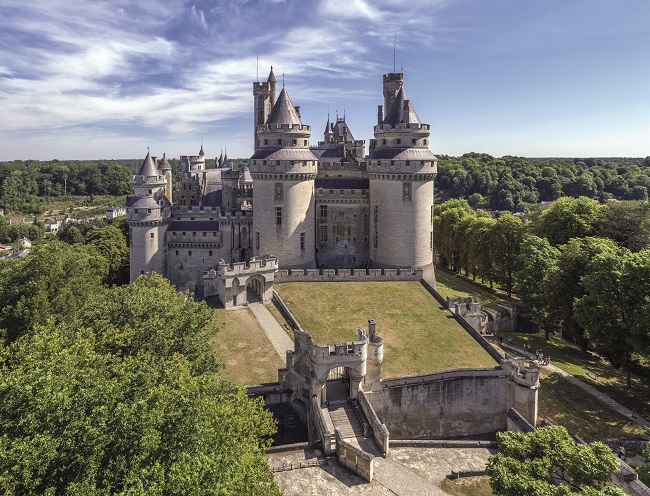
Château de Pierrefonds © © Christian Gluckman / Centre des monuments nationaux
Château de Château-Thierry, Aisne “A gem of medieval defensive architecture,” is how the local tourism office describes this ancient castle, dating back to the 13th century. There’s falconry, a rose garden with 50 or so different varieties, and the remains of what it claims were “the largest medieval kitchens in Europe”. It’s open all year round and is free to visit. www.chateau-thierry.fr
Château de Condé-en-Brie, Aisne “The castle has a real sense of authenticity, with many original paintings and interior features,” say the owners. “Its sparkling history, its bedrooms, its boudoirs and its salons are straight out of a fairy tale – all easily discovered and shared with the whole family.” There’s also a treasure trail in the surrounding parkland. The château is open from April until November. Entry prices start at €12 per person. www.chateaudeconde.fr
Château d’Amboise, Indre-et-Loire Sitting atop a rocky outcrop on the southern bank of the Loire, the Château d’Amboise comes alive when you learn of the famous historical characters who once lived (and died) here. In the late 1400s, while on his way to watch a game of real tennis, King Charles VIII bumped his head on a door lintel, fell into a coma and died hours later. More violent was the fate of a band of Protestant conspirators who, in the 1500s, were disembowelled and hanged from the balcony of the château’s Salle des États. Mary, Queen of Scots once lived here too, as did Leonardo da Vinci, whose remains are believed to be buried in the nearby chapel of St Hubert. (Access to the chapel interior is limited.) www.chateau-amboise.com
Château de Beaugency, Loiret The highlight of this château in the Loire Valley is its centre dedicated to digital art. For 2023, the central exhibition is an immersive show of Vincent Van Gogh’s famous work, La Nuit Étoilée (Starry Night). “Travel through a luminous, digital universe where medieval and Renaissance architecture is revealed through beams of light and pixilation,” invite the curators. The show takes between an hour and 90 minutes to drink in, and runs throughout the château’s 19 rooms and the adjoining gardens. Open from April to December. www.chateau-beaugency.com

Château d’Amboise © David Darrault
Château du Haut-Koenigsbourg, Bas-Rhin Perched on a forested promontory in the Vosges mountains and constructed from bright red sandstone, this Alsatian château stands out for miles around. Although no one is sure when it was built, it’s certain the vast structure was an important outpost during the Middle Ages. By the 1600s it had been abandoned and wasn’t rebuilt until the German Kaiser Wilhelm II took an interest at the beginning of the 20th century. Over the years many film directors have been inspired by the castle, including Jean Renoir (for La Grande Illusion) and Peter Jackson (for The Lord of the Rings). Today it is a major tourist attraction, open all year round, and drawing in half a million visitors a year. www.haut-koenigsbourg.fr/en
Château de Meung-sur-Loire, Loiret With original construction dating back to the 12th century, this former castle and episcopal palace in the Loire Valley was captured from the English by Joan of Arc in 1429. Nowadays it makes for a wonderful family day out with attractions and activities such as a mini-farm, historical enactments, a paddock of deer and a dragon’s lair. The château opens for the season on April 8, with tickets priced €12 for adults, €8.50 for childen. chateau-de-meung.com
Château d’Herouville, Val d’Oise Elton John, Pink Floyd, Joan Armatrading, T.Rex, Cat Stevens, Iggy Pop, David Bowie, Bee Gees, Fleetwood Mac… this château north of Paris has hosted rock and pop royalty over the years thank to its famous recording studio. Here’s Jerry Garcia, the lead singer of the American band The Grateful Dead, recalling a gig his band played there in the early 1970s: “We played to a handful of townspeople in Auvers. We played and the people came – the chief of police, the fire department, just everybody. It was an event and everybody just had a hell of a time, got drunk, fell in the pool. It was great.” Contact the château direct for visiting options. And don’t fall in the pool. www.lechateaudherouville.com
Château de Fougères, Ille-et-Vilaine One of Europe’s largest châteaux, Fougères has been around in one form or another for 1,000 years or so. Naturally protected by amarsh and the River Nançon, it features a dozen impressive towers, as well as inner courtyards and gardens, all encircled by ramparts – perfect for holding out when under siege by the invading English. For visitors, this Breton château offers an intriguing glimpse into what life was really like in the Middle Ages. Open most of the year, except for January. chateau-fougeres.com/fr
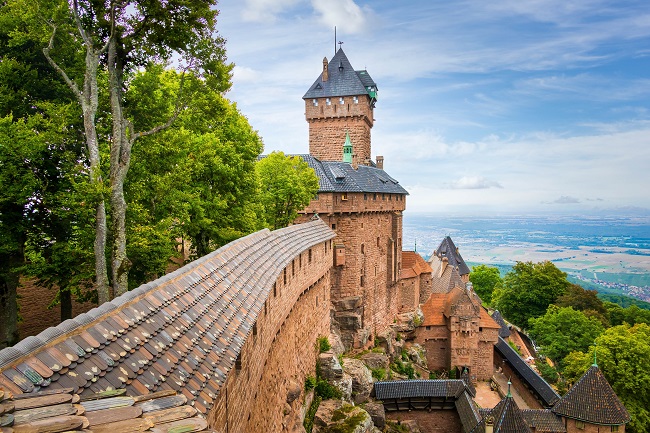
Château du Haut Koenigsbourg © jyanlun / shutterstock
Château de Joux, Doubs Standing sentry high above the valley, surrounded by jutting cliffs and forests, this brooding fortress in the Jura Mountains looks like a backdrop from The Lord of the Rings. A century in the making, it was built to defend important trade routes through the valley, although it wasn’t always a stronghold. During the 18th and 19th centuries it served as a bleak state prison, its most famous inhabitant the Haitian revolutionary Toussaint Louverture, who died here in 1803, having spent eight months behind bars. www.chateaudejoux.com
Château de Fontainebleau, Seine-et-Marne There are no fewer than 1,500 rooms in this opulent château just 34 miles from Paris, most of them adorned with beautiful paintings, tapestries, frescoes, carvings, fireplaces and furniture. At one time even Leonardo da Vinci’s Mona Lisa hung here. The human residents who called it home over the centuries are even more impressive, and include kings, queens, emperors and World War II generals. Beyond the château walls, the 130 hectares of parkland and gardens – partly designed by André Le Nôtre – are suitably resplendent. Open all year round. www.chateaudefontainebleau.fr/en
Château de la Hunaudaye, Côtes-d’Armor This medieval fortress sits in a tranquil corner of northern Brittany . As with most castles built in the Middle Ages, it was created to defend – in this case, the eastern border of the Penthièvre territory. Sadly, the château was reduced to rubble in a civil war, before a heroic revival in the late 1300s which saw the introduction of its trademark circular towers. Eventually, at the tail end of the 15th century, it became a symbol of the Tournemine family’s new-found power and status, cementing itself as a prestigious regional landmark. (Open daily from April 1 to September 17; and from October 21 to November 5.) www.la-hunaudaye.com
Château de l’Islette, Indre-et-Loire “Through the trees in the distance, I see the tortuous course of the Indre, and an ancient château, flanked by towers,” wrote the playwright Pierre Beaumarchais in 1769 of this château which overlooks the River Indre. Indeed, the first thing you’ll notice is the castle’s captivating beauty: the glowing white limestone, the flower-bedecked walkways, and reflections dancing on the surface of the moat. But there’s more to this leafy Loire Valley oasis than meets the eye, as it also once hosted legendary sculptors Camille Claudel and Auguste Rodin , who conducted their tempestuous love affair here in the late 1800s. Open every day from May 1 to September 30, and all year round for groups with reservations. www.chateaudelislette.fr/en
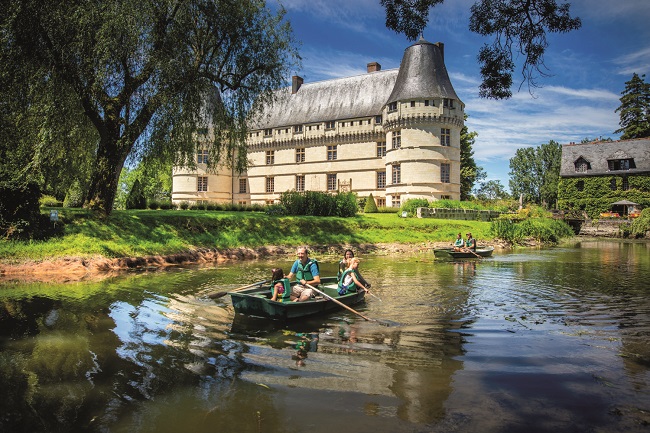
Château de L’Islette © David Darrault
Château de Guédelon, Yonne This château is entirely different from all the others featured here in that it hasn’t actually been built yet. Deep in a Burgundy forest, just over 100 miles south of Paris, it’s an architectural and archaeological experiment where all the builders are constructing a genuine 13th-century castle using only medieval tools and methods. No modern cranes or lorries or electric tools on this building site. As far as possible, all the craftsmen and women here both work and dress exactly as their ancestors would have 800 years ago. Wearing woollen smocks, there are quarrymen hewing rocks out of the ground; stonemasons tapping away with their chisels; carpenters hand-sawing trees cut from the local forest by lumberjacks; blacksmiths forging the iron tools; tilers digging clay from the ground nearby and firing it in ovens; and carthorses transporting all these materials around the site. The whole project aims to rediscover the secrets of medieval architecture and to teach modern builders how to work with traditional tools and materials. Visitors are encouraged to engage with the builders while they toil away, rather like an interactive theme park. Construction on Guédelon started in 1998 and isn’t due to finish until 2030 at the earliest. This year it’s open to time-travelling visitors from April 1 to November 5. www.guedelon.fr
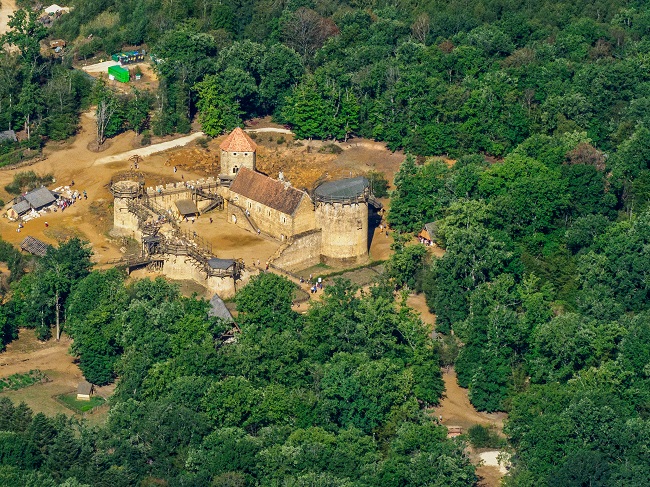
Guédelon castle © Francois Boizot / shutterstock
Glorious châteaux gardens
In some châteaux the gardens can be just as impressive, if not more impressive, than the building itself. Manicured flowerbeds, tree-lined walkways, moats and garden festivals… you can enjoy all these and more.
Château du Clos Lucé, Indre-et-Loire In the early 1500s, a certain Leonardo da Vinci spent three years living in this Loire Valley château. At one point his most famous painting, the Mona Lisa, was stored here and it was here, in May 1519, that the great man died, in the arms of King Francis I, or so the story goes. Nowadays the château rooms have been turned into a museum dedicated to the legendary genius. Outside in the château grounds are interactive displays of some of his greatest engineering inventions. “As you walk, you meet Leonardo the engineer, Leonardo the visionary and Leonardo the painter and architect,” a château spokesperson explains. “In the park, climb aboard the assault chariot, action the aerial screw, manipulate the multi-barrelled gun, sail on the paddle boat and walk on the revolving bridge and the 20m-high double-span bridge, all crafted the original way.” It’s fascinating stuff. vinci-closluce.com
Various châteaux in Val d’Oise The Val d’Oise department, just north of Paris, has some of France’s most stunning châteaux. These include the Château de La Roche-Guyon, uniquely set into the chalk cliffs behind it and featuring a medieval dungeon; the Domaine de Villarceaux, an 80-hectare property in Chaussy (free entry, open Tuesday to Sunday); the Château d’Auvers, with its stunning Impressionist paintings (open Tuesday to Sunday, €12); Château d’Ambleville, built in the Renaissance style with Italian-style gardens (open summer only); and Château d’Écouen, with its Renaissance museum (open Tuesday to Sunday, €5).

Le Clos Lucé © Video Media Studio Europe / shutterstock
Château d’Ussé, Indre-et-Loire Shielded from the outside world by the thick Chinon forest, the Château d’Ussé was the inspiration for the Charles Perrault fairy tale Sleeping Beauty. And when you view its Gothic turrets, soaring chimneys, grand staircases and sumptuous interiors, you quickly realise why. The pièce de résistance, however, is the terraced garden designed by André Le Nôtre, the brains behind Palace of Versailles’ landscaping. Le Nôtre aimed to bowl over visitors by playing around with symmetry, geometrical shapes and perspective, and by adorning his gardens with fountains, ornamental lakes, fruit trees, flower beds and cedars. The results are stunning. Just be sure to remember what happened to Sleeping Beauty, though: don’t prick your finger. The château is open from February 11 to November 5 this year. There’s also a fashion exhibition, called Telle mère, telle fille (Like mother, like daughter), which rather intriguingly explores the way in which parents control their children’s choice of clothing. www.châteaudusse.fr
Château de Chantilly, Oise Henri d’Orléans (1822–1897), son of Louis-Philippe, the last king of France, was a passionate collector, ensuring the Château de Chantilly became a stunning showcase for his countless masterpieces and precious manuscripts. In 1886 he gifted the château to the Institut de France and nowadays this fabulous site – just 40km north of Paris – includes the Condé Museum and is open to the public every day except for Tuesdays. Tickets cost €9 for the grounds alone, and €17 for the château and grounds combined. chateaudechantilly.fr
Château de Villandry, Indre-et-Loire Above all else, the Château de Villandry is famed for its gardens, a meticulous network of tidy box hedges, fragrant herbs and vibrant flowers. Smartly planted, they offer a multi-coloured feast, whatever the time of year, thanks to their seasonal plants and vegetables: in autumn, you can soak up the hues of orange, red and purple, while in high summer you’ll experience dazzling greens and hot pinks. The interior is also a sight for sore eyes, with gorgeous Renaissance décor and rooms laid out in splendid 16th century-style. The gardens are open every day of the year, even Christmas Day, while the château itself is open from February 4 to November 12, and December 2 to January 7. www.chateauvillandry.fr/en
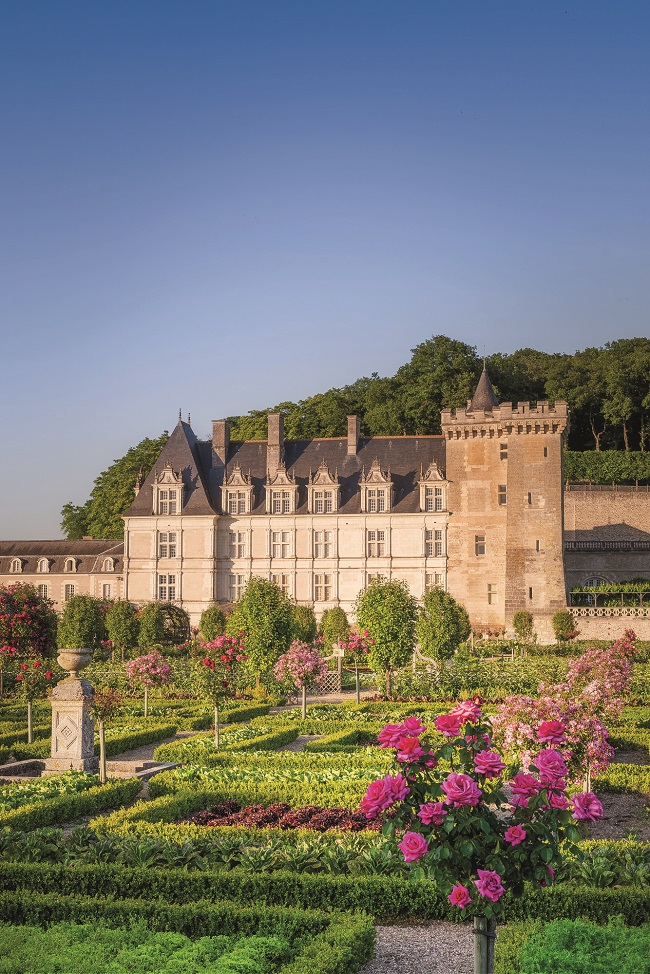
Château de Villandry © Jean-Christophe Coutand
Château de Hautefort, Dordogne The interior of this neoclassical château in the Périgord is impressive enough. The exterior, though, will take your breath away. First up is the three-hectare French garden, with its parterres, consisting of geometrical boxwood hedges, bright flowerbeds and yew topiary. Beyond this are the organic vegetable garden and a 30-hectare English-style park with a network of woodland paths and some remarkable tree species. The château is open every day from April to November. www.chateau-hautefort.com
Château de Chenonceau, Indre-et-Loire Looking like it’s almost floating above the River Cher, this château, with its stylised moat, turrets, towers and drawbridge, is a veritable beauty. However, it’s the 70 hectares of landscaped gardens and lush forest rather than the tourist-heavy interiors that are most interesting. On either side of the river you can visit the gardens of Diane de Poitiers, Catherine de’ Medici, the Jardin Vert, the yew maze, or the vast flower garden. Both the château and the gardens are open every day of the year (even Christmas) which, as everyone knows, is a rarity in France. www.chenonceau.com
Château de Versailles, Yvelines Undoubtedly the most famous château in France (possibly even on the planet), Versailles served as the political capital and seat of the royal court from 1682 until revolutionaries dragged off Louis XVI and Marie Antoinette to face the guillotine. To avoid getting overwhelmed by a sea of other tourists, head for the wonderful 800-hectare Parc de Versailles where you can enjoy vast, manicured, formal gardens populated by endless statues and water features, the English-style Jardins du Petit Trianon, the Orangery, the Grand Canal where rowing boats are available to hire, and the Lake of the Swiss Guard. Without a doubt, you will be amazed. www.chateauversailles.fr
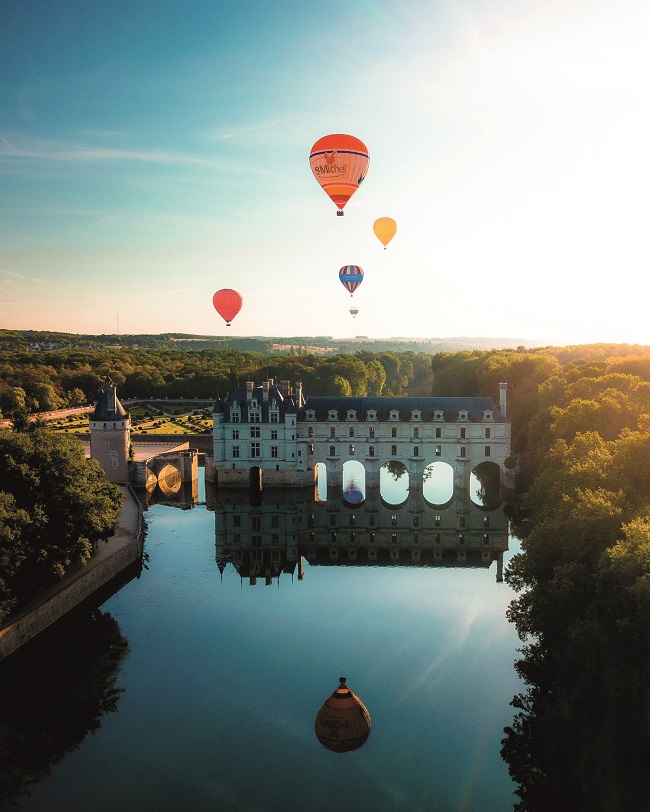
Château de Chenonceau © Paul Rivas
Maison du Berneuilh, Gironde This 80-hectare family estate is just half an hour south of Bordeaux within the Entre-deux-Mers vineyard region. “The wines from these sunny plateaus have always been sought after for their exceptional quality,” say the owners. “It is one of the rare cellars to have so many vintages.” The family prefers to “vinify in the old way”, allowing the lees to rest for at least five years. Also available are lovely local walks, workshops, tastings (of course) and cellar visits. www.facebook.com/chateauduberneuilh
Vignobles Jade, Gironde Right among the vineyards of Saint-Émilion, Château Fleur de Lisse is a family estate where the owner, Caroline Teycheney, offers tastings, workshops and other events at her Vignobles Jade. The tours range from a basic wine tasting lasting 45 minutes (for €7 per person) to the Jade Experience, which includes a two-hour visit to the vineyard, cellars and ageing room (for €50 per person). There’s also an excellent wine bar. en.vignoblesjade.com
Lead photo credit : Château d'Ussé © Renaud Whoisreno Loeuillet
Share to: Facebook Twitter LinkedIn Email
More in chateau gardens , chateaux in France , French castles , French gardens , most beautiful castles in France
Related Articles
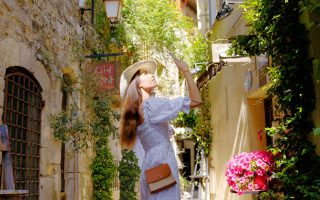
10 Reasons to visit Mougins food festival

The Ultimate Family Trip in Vendée
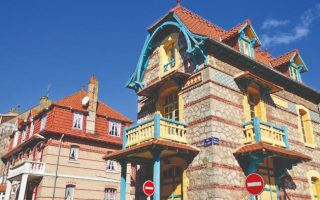
The Enduring Seaside Charm of Le Touquet
By dominic bliss, leave a reply.
Your email address will not be published. Required fields are marked *
Important Cookie Information
We collect information from our users – this is for administration and contact purposes in connection with contributions you may wish to make to the site or your use of certain site features such as newsletter subscriptions and property enquiries.
Best Chateaux in France – Castles in France to Visit
Article written by Elisa This article may contain compensated links. Please read disclaimer for more info.
Beautiful Castles in France
Are you looking for beautiful châteaux to visit in France? In France , there are stunning châteaux everywhere, and there’s something for every taste, from medieval castles to Renaissance châteaux surrounded by manicured gardens.
We have rounded up the list of the best châteaux in France, including famous châteaux in France and hidden gems worth exploring. In this list, we have tried to cover all the French regions and different architectural styles. Because ruins can be just as beautiful as flawless palaces, the list also includes a couple of crumbling castles.
Here’s the list of best castles in France in no particular order, with a map to help you pinpoint all these fabulous French castles.
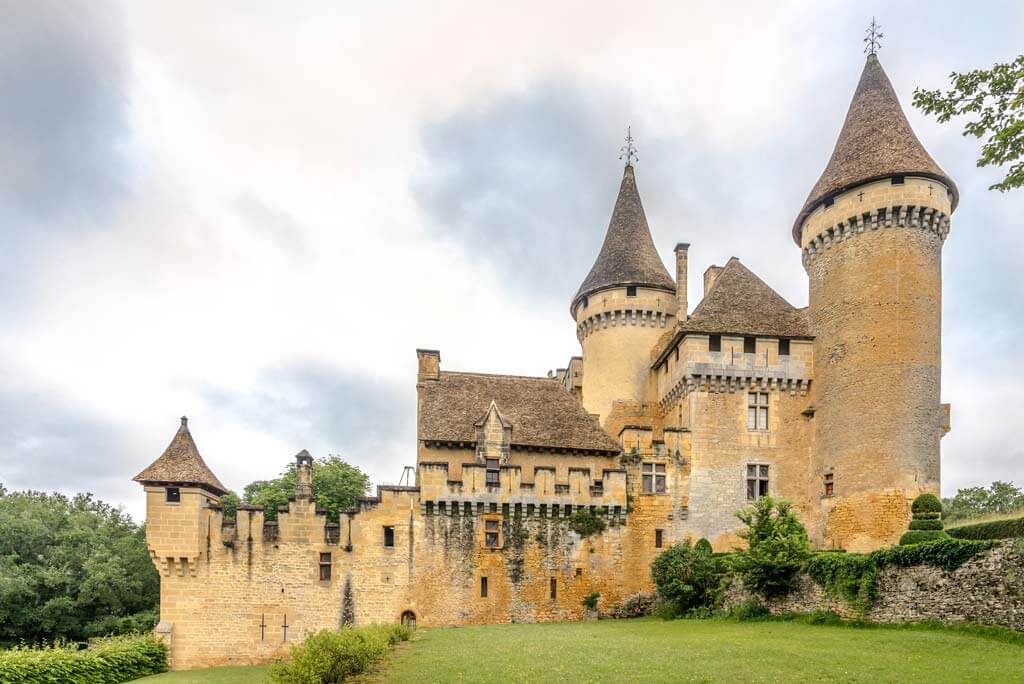
READ MORE: What is a château?
Châteaux to Visit in France Map
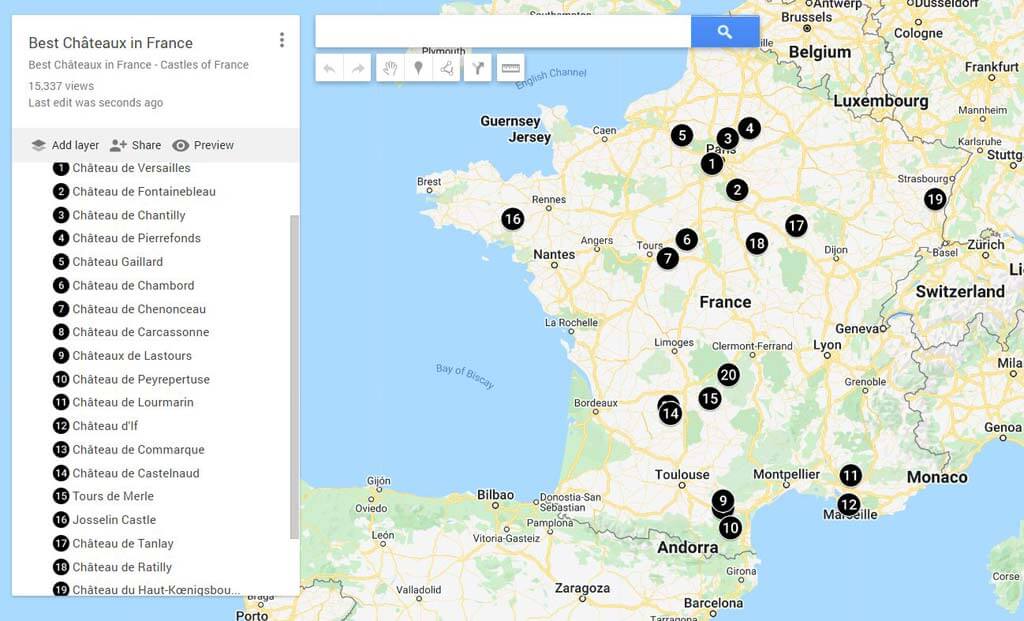
Click here to view the map of the French castles online on Google
How to Visit the French Châteaux
With a few exceptions (Versailles, Fontainebleau,…), the best way to visit these beautiful castles in France is by car. A French self-drive holiday allows you to visit all these stunning French châteaux, usually difficult to reach by public transportation.
If you don’t have a car in France, we recommend booking one with Discover Cars . This site is great because it takes all major rental companies, such as Hertz, Avis, and more, and compares prices for you. If this is your first time driving in France, check out our best tips for renting a car in France .
Stay in one of the Château-Hotels in France
For a total château experience, stay a couple of nights in one of the wonderful château-hotels in France. Some lovely French castles have found new lives as château-hotels and now offer accommodation with discerning five-star service that will treat you like a royal, if only just for the night. Explore the best châteaux in France during the day, and choose your particular château to rest your head at night.
Here are some great places to stay:
- Best château-hotels in the Loire Valley
- Best château-hotels in Burgundy
- Best château-hotels in Champagne
Best Châteaux in France near Paris
There are many castles near Paris , and they all make great day trips from the French capital. Most of these castles are Royal Castles, but there are also other lesser-known French châteaux interesting to visit.
If you are looking for castles near Paris, here’s the list of the most beautiful ones.
Château de Versailles
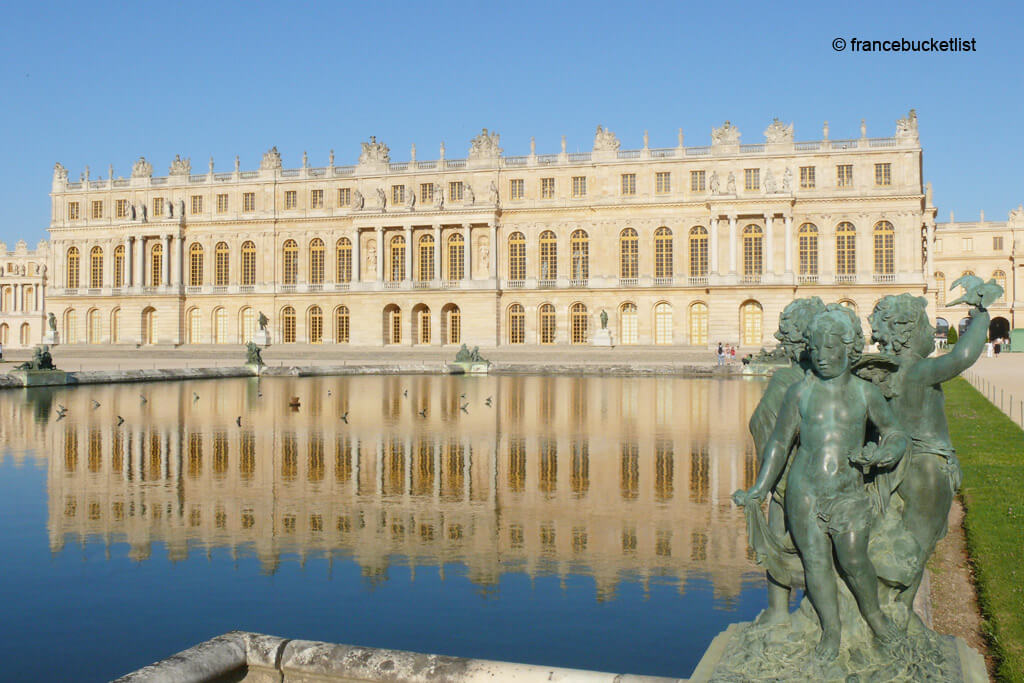
- Location: Versailles (Ile-de-France)
- Architectural Style: French Baroque
Château de Versailles is for some the best château in France, a jewel of French baroque architecture listed as UNESCO World Heritage. Due to its proximity to Paris, it is also one of the most visited castles in France.
Versailles was built in the 17th century by King Louis XIII as a hunting lodge. Under his son, King Louis XIV, the palace was totally rebuilt by the best artists of that time: Le Vau was in charge of the architecture, Le Nôtre designed the gardens, and Le Brun was in charge of the sculpture – Click here to buy tickets to Château de Versailles
After the visit to the palace, don’t miss the Gardens of Versailles , stunning French-style gardens decorated with beautiful sculptures, fountains , and other water games that surround the famous French château on three sides. From April to the end of October, the Gardens of Versailles host beautiful water and music shows.
READ MORE: check out this quick guide to Versailles
Château de Fontainebleau
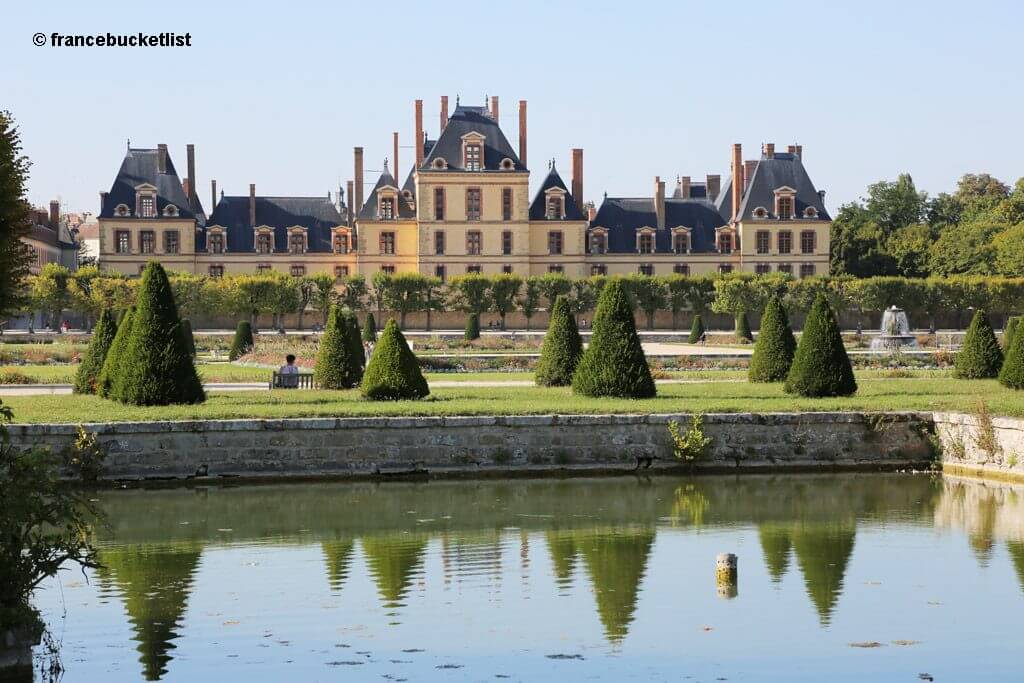
- Location: Fontainebleau (Ile-de-France)
- Architectural Style: different styles
TIP : This day top-rated tour from Paris visits Château de Fontainebleau and Château de Vaux-le-Vicomte in one day
Château de Fontainebleau is another famous château in France. Château de Fontainebleau was the French Kings’ home during their hunting getaways in the forest of Fontainebleau .
Since the Middle Ages, the forest of Fontainebleau was a hunting place for the royals and nobles. King Louis VII was the first king to build a castle (a keep) in Fontainebleau in the 12th century. Since then, his successors enlarged and embellished this former keep, turning it into one of the most beautiful castles in France.
Château de Fontainebleau has fantastic rooms and halls richly decorated with the best materials and fabrics. The exquisite Renaissance Rooms, decorated in the 1500s under King François I and King Henry II’s supervision, are worth the entry alone. Finally, don’t miss the surrounding gardens with beautiful fountains and ponds – Click here to buy tickets to Château de Fontainebleau
Château de Chantilly
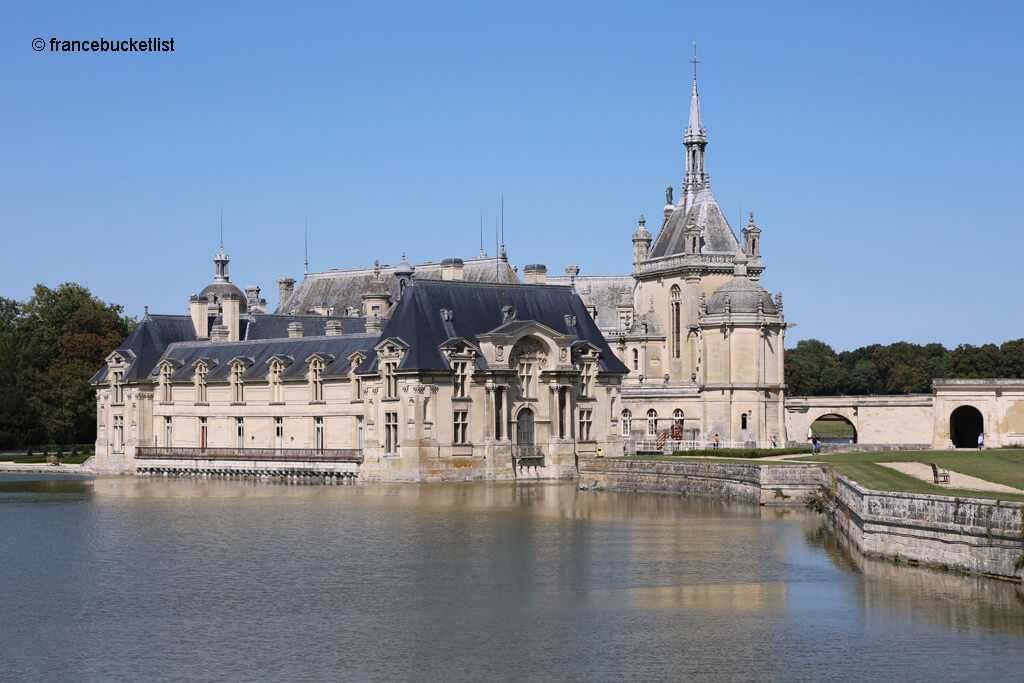
- Location: Chantilly (Hauts-de-France)
- Architectural Style: Renaissance
Château de Chantilly is not a royal castle, but its picturesque setting, gardens, and architecture will likely steal your heart. Besides, Chantilly is well connected to Paris by train, making a beautiful day trip out of Paris.
The current castle was rebuilt after the French Revolution by Henry d’Orléans, penultimate son of King Louis-Philippe I and the estate’s heir. Henry d’Orléans installed in the château his collections of paintings, drawings, and old books, known today as the Musée Condé . The Musée Condé hosts the second most extensive collection of artwork in France, only second to the Louvre artwork in Paris. There’s also an impressive library and lecture room with an extensive collection of medieval manuscripts and ancient books.
After visiting the château, explore the magnificent gardens. The château is surrounded by a beautiful French Garden designed by André Le Nôtre an English Garden, and a hamlet similar to the one in Versailles – Click here to buy tickets to Château de Chantilly
Best Castles in Northern France
The list of castles in Northern France includes beautiful French châteaux in the regions of Ile-de-France, Normandy, and Hauts-de France.
Château de Pierrefonds

- Location: Pierrefonds (Hauts-de-France)
- Architectural Style: Late Medieval /Early Renaissance
TIP: This road trip from Paris explores Château de Pierrefonds and other beautiful sites nearby.
Château de Pierrefonds is a fairy-tale château in France with an interesting history. Located in the village of Pierrefonds , north of Paris, Château de Pierrefonds makes an excellent day trip from Paris by car, and it is a great place to explore with the family.
The first construction was built during the 13th century. One century later, King Philippe Auguste incorporated the castle into the royal domains to be used as a royal palace. When King Charles V died in 1392, Château de Pierrefonds was inherited by his youngest son, Duke Louis d’Orléans, who entirely rebuilt the castle.
Over the centuries, the castle changed hands many times. In March 1617, during the early troubled days of King Louis XIII’s reign, the castle, then the property of François-Annibal d’Estrées, who joined the ‘parti des mécontents’ (party of discontent), was besieged, taken, and destroyed by the King’s troops.
Two centuries later, the ruined castle was bought by Napoleon I, and it was used for important banquets and other events. In 1857, Emperor Napoleon III asked Viollet-Le-Duc to undertake the restoration of the château to be used as an imperial residence. The result was more a work product of Viollet-le-Duc’s imagination rather than a faithful restoration but we love the interiors with their bright colors and period furniture – Click here to buy tickets to Château de Pierrefonds

Château Gaillard
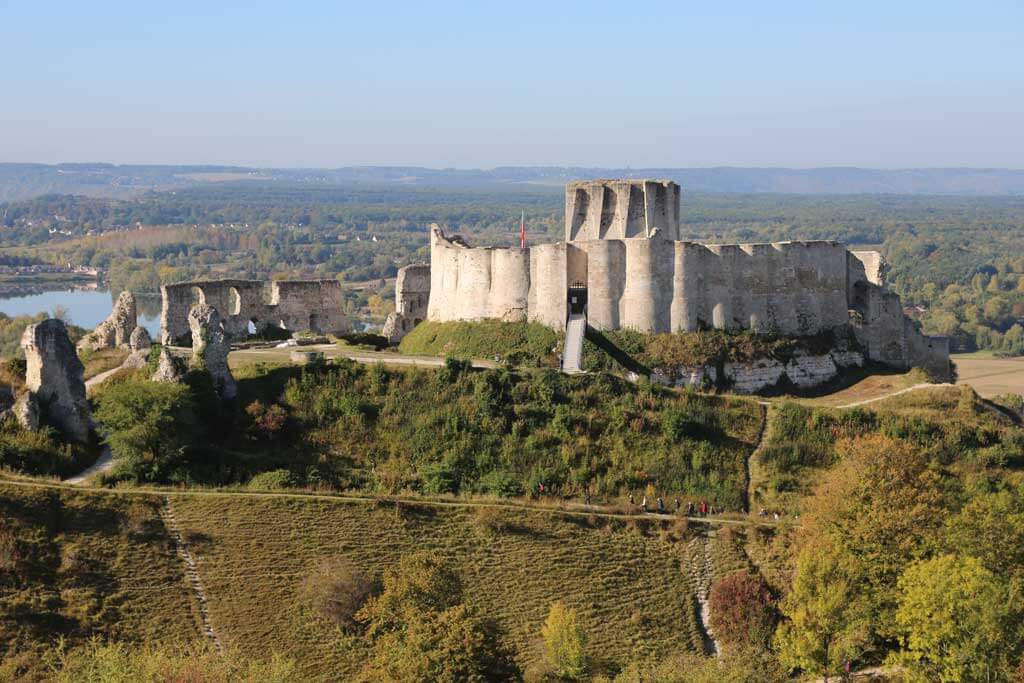
- Location: Les Andelys (Normandy)
- Architectural Style: Medieval
TIP: This Normandy road trip from Paris explores Château Gaillard and other beautiful places nearby.
Château Gaillard is one of the best castles in Normandy . It is a medieval fortress built in the 12th century under the rule of King Richard the Lionheart, who was also Duke of Normandy, to protect his lands against the French King Philippe Auguste. The castle was strategically located on the top of a high cliff dominating the towns of Les Andelys and the Seine Valley. The view from the castle, over Les Andelys and the Seine’s meanders, is amazing.
Château-Gaillard had a complex plan, very different from other fortresses built during the same period. The castle was organized in multiple volumes, almost independent of each other. This arrangement aimed to multiply the obstacles to exhaust the attacker and need fewer defenders.
Château Gaillard consisted of three baileys (an inner, a middle, and an outer), the latest with the castle’s main entrance. In the inner bailey, the keep is one of the most original and best-preserved keeps in the area. It is in the form of a circular tower on three quarters but with an angle to the southeast. The baileys, which were separated by rock-cut ditches, housed the castle’s stables, workshops, and storage facilities, while the keep was reserved for the use of King Richard.
Loire Valley Castles
The Châteaux in the Loire Valley are some of the most famous châteaux in France. And for a reason! Fairy-tale architectures, unique settings, and interesting stories. The Loire Valley Castles are located in the regions of Centre – Val de Loire (the most popular) and Pays de la Loire.
The Loire Valley Castles are not far from the French capital, so it is possible to explore one or two castles on a busy day trip from Paris. Here’s the list with a couple of favorites.
Château de Chambord
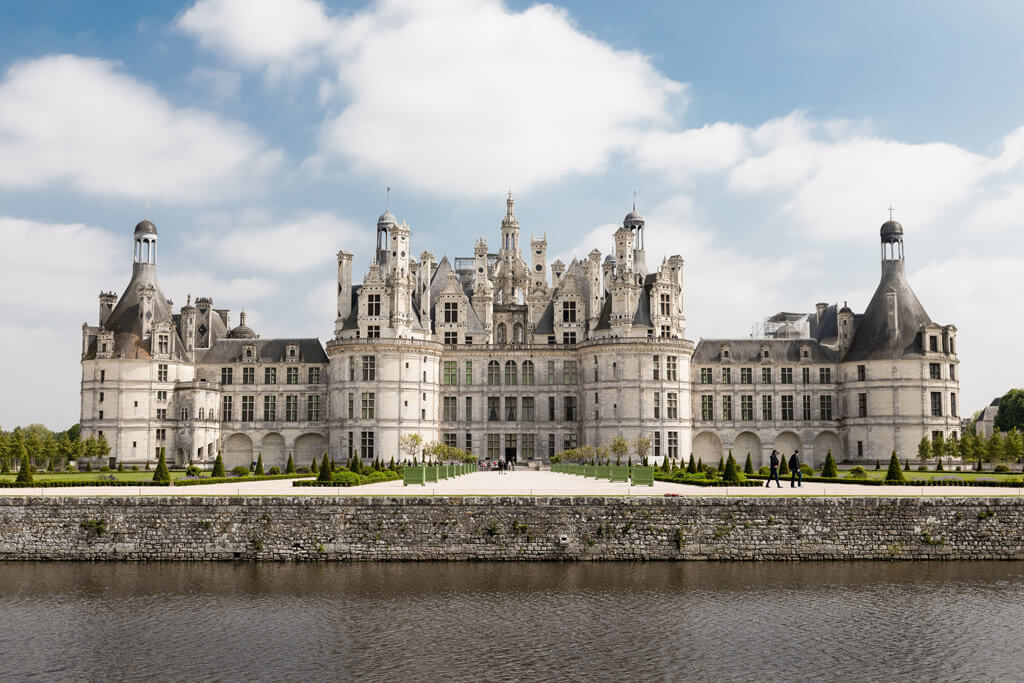
- Location: Chambord (Centre-Val-de-Loire)
TIP: This Loire Valley road trip explores Château de Chambord and other beautiful Loire Valley Castles nearby.
Château de Chambord is the best French château in the Loire Valley and definitely a must on any Loire Valley bucket list. It is also the largest castle in the area, surrounded by the largest closed forest park in Europe (approximately 50 km2 surrounded by a wall of 32 km long).
Château de Chambord was built in the 1500s for King Francis I to be used as a second residence. For the King, Château de Chambord was a place to relax, hunt, and have fun with his court, but it was also used to showcase his political and cultural power.
From the beginning of the Second World War, the castle became the center to sort and protect the treasures of the national museums of Paris and the North of France, which had to be evacuated from German bombardments. Curators and guardians stood guard to defend the works of the Louvre Museum stored in the castle.
Don’t miss Chambord’s famous double-helix staircase that twists gracefully up three floors: it is rumored that Leonardo da Vinci had a hand in its design! – Click here to buy your tickets to Château de Chambord
Château de Chenonceau
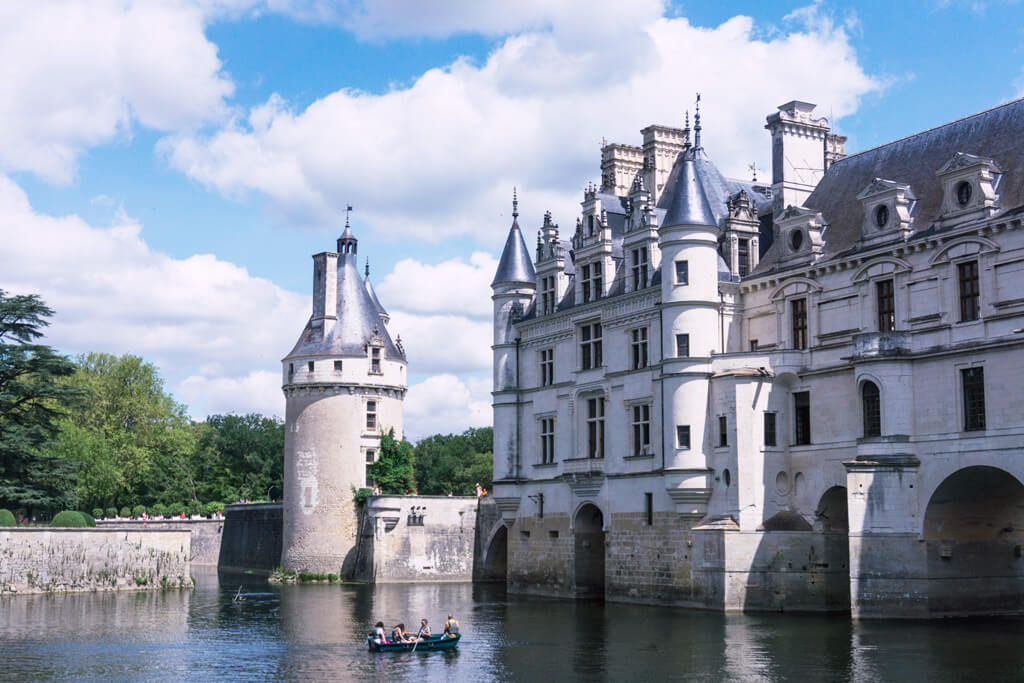
- Location: Chenonceau (Centre-Val-de-Loire)
TIP: this top rated Loire Valley day tour from Paris visits Château de Chenonceau, Château de Chambord, and Château d’Amboise
Château de Chenonceau is another famous French château in the Loire Valley, with beautiful architecture and a unique setting. For many, Chenonceau is considered the best château in France and is the second most visited castle in the country only after Versailles.
The construction and later transformations of this Renaissance château are closely linked to several powerful women. It was built by Katherine Briçonnet in 1513, enriched by Diane de Poitiers (King Henry II’s mistress who received the château from the King), and enlarged under Queen Cathérine de Médicis. For this reason, Château de Chenonceau is also known as Le Château des Dames .
Chenonceau’s main highlight, which makes the castle unique, is its famous two-story gallery overlooking the Cher River. But of course, there’s much more to explore in Chenonceau! You can also visit the castle’s surroundings on a rowboat or fly over Chenonceau in a hot air balloon – Click here to buy your tickets to Château de Chenonceau
Best Castles in Southern France
The list of best castles in Southern France includes beautiful castles in the regions of Occitanie and Provence-Alpes-Côte d’Azur.
The first three castles below are must sites of the Cathar Country. Catharism was a religion that flourished in the Languedoc-Roussillon region during the 12th and 13th centuries considered heretics by the Catholic Church.
Castle of Carcassonne
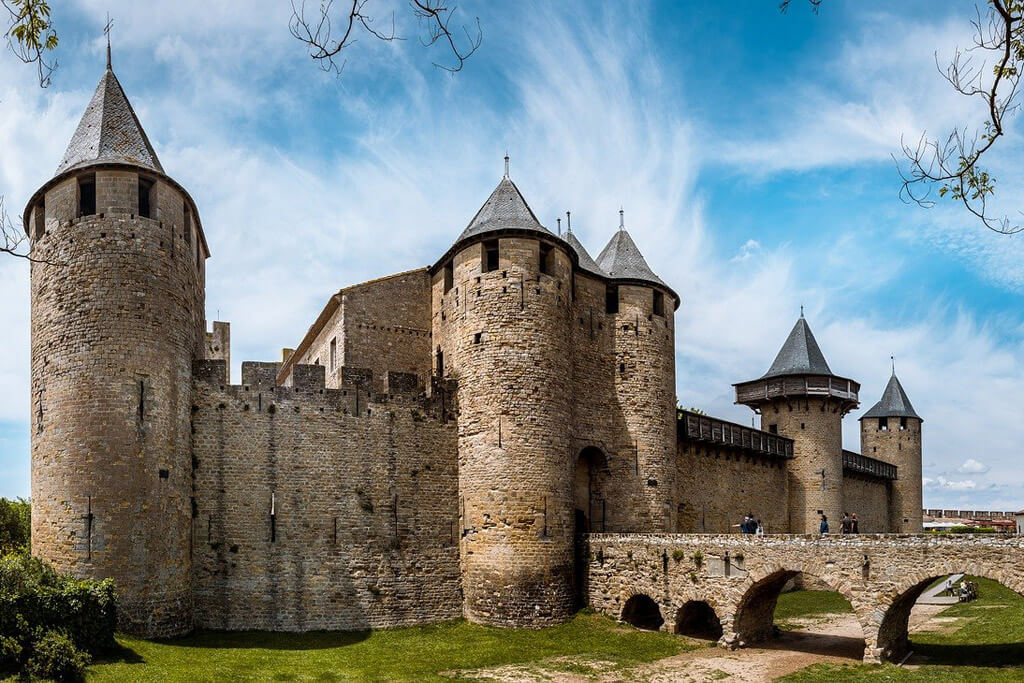
- Location: Carcassonne (Occitanie)
The Castle of Carcassonne is a medieval castle within the Cité de Carcassonne , a kind of fortress inside the fortress and the epitome of your fairytale medieval castle. The Castle at Carcassonne was built in the 12th century by Bernard Aton Trencavel, Count of Carcassonne, over the western part of previous Roman walls.
The Castle of Carcassonne is rectangular in shape, and it is separated from the city by a deep moat and defended by two barbicans. The castle’s six towers are pierced with stirrup loopholes, and the curtain walls and the top of the towers can be used with hoists. The western flank of the walls, against which the Carcassonne Castle is built, is defended by a square watchtower, the Tour Pinte, which is the highest in the city.
Inside the Carcassonne Castle, there are the remains of the Counts’ private chapel and a museum with an interesting collection of Cathar gravestones and other objects related to the Cathars – Click here to buy your tickets for the Cité de Carcassonne and Castle
Châteaux de Lastours
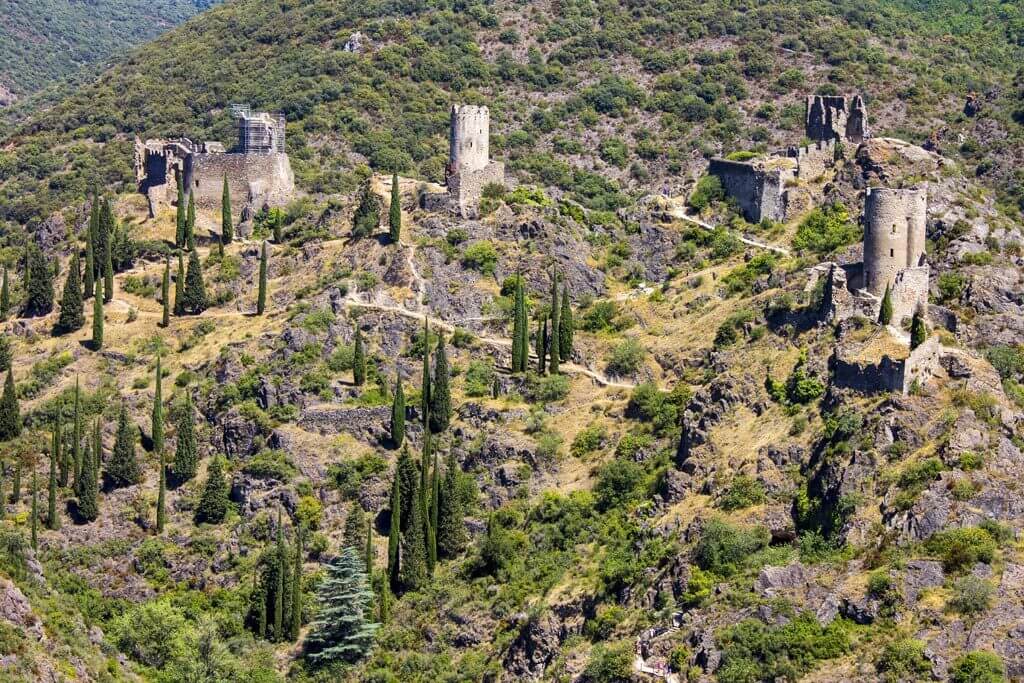
- Location: Lastours (Occitanie)
TIP: This Cathar Country road trip explores Châteaux de Lastours and other beautiful castles nearby.
Châteaux de Lastours is an ensemble of four castles (Cabaret, Tour Régine, Surdespine, and Quertinheux) perched on a rocky spur and isolated by deep valleys. They are located in the Languedoc-Roussillon region, a 20-minute ride from the famous fortified city of Carcassone. At the foot of the castles, visitors can still see the ruins of Cabaret, the village that surrounded the castles in Medieval times.
In the 11th century, there were only three castles (Cabaret, Surdespine, and Quertinheux) occupied by the Lords of Cabaret. Their location evolved in time following the successive destructions and reconstructions.
The Lords of Cabaret seemed to be very close to the Catharism, and there was a regular presence of Cathar bishops in the castles. Cabaret was besieged by the Crusaders in 1209 and 1227 without success.
Cabaret was besieged again in 1229, and the Lords of Cabaret capitulated definitely. Cabaret became a royal fortress, and a fourth tower, the Tour Régine, was built by order of the king to affirm his supremacy over Cabaret.
What visitors can see today are the remains of the 13th-century buildings, with fantastic views over the surrounding valleys.
Château de Peyrepertuse
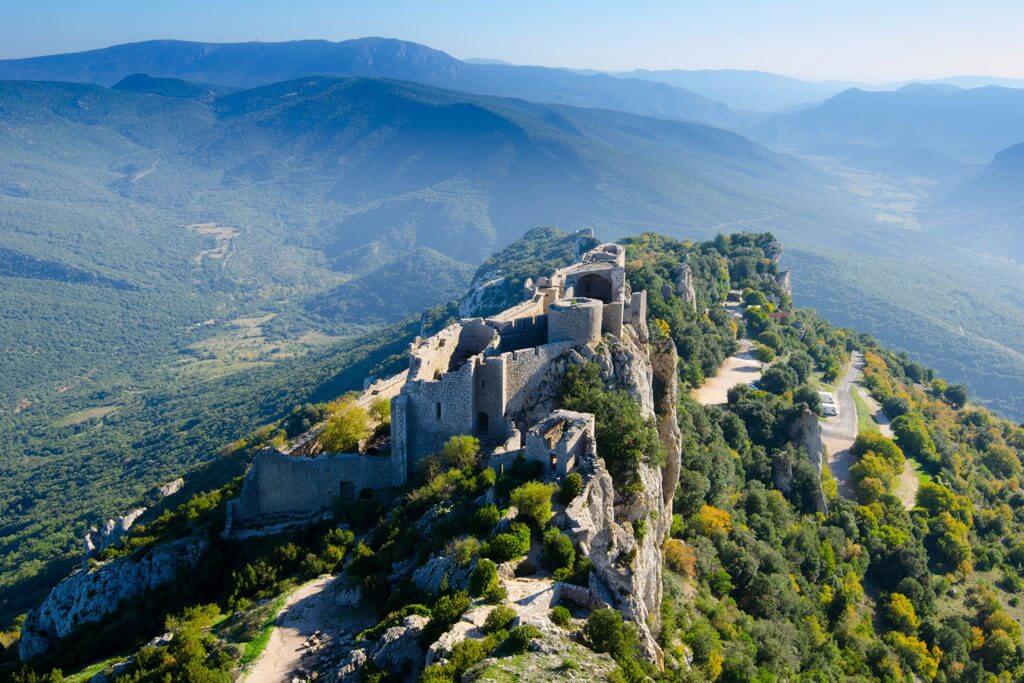
- Location: Duilhac-sous-Peyrepertuse (Occitanie)
This vertiginous citadel is a fantastic piece of military architecture built on a limestone cliff watching over the village of Duilhac .
Built between the 11th and 13th centuries, the Château de Peyrepertuse first consisted of a small fortified settlement which, over the years, turned into an essential piece of Aragon’s defensive line against the Occitan lords.
During the crusade against the Albigenses, the castle was the stronghold of Guillaume de Peyrepertuse, who, not wanting to submit, was excommunicated in 1224. Guillaume finally surrendered after the fall of Carcassonne, and the castle became a French possession in 1240. The French King Louis IX turned Château de Peyrepertuse into a crucial part of his defense line against Aragon.
In 1242, King Louis IX decided to strengthen the castle and add a second part, the Donjon Sant Jordi (Saint Jordi’s Keep), located higher up on the crest. Château de Peyrepertuse’s strategic importance ended with the Pyrénées Treaty in 1659, when the northern part of Catalonia was transferred to France. However, men continued watching over this beautiful castle until the French Revolution.
Today visitors can explore the lower walls, the two keeps linked by a staircase dug out of the rock and two small chapels. The view from Saint Jordi’s Keep, the castle’s highest point, is incredible.
Château de Lourmarin
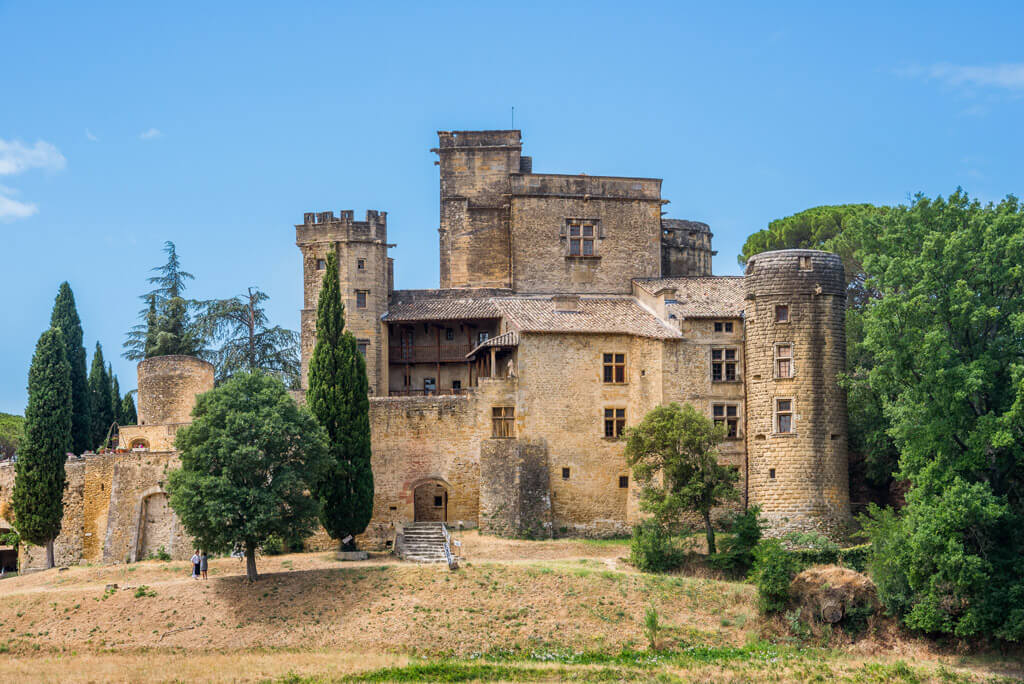
- Location: Lourmarin (Provence-Alpes-Côte d’Azur)
Château de Lourmarin , in the Vaucluse department, is a Renaissance château built in two phases. The first part was built in the 15th century, on the ruins of a fortress dating from the 12th century, and the second part of the castle was built during the first half of the 16th century.
The Château de Lourmarin is nicknamed the little Villa Medici in Provence , mainly for its ceremonial spiral staircase, loggia, fireplaces, and parkland. It also has beautiful furniture and an interesting collection of musical instruments and engravings.
Château d’If
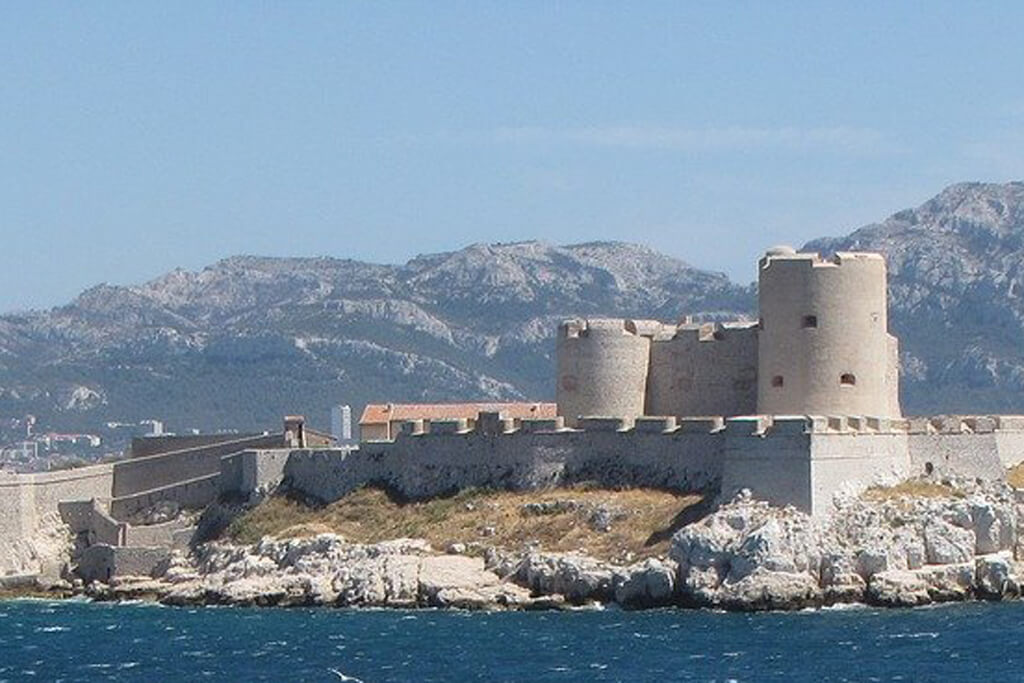
- Location: If Island, Marseille (Provence-Alpes-Côte d’Azur)
The imposing Château d’If was built by King François I in 1524 to protect the city of Marseille from sea attacks. This fortified château is located on the small If Island, off Marseille’s coast. During its 400 years of activity, this French château was used primarily as a state prison.
Château d’If became world-famous thanks to the novel Le Comte de Monte-Cristo by Alexandre Dumas. Here, the hero Edmond Dantès was imprisoned for 14 years.
Today, Château d’If is one of the most popular day trips from Marseille , attracting thousands of visitors every year. Numerous shuttle boats link Marseille’s Old Port to Ile d’If hourly, and the guided visit to the château is very interesting – Click here to buy your tickets to Château d’If
Best Castles in Western France
The list of castles in Western France includes some Dordogne Castles and other French châteaux in the regions of Brittany, Pays-de-la-Loire, and Nouvelle-Aquitaine.
Château de Commarque
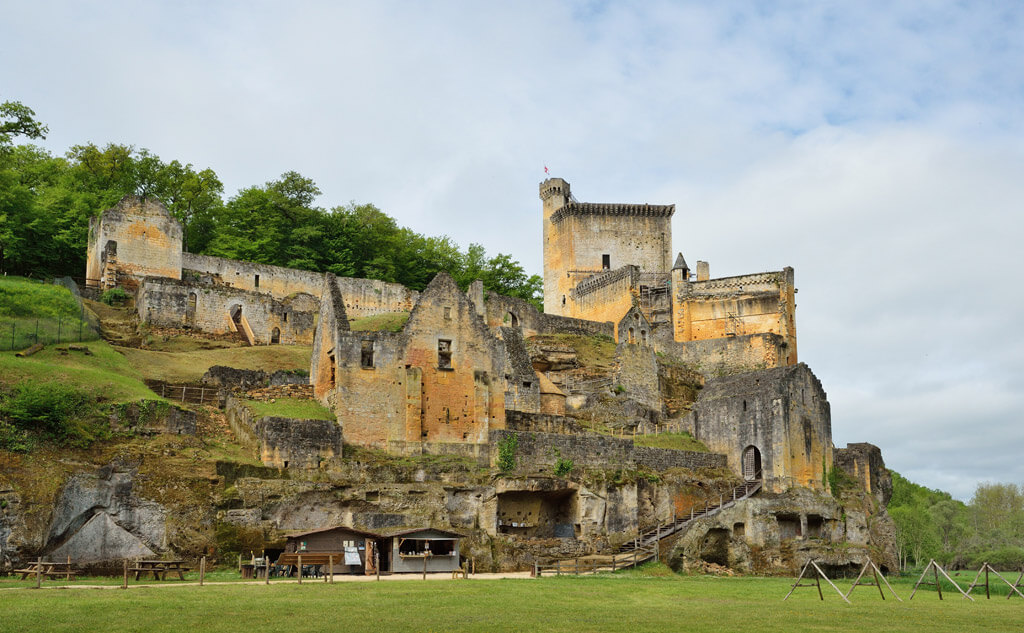
- Location: Eyzies-de-Tayac-Sireuil (Nouvelle-Aquitaine)
Château de Commarque , in the Dordogne Valley, is one of the most beautiful medieval castles in France. It is a medieval castrum that regroups a castle, a chapel, and some tower-houses for the nobility inside the fortification.
Château de Commarque was built during the 12th century by the Lords of Beynac to ensure the safety of two important trade routes that crossed the valley: the road from Périgueux to Cahors and the road from Brive to Bergerac.
During the Hundred Years’ War, the Beynacs remained the faithful defenders of the valley and the crown of France. The English nevertheless seized the castle in 1464 and kept it for a few years. Other wars followed, and with them, the castle was badly damaged. Finally, the site was abandoned in the 18th century.
In 1915 a religious man discovered a prehistoric cave inside the cliff that supports the castle. This cave contained 150 drawings carved by men 15,000 years ago. The cave was classified as a historical monument in 1924.
In 1968, a descendant of the original family bought the ruins of the castle and undertook an extensive program of consolidation and restoration of the castle. The castle is open to the public since the year 2000.
Château Castelnaud
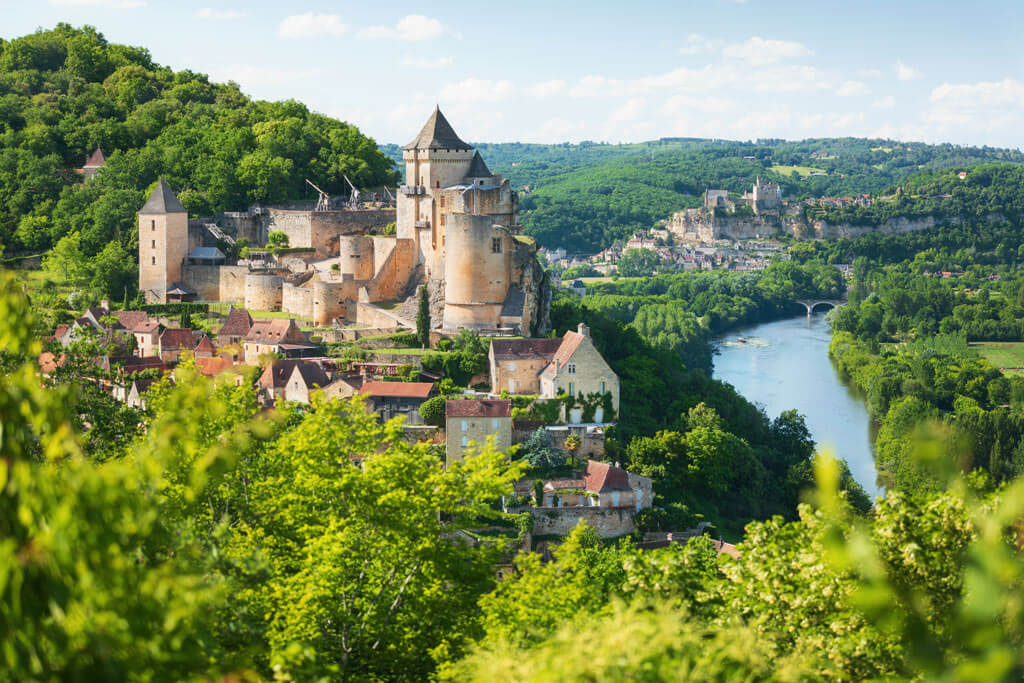
- Location: Castelnaud-la-Chapelle (Nouvelle-Aquitaine)
This medieval castle is located in the Dordogne Valley, overlooking the Céou Valley and facing the fortress of Beynac, its eternal rival. Château Castelnaud is one of the most beautiful châteaux in France, an excellent example of a feudal private fortification, with fortified walls, a bastion, a dungeon, an artillery tower, and living quarters.
One of the most famous castles in Dordogne , the first construction was built during the 12th century but was destroyed during the Albigensian Crusade led by Simon de Monfort’s armies. During the 13th century, a new castle was built, and it was occupied by the families of Castelnaud and Berbiguières united by marriage.
During the Hundred Years’ War, Castelnaud took the English party until 1442, when the king’s army defeated it. As a result, the castle changed owners, and the family of Caumont kept it until the French Revolution when the castle was abandoned.
From 1967 to 2012, the castle underwent an extensive program of restoration works. Today, Château de Castelnaud is open to the public and it is an easy half-day trip from Sarlat . It hosts the interesting Museum of the War in the Middle Ages , with an extensive collection of weapons and other items.
Tours de Merle
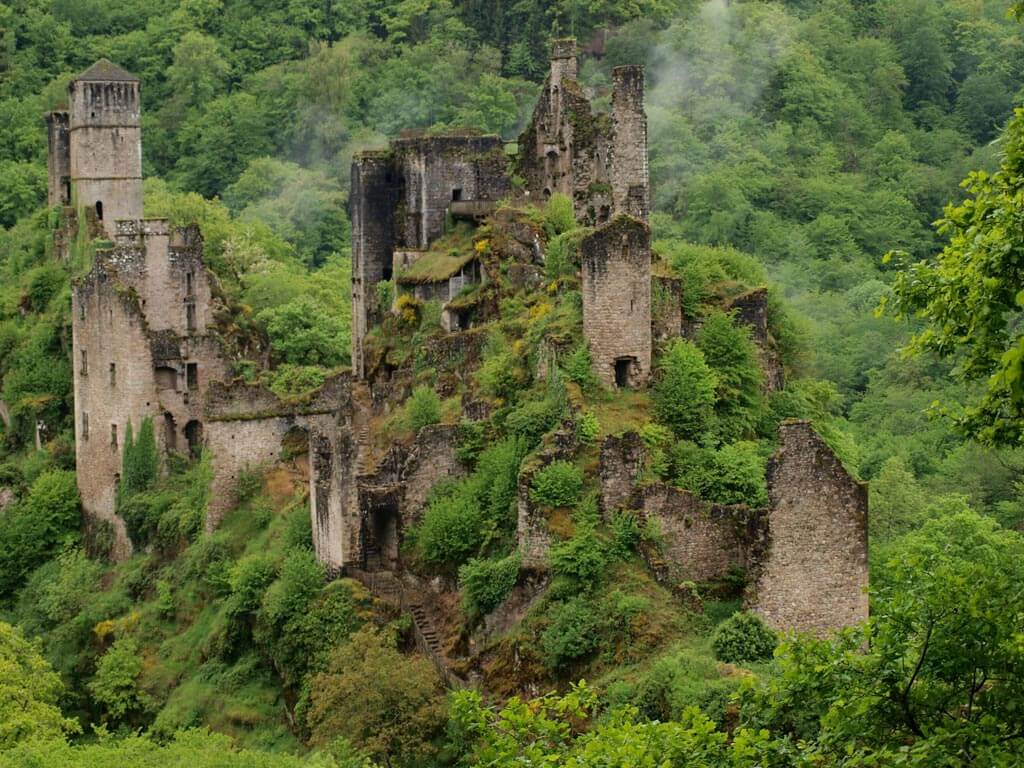
Source: Flickr
- Location: Saint-Geniez-ô-Merle (Nouvelle-Aquitaine)
This set of crumbling towers located in a steep valley on the western side of Massif Central is just amazing. Tours de Merle was a feudal fortress (castrum) built between the 12th and 15th centuries. It included seven fortified houses owned by seven noblemen from Merles, two chapels, and a village.
The site was taken by the English during the Hundred Years’ War and then by the Calvinists in 1574. The Calvinists established a garrison for two years until the co-lords of Merles chased them out. However, the co-lords then abandoned the site, because they preferred to live in more pleasant and accessible places.
At the end of the 17th century, the village inhabitants, no longer able to count on the lords’ protection, dispersed, and Tours de Merle gradually fell into oblivion.
Today the Tours de Merle are part of a 10-hectare park, and it is an exciting place to explore and enjoy amazing views of Massif Central.
Château de Josselin
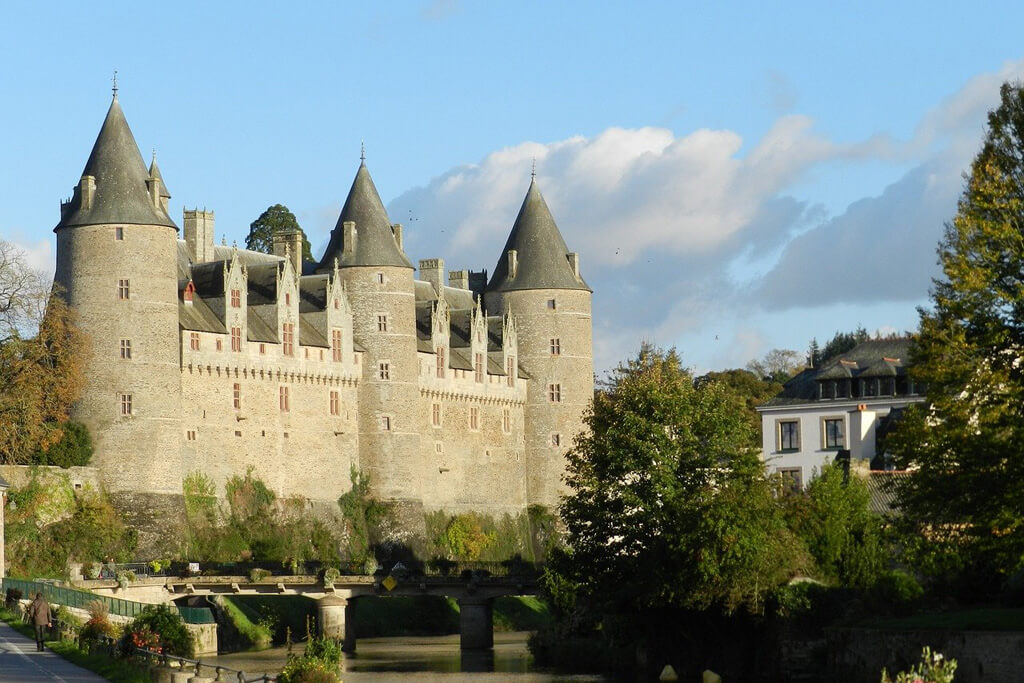
- Location: Josselin (Bretagne)
- Architectural Style: Medieval, Renaissance
The Château de Josselin is an impressive castle located above the Nantes-Brest Canal, in the Gulf of Morbihan . The castle has been home to the Dukes of Rohan for more than ten centuries.
A first wooden château was built in 1008 on this site, chosen for its military and trading importance. Soon a village developed at the foot of the castle.
Over the centuries, the castle was destroyed, reconstructed, and it changed hands many times. The fortress that you can see today from the river is from the 14th century, while the magnificent residence inside, in the Renaissance style, was added in the 16th century.
During the 17th century wars of religion, three of the original nine towers were destroyed on Cardinal Richelieu’s orders, and two more towers were destroyed years later.
One of the best castles in Brittany , Château de Josselin remained abandoned until about 1850 when the dukes undertook a major restoration to become their home again.

Best Castles in Eastern France
The list of best castles in Eastern France includes famous French castles in the regions of Auvergne-Rhône-Alpes, Grand Est, and Bourgogne-Franche-Comté.
Château de Tanlay
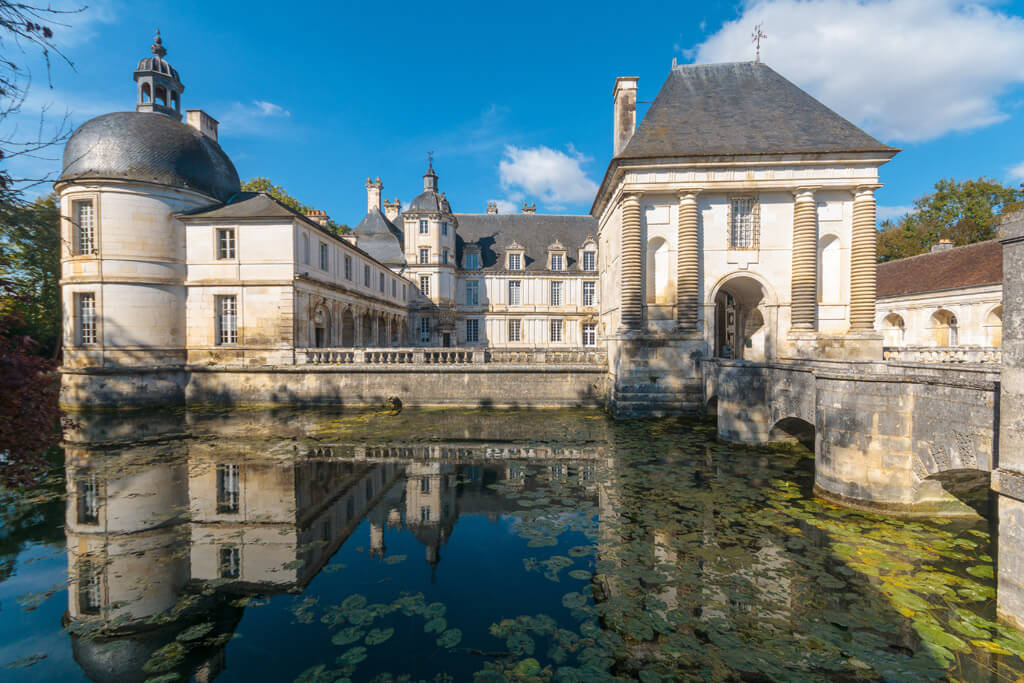
- Location: Tanlay (Bourgogne-Franche-Comté)
The Château de Tanlay is a famous château in France built in Renaissance style during the 16th and 17th centuries. It is one of the most beautiful castles in the region of Bourgogne, famous for its unique setting and awesome architecture with slate roofs à la française .
The castle is surrounded by a moat, with access through a bridge. The reflections of the castle on the water and the perfect symmetry of the cour d’honneur is part of Tanlay’s serene charm.
The castle was completely rebuilt by Admiral de Coligny in the 16th century, who inherited the property in ruinous conditions. Home to Admiral Coligny’s family during the Wars of Religion, its reconstruction was completed by Michel Particelli d’Hemery, Mazarin’s superintendent of Finance. In the late 17th century, Château de Tanlay became the property of the Marquis de Tanlay, and the same family still inhabits it.
Château de Ratilly
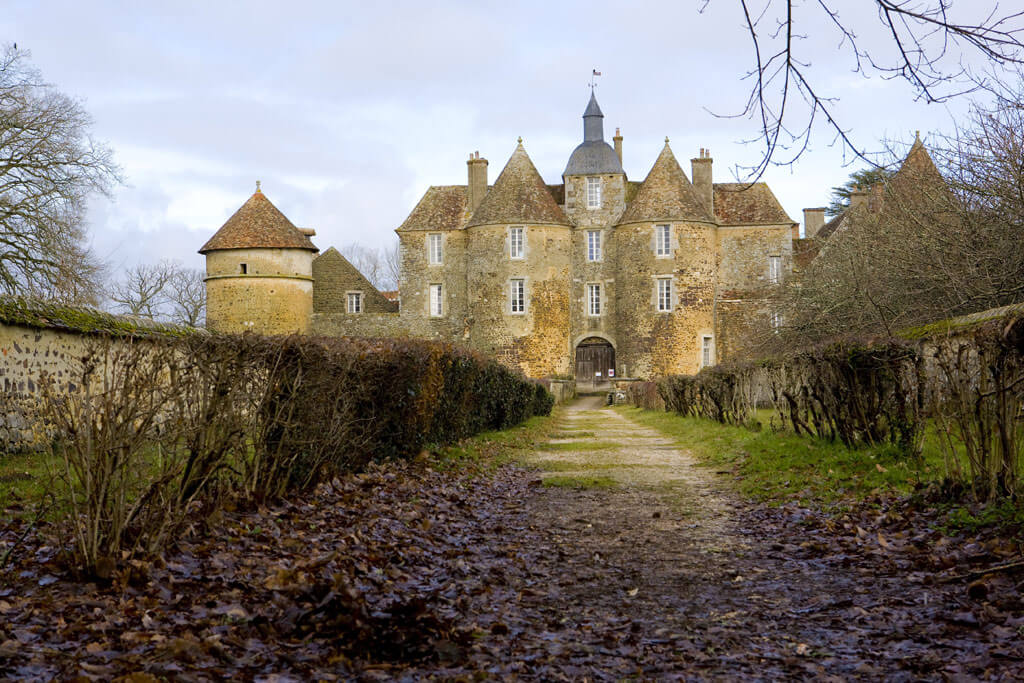
- Location: Treigny (Bourgogne-Franche-Comté)
This beautiful French château is located on the top of a hill overlooking the Valley of the Tendril at 270 meters. The site is near the Seine-Loire watershed.
The current castle was built in the 13th century following a Philippian plan: an enclosure with 6 turrets delimited a rectangular courtyard. The whole is surrounded by dry moats, with two towers framing the drawbridge.
In the middle of the 14th century, during the Hundred Years’ War, the castle was home to a group of looters. Years later, in 1567, the castle became one of the headquarters for the Huguenots in the Auxerrois.
During the Renaissance, Château de Ratilly was transformed into a habitation for Mary de Puy. The renovation works included installing chimneys and the opening of windows in the walls of the towers, while the southwest tower became a garret.
In the 18th and 19th centuries, the estate was sold several times. Today, the Château de Ratilly is opened to the public as an art center.
Château du Haut-Koenigsbourg
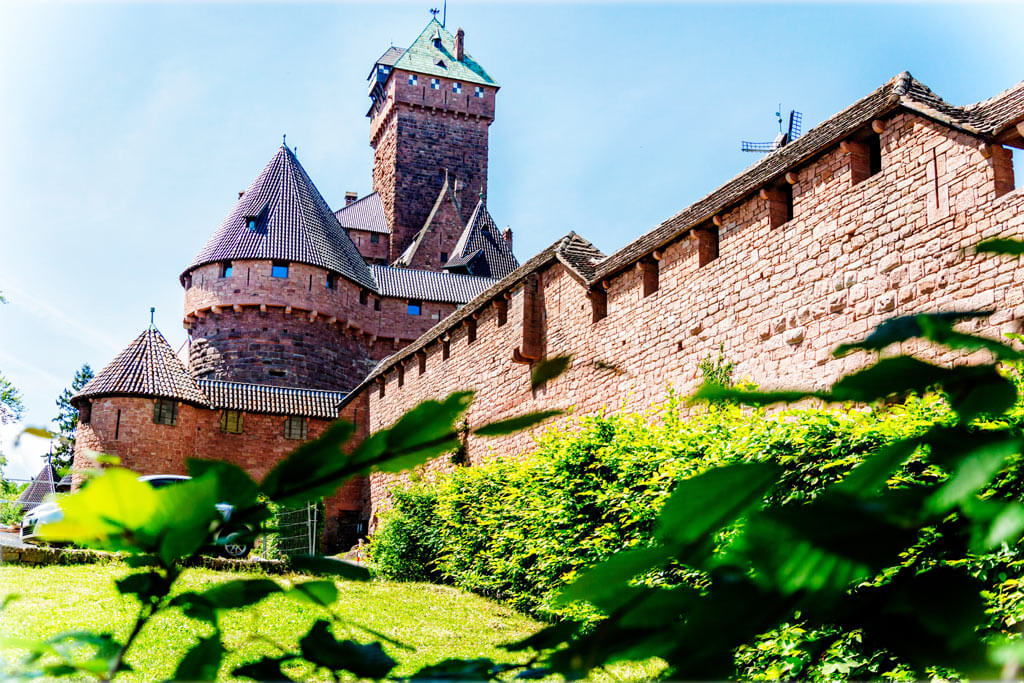
- Location: Orschwiller (Grand Est)
TIP: This Alsace road trip explores Château du Haut-Koenisbourg and other beautiful places nearby.
Château de Haut-Koenisbourg is one of the best châteaux in France. This fortified castle from the 12th century (but deeply transformed during the 14th century), dominates the Alsatian Plain from the Buntsandstein Rock and has a panorama out to the Black Forest. The castle is a must-stop on any trip to Alsace , and it is a popular day trip from Strasbourg or Sélestat.
The Hohenstaufen family built the castle as part of a defense line to reinforce their power in Alsace. Over the centuries, the castle was disputed by different families and nations until it was severely damaged during the Thirty Years’ War and was abandoned.
The castle we can see today is from the 20th century, the result of Kaiser William II’s romantic vision of medieval castles. The castle went through a deep restoration under his direct supervision, and he visited the works regularly. For the Kaiser, this castle marked the western boundary of the German Empire.
At the end of the First World War in 1919, the region of Alsace-Lorraine and the castle became part of the French State. However, the coat of arms of William II is still visible within the castle, and it remains one of the symbols in Alsace of the German presence between 1871 and 1918.
Château de Val
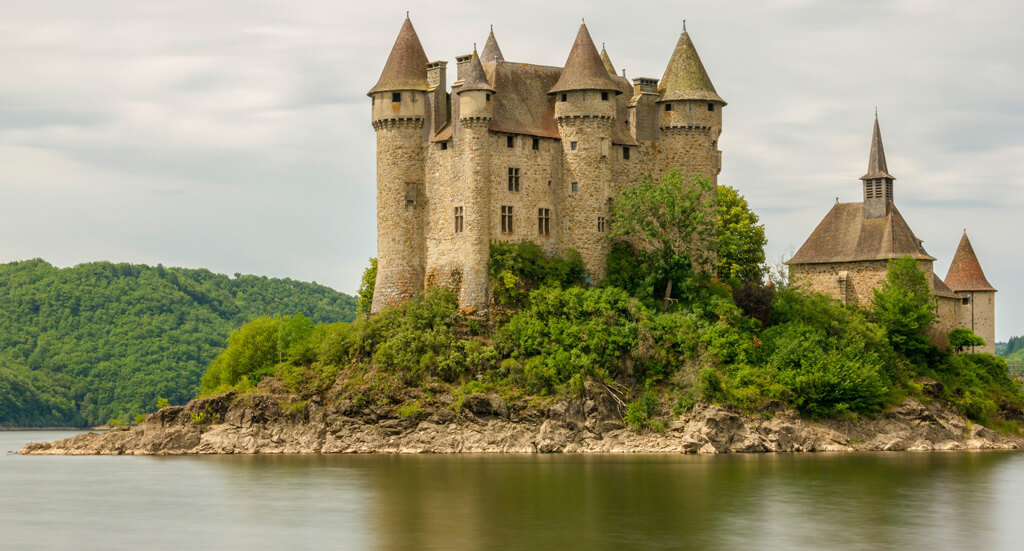
- Location: Lanobre (Auvergne-Rhône-Alpes)
Château de Val is one of the most charming châteaux to visit in France, a fortified castle located in the region of Auvergne-Rhône-Alpes between the 13th and 15th centuries.
Built on a rocky spur 30 meters high overlooking the Valley of Haute-Dordogne, the fortress, and its parkland failed to disappear under the waters following the construction of the new dam. However, at the very last moment, the water level of the new artificial lake was reviewed only up to the foot of the castle, and Château de Val and the beautiful Saint Blaise Chapel were saved.
Today, Château de Val appears as an atypical construction located on the edge of one of the largest lakes in Europe. Its elegant silhouette crowned with six towers reflected on the water and the natural environment with landscapes of great beauty is a must-see in the region. We recommend staying until nightfall when the Château de Val lights up.
And there you have it, the list of best castles in France to visit, which is the best French château in your opinion?
Click here for more architecture in France
Back to Homepage
Pin it Now & Read it Later
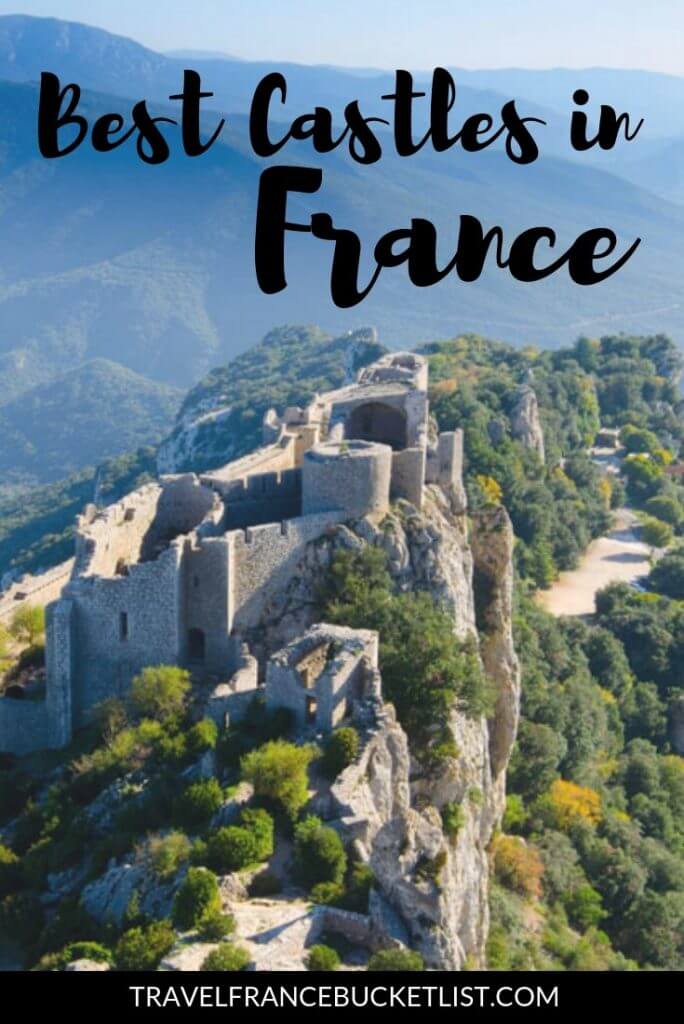
Disclaimer: This article may contain compensated links, meaning we get a small commission if you make a purchase through our links. It costs you nothing more (in fact, if anything, you’ll get a nice discount) but helps us to go on creating incredible French content for you. We trust all products and brands promoted here and would never recommend anything that isn’t of value. Please read disclaimer for more info.
(C) Copyright 2019 - 2024 France Bucket List. All Rights Reserved. Designed & Developed by France Bucket List || Disclaimer || Privacy Policy || Contact |
France’s most beautiful castles: from formidable forts to lavish riverside châteaux

Aug 16, 2022 • 9 min read

It may involve a steep climb to reach it but the views from Château de Montségur are worth the effort © Martin Silva Cosentino / Getty Images
There was a time, long, long ago, when the French royalty and nobility collected châteaux the way others collect stamps. Everyone wanted a piece of the palace pie it seemed and as a result, France is sprinkled with some 40,000 châteaux, spanning epochs and flaunting the historic clout. It’s an artistic sensibility and love of great, beautiful things that is so very French.
But not all châteaux are created equal: from manors to mighty crag-clutching forts in the Pyrenees, castles laid to romantic ruin to the exquisite necklace of turreted Renaissance palaces strung along the Loire Valley, you’ll find that some grip you with their looks and others with their backdrops and bloody history. These are our eight absolute favorite castles in France.
Climb to the formidable fort of Château de Montségur
You can almost hear the stampeding hooves, crusading battle cries and clank of armor as you peer up at the great fist of rock punching above the wooded valley with the ruined fortress clinging to its top. Set against the cinematic backdrop of the French Pyrenees , in sun-scorched southern France’s Vallée de l’Ariège, Château de Montségur is the westernmost of the string of Cathar castles reaching across into Languedoc.
A medieval religious sect, the Cathars were in many ways quite ahead of their time – they were strict vegans who wanted equality, rejected the Catholic doctrine as immoral and believed in reincarnation. One thing is for sure: they knew how to build a good castle, even though it was here that they suffered their heaviest defeat in 1242 when the castle fell after an intense nine-month siege. Local legend has it that the Holy Grail was smuggled out of the castle to safety just before they were defeated.
It’s a stiff 20-minute climb up from the village of Montségur. Avoid the midday sun and bring plenty of water.

Unleash fairy-tale fantasies at Château de Chambord
Even Walt Disney couldn’t have dreamt up a château more sensational than Unesco-listed Château de Chambord , deep in the central Loire Valley , an hour’s drive east of Tours. Imagine the most perfect French Renaissance palace built on the scale of the Taj Mahal. Of all the ludicrously romantic Renaissance chateaux in the drowsy, river-woven Loire, this one has the fairy-tale edge, with its harmonious symmetry, riot of silver witch-hat turrets, cupolas and domes, immaculately landscaped formal gardens, and wooded park home to stags, mouflon and wild boar.
The showpiece of the Loire châteaux, the palace is incredibly grand, but no one ever lived in it. François I started it as a weekend hunting retreat in 1519 but plans mushroomed and the palace quickly went off the charts in terms of budget and scale: 426 rooms, 282 fireplaces and 77 staircases no less. After three decades and immeasurable expense in the making, François deemed his new pad "too drafty" and stayed here for just 72 days during his 32-year reign.
Make a day of it, as there’s loads to see, including 18th-century kitchens, lavish royal bedchambers and the extraordinary double-helix staircase – allegedly designed by Leonardo da Vinci to stop the king’s wife from running into his mistress. Grab a HistoPad for a digital romp around the castle, with an interactive guide, maps and a treasure hunt for kids.
As if the château’s proportions weren’t stately enough, come in the morning or late afternoon and you’ll see it magnified as it checks its reflection in the still, mirror-like waters of the Cosson Canal.
Marvel at the Pyrenees from Château de Foix
Mountains rise sheer and rugged like natural ramparts above this knockout of a triple-towered castle in Ariège in the eastern French Pyrenees , midway between Toulouse and the Spanish border. You’ll pinch yourself when you clap your eyes on this fantasy fortress, perched eyrie-like atop a crag. With its riot of turrets, towers and crenellations, this medieval beauty of a Cathar castle was the final stronghold of the powerful ruling Comtes de Foix. From the 16 th century onwards, its fate took a darker turn as it was used as a jail.
The real magic comes as you approach on the cobbled track from the old town, While the castle’s bare interior is something of an anti-climax, the battlements command astonishing views of the Pyrenees and the lushly wooded peaks of the Vallée de l'Ariège. Linger in the valley to explore rivers, caverns and waterfall-splashed canyons.

Rewind to medieval times at Alpine Château d’Annecy
Reclining on the northern shore of its glittering turquoise lake and peering dreamily up to the French Alps , Annecy has a chilled southern vibe you mightn’t expect in an Haute-Savoie town just an hour’s over-the-mountain drive west of ski central Chamonix .
And it also has a rather fabulous château : a perfect chesspiece castle of ochre-stone towers and terracotta turrets that presides over the jumbled rooftops and web of emerald canals that form the Vieille Ville (Old Town). A fine example of a medieval fort, the château was the stomping ground of the counts of Geneva during the 13th and 14th centuries, a military barracks in the 1940s, and was classified as a historical monument in the 1950s.
Visit the museum for a shot of culture in the form of regional art, medieval sculpture, Savoyard furniture, Alpine landscape painting and contemporary art. The views are quite something, stretching across Annecy and its lake all the way to the peaks of the Parc Naturel Régional du Massif des Bauges .
Revel in Richard the Lionheart tales at Château Gaillard
If you prefer proper mist-swirled forts to fancy palaces and brooding ruins to bombastic interiors, craggy, cliff-hugging, seemingly impregnable Château Gaillard in Normandy will have you in raptures. An hour south of Rouen , this heart-stopper of a romantic ruin towers above the quaint village of Les Andelys on a particularly scenic bend in the Seine River.
Hacked straight out of the rock, the castle looks like the mad genius of a bold and ambitious king, and indeed it was built by Richard the Lionheart in the 12 th century to guard the Seine River approach to Normandy and secure the western border of English territory until Henry IV ordered its destruction in 1603 (it first fell in 1204). When it was completed, word has it the king declared it gaillard , which can be translated as "saucy", "strapping" or "defiant" (take your pick).
The magnificent bastion certainly impresses with its inner bailey, upper court and dungeons, but it's the views from the château grounds that stay with you, especially as sunset golds render the castle to silhouette and the Seine twists away into the watercolor distance.

Get lost in Loire romance at Château de Villandry
Following the meandering Loire River west of Tours brings you to this resplendent château . You might do a double take when you see its stately but mismatched appearance – all harmonious Renaissance beauty but for the keep of the medieval feudal fortress that was otherwise razed to the ground in 1532. The donjon pays homage to the place where Henry II of England (Henry Plantagenet) admitted defeat to King Philip Augustus of France, signing the La Paix de Colombiers treaty two days before he died.
Unlike many, this palace wasn’t built for royalty but for Jean Le Breton, who served François I as finance minister and ambassador to Italy. You’ll see his passion for art and far-flung lands in the Oriental drawing room, with its gilded Moorish ceiling, and gallery of Spanish and Flemish art.
Le Breton was fond of Italian Renaissance gardening and it shows. The château’s landscaped gardens shine with fountains, cascading flowers and vines, impressive topiary and box hedges. Exploring, you’ll come across the Jardin d'Eau (Water Garden), the hornbeam Labyrinthe (Maze) and the 16th-century-style Jardin des Simples (Kitchen Garden), where cabbages, leeks and carrots are laid out to create nine geometrical, color-coordinated squares. Come from April to October to see the gardens in full bud and bloom.
Don’t leave without getting a view of the Loire and Cher Rivers from the top of the keep and three belvédères (hillside panoramic viewpoints).
Live the fantasy of the Sun King at Château de Versailles
If you were Louis XIV back in the 17 th century, with all the riches you could desire, France’s future at your fingertips, a court at your beck and call and an ego as big as an elephant, what better way to exert your influence than by building Versailles – a palace to outpomp them all, which projected the might of the French monarchy when it was at its most powerful. And it was built on a scale that beggars belief (700 rooms, 2153 windows, 67 staircases, paintings laid 11km/6.8 miles end to end, 5000 objets d’art – you get the picture).
Sparing no expense, the Roi Soleil (Sun King) enlisted the most ingenious artisans of the age: architect Louis Le Vau, painter and interior designer Charles Le Brun and landscape gardener André Le Nôtre, who together with 30,000 workers toiled away to decorate every last inch of the palace with gold leaf, frescoes, marble, intricate wood carvings and scenes drawing richly on Greek and Roman mythology – swiftly and efficiently draining the country's coffers as they did so.
And my, my is the result magnificent. Not without reason do 10 million people flock from Paris and far beyond to the leafy, bourgeois suburb of Versailles to see the palace par excellence each year. Prepare to be blown away by the Grands Appartements du Roi et de la Reine (King’s and Queen’s State Apartments), with rooms devoted to Hercules, Venus, Diana, Mars and Mercury, and the staggeringly opulent Galerie des Glaces (Hall of Mirrors), a 75m-long (246ft) ballroom with 17 huge mirrors on one side and, on the other, an equal number of windows looking out over the gardens and the setting sun.
The formal gardens are every bit as sublime as the palace itself, with their geometrically aligned terraces, dancing fountains, flower beds, mythological sculptures and Grand Canal, oriented to reflect the sun that Louis XIV worshipped so ardently.
Truth be told, Versailles can seem intimidating to first-timers, so planning is everything. Book tickets online to skip the queue, take into account opening times (it’s closed on Monday and at its busiest on Tuesday, Saturday and Sunday), arrive early morning and download the app for an audio guide and map of the estate. To see off-limits areas of the palace, pre-book a guided tour .
Fall for the Renaissance charms of Château d’Azay-le-Rideau
Swirling in Renaissance romance, 16th-century Château d’Azay-le-Rideau , a short hop south of Tours, is quite possibly the Loire Valley château of your wildest dreams – a graceful, perfectly proportioned vision of creamy stone, steep slate roofs and silver turrets, vainly admiring its reflection in the waters of its moat. On an island in the middle of the Indre River, it’s so darned lovely you half expect a Disney princess to come wafting out of the door any second.
Your spin of the château will undoubtedly take in the splendid Italian-style loggia staircase overlooking the central courtyard, embellished with salamanders and ermines – the emblems used by François I and Queen Claude. The largely 19th-century interiors were fashioned by Marquis Charles de Biencourt (who bought the château after the Revolution) and his heirs. Take time to wander the English-style gardens and the Jardin des Secrets, planted with a fantasy of heritage flowers and vegetables.
Explore related stories
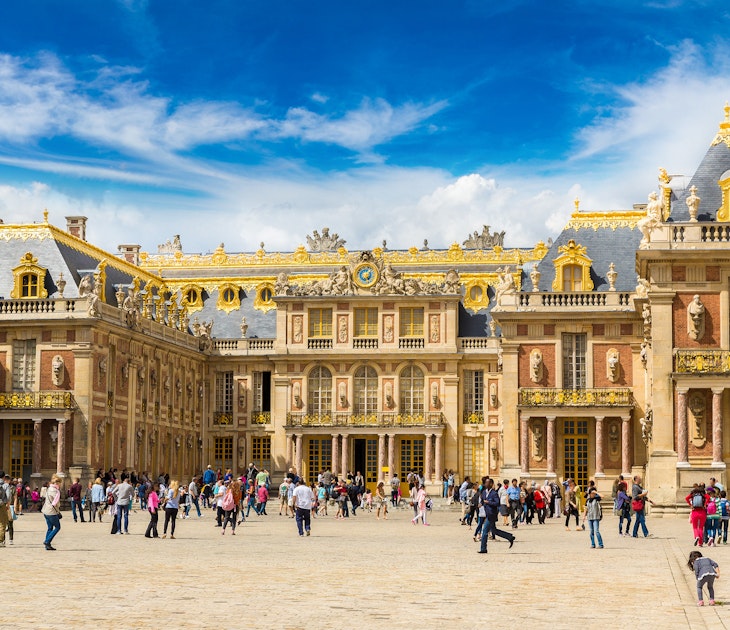
Art and Culture
Jun 1, 2023 • 3 min read
After a painstaking renovation, Marie Antoinette’s private chambers at the Château de Versailles reopen to the public on June 20.

Mar 13, 2023 • 5 min read

Sep 21, 2022 • 10 min read

Mar 30, 2022 • 4 min read

Dec 20, 2019 • 1 min read
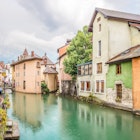
Aug 9, 2024 • 8 min read

Aug 1, 2024 • 6 min read

Jul 1, 2024 • 6 min read

Jun 21, 2024 • 9 min read

May 23, 2024 • 7 min read
- Skip to main content
- Skip to header right navigation
- Skip to site footer
Luxury Travel Blog
The Unpretentious Guide to Luxury Travel
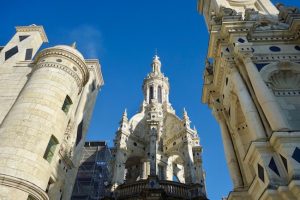
Loire Valley castles itinerary, the best French chateaux to visit
This post may contain affiliate links.
Table of Contents
If you’re wondering how to visit the French chateaux of the Loire Valley, look no further. Here is everything you need to know to plan your Loire Valley castles itinerary, including the best chateaux to see, where they are and how to get there.
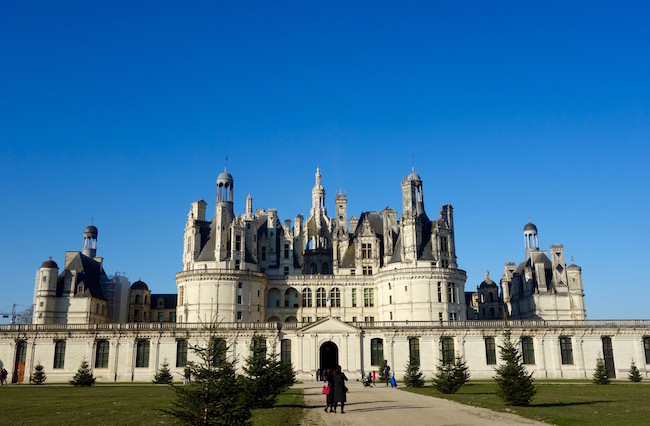
Loire Valley castles itinerary – what you need to know
Exploring the fabulous castles of the Loire Valley is one of the highlights of a trip to France. Less than two hours southwest of Paris, these historic chateaux were once the haunts of kings, queens and noblemen, and only Versailles can top them for grandeur. With elaborate gardens, graceful architecture and lavish interiors, these sumptuous – and sometimes formidable – castles can tap the imagination of even the most jaded traveller.
But how do you know which chateaux to see or how to get there? Don’t worry. Help is at hand.
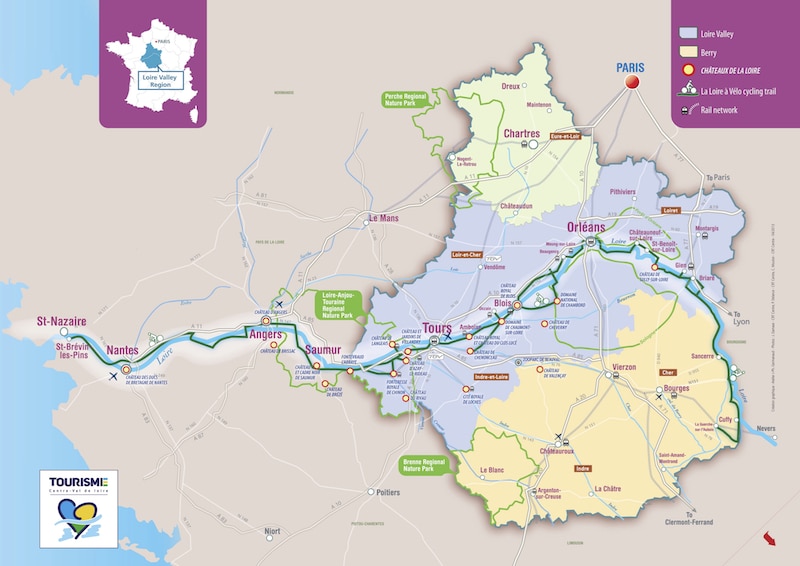
What are the best places to visit in the Loire Valley?
The best castles to visit are generally considered to be Chambord , Amboise , Cheverny , Blois and Chenonceau , but there are more than forty others and it’s worth seeing some of the lesser-traveled ones, too. It all depends on your time, budget and castle stamina.
To give you some travel ideas, here is a self-guided Loire Valley itinerary that starts in Orleans and travels down towards Tours, taking in the top chateaux in the area. It’s a relaxed pace (this is your vacation, remember?) with plenty of time to roam on your own. After all, there are wineries, walking paths and scenic towns to explore.
You can easily condense this travel plan down by a day or more. The goal? To help you plan your trip and take some of the confusion out of visiting the top Loire Valley castles. Just beware of castle burnout!
Visiting Paris? Check out my easy Paris travel guide .
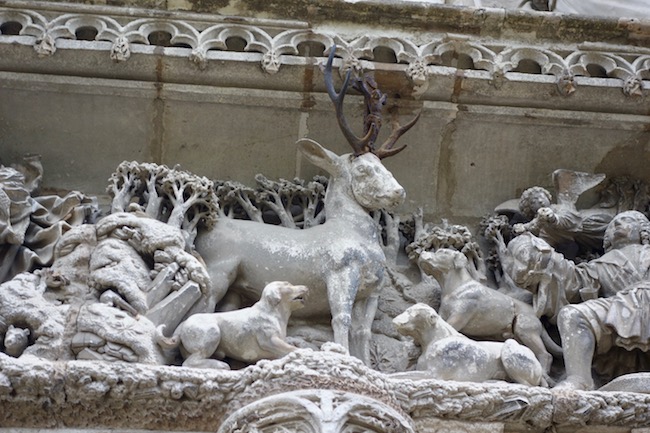
What this Loire Valley itinerary includes
- The city of Orléans
- Chateau de Meung-sur-Loire
- Domaine de Chambord
- Chateau Royal de Blois
- Chateau de Cheverny
- Chateau de Chenonceau
- Chateau d’Amboise
- Chateau du Clos Luce
- End near Tours with Chateau Villandry
How to get around
- Driving: Driving is the most convenient way to see the Loire Valley chateaux. You can rent a car in Paris or Orléans and wander through the byways, grand country palaces and wineries at will.
- Public transportation: It’s more time consuming but you can see the top sights using a combination of train, bus and/or taxi. While this itinerary is designed as a driving trip, you’ll find public transport tips for the Loire Valley castles below.
- Take a tour: Another easy way is to do a day tour from Paris or from one of the Loire cities such as Orléans or Tours.
- Day trip from Paris: You can’t see all the Loire Valley castles in a day if you’re using public transportation, but if you want to do a day trip to a particular chateau such as Chenonceau, Chambord or Amboise it’s possible.
- Cycling: Cycling the Loire Valley chateaux is hugely popular and there are bike trails to many of the chateaux. You can rent a bicycle in Orléans, Blois or Tours for example. I haven’t done it ( it’s on my list! ) but there is an entire Loire a Velo route that is 900 km. The Blois to Amboise route and Amboise to Tours routes have been particularly recommended. An electric bike is an option as well.
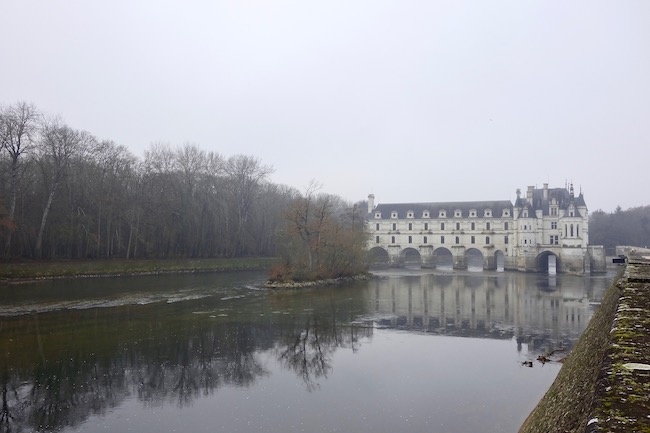
Where is the Loire Valley?
The Loire Valley is in the centre of France, a lush river valley of soft greens and fertile fields. Known as the Garden of France, it sits at a strategic point between the north and the south, stretching out for about 280 km (170 miles) along the beautiful Loire River. No wonder it has been designated a UNESCO World Heritage Site. The city of Orléans is about 125 km southwest of Paris, while Tours, further south, is approximately 235 km from Paris. Between Orléans and Tours are the towns of Blois and Amboise and some of the most popular French chateaux.
Let the Loire Valley castles itinerary begin
Day 1 from paris to the loire valley.
(Note: If you’re pressed for time you can skip Day 1 altogether and head straight to the Chateau de Chambord which is, quite honestly, unmissable.)
Getting there: Paris to Orléans. Drive or take the Intercity train from Gare d’Austerlitz in Paris to Orléans. The train takes just over an hour. Take some time to explore Orleans. Famous for Joan of Arc, the heroine who liberated the city during the Hundred Years’ War, Orleans has a picturesque Old Town, a cathedral on Place Sainte Croix with stained glass illustrating the life of Joan of Arc and romantic gardens on the southern edge of the city called Parc Floral de la Source.
You can rent a car from there. Want to stay overnight? Try the Empreinte Hotel in Orleans, a chic 4-star with a central location, a spa and a contemporary decor. 80 Qaui du Chatelete, 45000 Orleans. Tel: 33 (0) 2 38 75 10 52
If you’re eager to get on the road, move on to Chateau de Meung-sur-Loire.
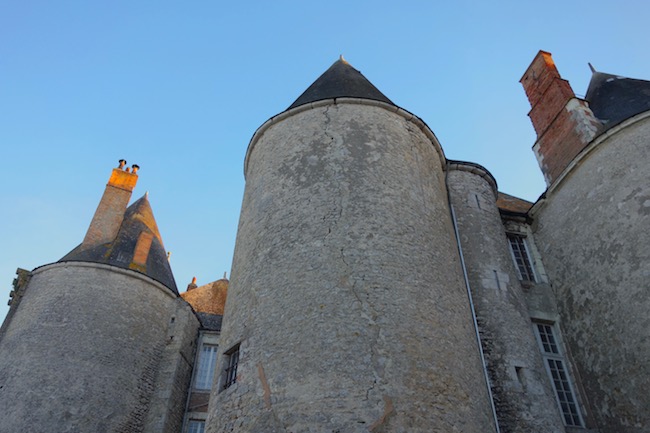
Afternoon at Chateau de Meung-sur-Loire
Start off your castle exploration with a lesser-known Loire Valley chateaux, Chateau de Meung-sur-Loire, a 30-minute drive southwest of Orléans. (16 Place du Martroi, 45130 Meung-sur-Loire.) Once the residence of the Bishop of Orléans, the castle has been rebuilt numerous times, with the oldest parts dating back to the 1100s. It was occupied by the British in the Hundred Years’ War, but retaken by Joan of Arc in 1429.
The chateau stands out because of its unique two-faced personality – one facade is medieval and the other is classical. Other highlights (or lowlights) include the underground passages and dungeon where the famous French poet Francois Villon was once held prisoner.
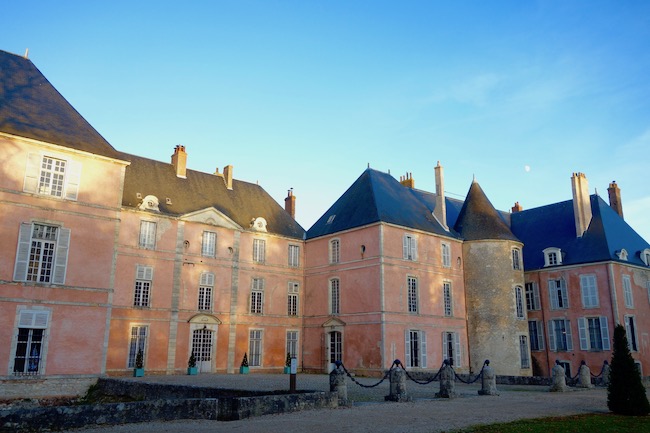
Drive to Chambord
If you’re not staying overnight in Orleans, move on for dinner and overnight at La Maison d’à Cote , 17 Rue de Chambord, 41350 Montlivault, about an hour’s drive from Orleans. Tel: 33 (0) 2 54 20 62 30.
The Loire is the Garden of France, so you might as well make the best of it and try the gourmet fare at the hotel’s Michelin-starred The House, which focuses on the best local products and ingredients. A simpler alternative is the hotel’s more casual Cote Bistro.
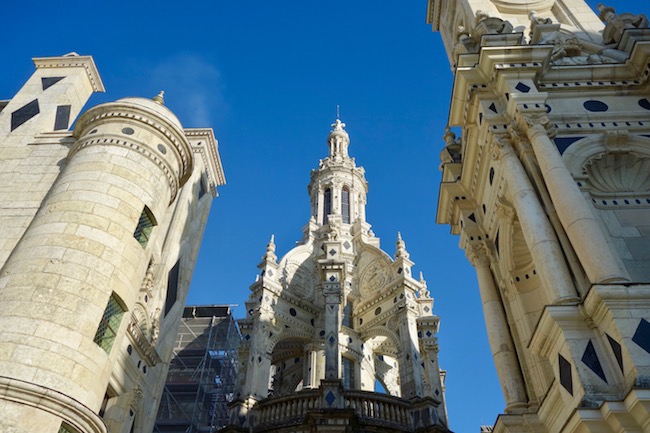
Day 2 – Morning at Domaine de Chambord
The Chateau de Chambord is the undisputed king of the Loire Valley chateaux. It’s a gleaming white Renaissance chateau that is mammoth, glorious and pretty much empty inside – but don’t let that stop you – this is probably the most visited and imposing of all the castles in the Loire. At reception you can pick up a Histopad to discover the chateau’s secret rooms and see how they would have looked back in the reign of Francois I, when 1800 workmen slaved for more than a decade to build it up from a simple hunting lodge to the mightiest of chateaux.
A standout feature is Chambord’s double helix staircase. It was designed by the artist Leonardo da Vinci, who Francois I lured over from Italy (and who brought the Mona Lisa with him). The beauty of this masterful staircase is its two spirals, which means that a king and his mistress could be going up while a queen and her lover could be going down and never the two couples shall meet. (I’m just kidding. No need to point out this never happened … I’m just saying it would be handy).
Also worth noting are the formal French garden and the vast grounds, the Domaine de Chambord, 5540 hectares of oak groves, pine forests, moors and marshes.
Stop for a snack at Biscuiterie de Chambord. It’s right near the castle so ideal for sampling their specialty, palet solognot , which are light butter biscuits stuffed with grapes and soaked in rum. I loved the raspberry and chocolate pear flavours. 30 bis, route de Chambord 41250 Maslives.
Afternoon at the Chateau Royal de Blois
With four wings of different architectural styles: Gothic, Flamboyant Gothic, early Renaissance and Classical, the Chateau Royal de Blois is a popular stop on the French castle trail, and only a 30 minute drive from Chambord. A favoured residence of no less than 10 queens and seven kings, Blois Chateau has a royal (and grizzly) history. Don’t miss the King’s Bedchamber where the Duke of Guise was murdered at the orders of King Henry III in 1588, a terrible fallout of the Wars of Religion. (Henry III himself would be murdered by a fanatical monk less than a year later.)
Other rooms to visit include the Queen’s Bedchamber where the notorious queen, Catherine de Medici, took her last breath in 1589. In the Council Chamber you can see a series of paintings illustrating the Wars of Religion.
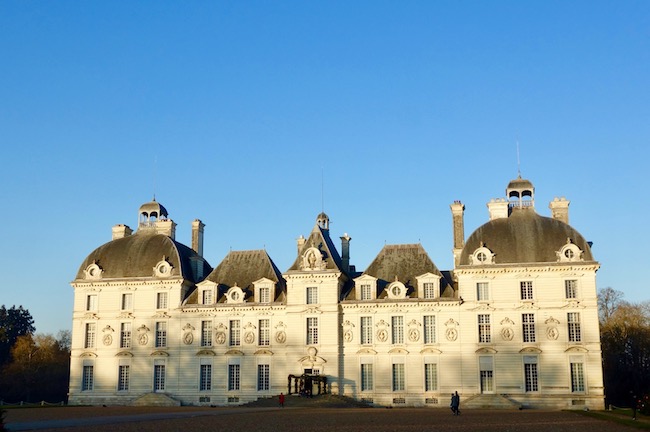
Drive to Cheverny
For a home away from home stay overnight at the suites at Domaine de Cheverny, modern luxury vacation apartments that back right onto the chateau grounds. 11, avenue du Chateau, 41700 Cheverny . Tel: 33 (0)2 54 79 05.
For dinner try Les Trois Marchands, a comfortable bistro that has been serving classic French food in the little town of Cours-Cheverny since 1850. 1 Place Victor Hugo, 41700 Cour-Cheverny, France.
Day 3 Morning at Chateau de Cheverny
Chateau de Cheverny has gone to the dogs, but that’s okay. The 100 hunting dogs are as much part of chateau life as the grand salons, twin towers and exquisite interiors of this much eye-catching castle. What is special about Cheverny is the warm atmosphere created by the aristocratic owners who still live in one wing, and its interior is unparalleled. It was also the model for Captain Haddock’s Chateau Moulinsart in the Tintin comic series. An interactive exhibit with scenes from the comics in a separate building is good family fun.
While you’re there, don’t miss the chance to taste some of the Loire Valley’s renowned wines. You can do a high tech tasting across from Chateau Cheverny at Maisons du vin de Cheverny 1 Avenue du Chateau, 41700 Cheverny.
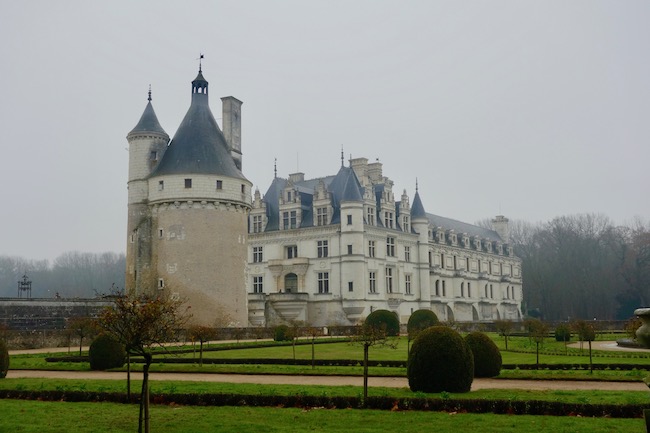
Afternoon at Chateau de Chenonceau
Drive to the Chateau de Chenonceau in Touraine (about 45 minutes). It’s hard not to fall in love with the graceful Chateau de Chenonceau . Known as the Ladies Castle, it’s a fairytale vision of turrets and peaks with an arched bridge over the River Cher. Beloved by both the mistress of Henri II, Diane de Poitiers, and his wife, Catherine de Medici, Chenonceau was wrestled out of Diane de Poitiers’ hands after the death of the king by Catherine, who put her own stamp on the castle by adding a gallery and a three-level addition to the bridge.
Drive to Amboise
Amboise is an appealing town about 2o minutes drive from Chenonceau. It’s not too big, not too small, and for my next trip to the Loire Valley I’d consider making it my base. For overnight stays you could try the Chateau des Arpentis , a chateau with a private park, 12 luxury guest rooms and a heated pool, or opt for something right in town such as the Manoir St Thomas , a chateau-style B&B with an outdoor pool.
Day 4 Morning at Chateau Royal d’Amboise
The popular Renaissance castle, the Chateau d’ Amboise , is famous for its connection to Leonardo da Vinci who moved to the town of Amboise to escape a turbulent Rome in 1516. Located right above the Old Town, this large French chateau overlooks the Loire River and was of such strategic importance that Charles VII appropriated it after its owner, Louise d’Amboise was accused of treason. In a bizarre tragedy, Charles VII would then go on to hit his head on a lintel of the castle – an accident that ended his life.
Don’t miss the chapel on the castle grounds that houses the tomb of Leonardo da Vinci.
Stop for lunch at the cozy Bigot Cafe and patisserie. You’ll find it right at the bottom of the ramp that leads down from the castle exit. 2 rue Nationale, 37400 Amboise.
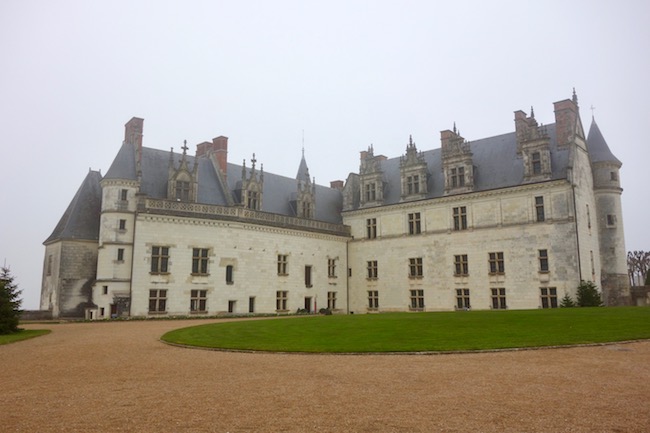
Afternoon – Visit the Chateau du Clos Luce
Just 400 metres from the Chateau d’Amboise is the Chateau du Clos Luce, the stately manor that Francois I provided for Leonardo da Vinci. The 16th-century building of red brick and local tufa stone is built on a much smaller scale than the royal Chateau of Amboise, but it still comes complete with ramparts, a watch tower and chapel. The interior has been restored to it’s rich Renaissance glory, while exhibits both inside and on the grounds offer a peek at the life and ideas of this brilliant master artist and inventor.
Drive to Tours
Tours is about 25 km from Amboise so not a long trip. If you want to stay overnight in Tours, La Maison Jules B&B is designer chic and located conveniently near the train station. 45 rue Jules Simon 3700 Tours 33 (0) 6 83 84 71 22. Another option is the elegant Hotel Oceania .
Day 5 Chateau de Villandry
Tucked in between the Loire and Cher Rivers, the Chateau de Villandry is famous for its three-level gardens, a refreshing mix of lime trees, fountains, reflecting pools, herbs, vegetables and themed areas including the Music Garden and the Garden of Love. One of the few Loire Valley gardens open year round, it’s a top chateau stop for lovers of greenery and only a 20-minute drive from Tours. The chateau itself was completed in the 1500s and was the last great Renaissance chateau to be built along the Loire.
Depart for Paris
If you’re taking the train from the Loire Valley to Paris, you can catch the TGV (high speed train) from the Gare de Tours.
Loire Valley Itinerary travel tips
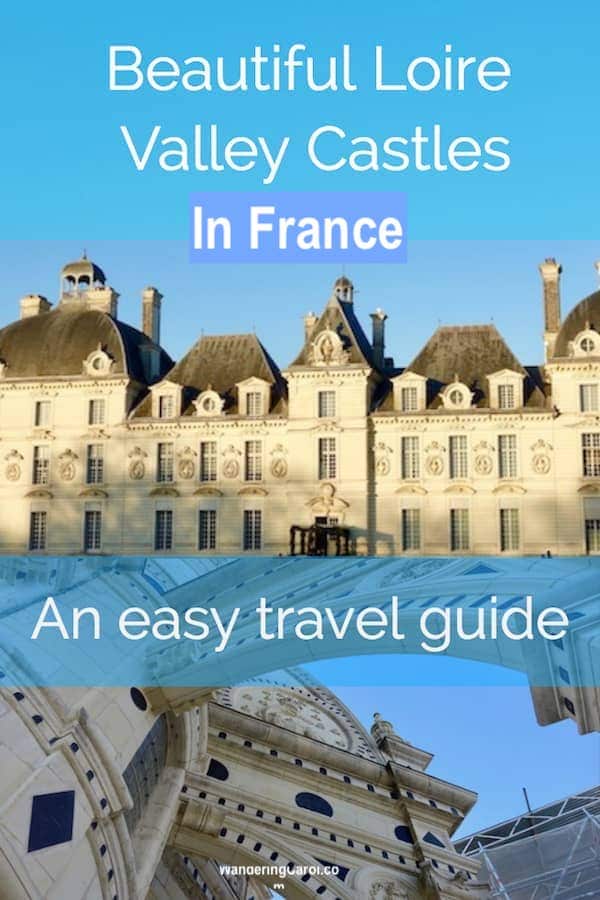
How to see the Loire Valley by public transportation
If you combine these ways to see the Loire Valley castles by public transport below, you’ll see most of the top chateaux. Or, mix and match the routes below to create your own Loire Valley chateau itinerary.
Option 1: Base yourself in Blois
From Blois you can take the Navette Chateaux excursion bus. This is a seasonal bus that does a Circuit des Châteaux from Blois train station (Gare SNCF) and stops at four different chateaux: Blois, Cheverny, Chambord, and Beauregard. The cost is 6 euros for a day pass and includes a small admission discount for the chateaux. The bus leaves from Blois-Chambord train station every day from the beginning of April to beginning of November at 9:30 and 10:10 am.
- How do you get to Blois-Chambord from Paris? You can take a train from Gare Austerlitz. The fastest train to Blois-Chambord is direct and takes just under an hour and a half.
Option 2: Base yourself in Amboise
Base yourself in Amboise. Chateau d’Amboise is right in the town, as is Close du Luce. You can take a direct bus from Amboise to Chenonceau. Visit the Tourist Information Centre in Amboise for more information.
- How do you get to Amboise from Paris? You can take a train from Gare Austerlitz. The fastest train is direct and takes 1 hr 22 minutes.
Option 3: Base yourself in Tours
Stay in Tours to visit Chateau de Villandry. You can drive or take a taxi to the chateau, which is outside the city. A cheaper alternative is to take the Fil Bleu shuttle bus to the chateau that goes daily in July and August. To get to Chenonceau from Tours, you can take a TER train that leaves Tours and stops outside the castle entrance.
- How do you get to Tours from Paris? A high speed TGV train leaves from Paris Montparnasse Station for Tours. It only takes 35 minutes.
Getting from Orleans to Tours by train : A regional train travels from Orleans to Tours (or vice versa) with stops in Blois and Amboise.
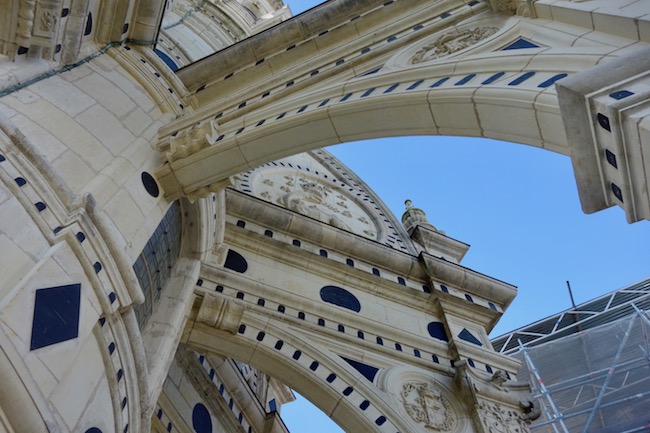
Can you see the Loire Valley castles from Paris in a day trip?
Yes, but not many of them unless you do a tour. Here are a few examples:
Paris to Chateau de Chenonceau: The fastest train from Paris to Chenonceau is 1 hr 46 minutes and requires a change at St-Pierre-des-Corps. The chateau isn’t far from the train station.
Paris to Chateau de Chambord : You could take the train from Paris Austerlitz station to Blois-Chambord. It takes about 1 hour 30 minutes, and then you could take the shuttle from the station to Chambord, which runs from April to November. Otherwise it’s about a 25 minutes taxi ride.
Paris to Chateau d’Amboise: The fastest train from Paris to Amboise is 1 hr 22 minutes but the average travel time is closer to 2 hours. There are a few direct trains but most require a change in St-Pierre-des-Corps so check the schedule before you go. The chateau is right in town.
Doing a day tour of the Loire Valley castles from Paris Get Your Guide has a number of tours (I’m an affiliate). You can access the search page for Loire Valley day tours here .
Entrance price for Loire Valley castles as of 2018. (High season)
- Chateau de Meung 9€ adult; student 7.50; child 5; under 5 is free
- Chateau de Chambord 13€ adult; under 18 is free
- Chateau de Chenonceau 14€ adult; children 11, under 7 is free
- Chateau d’Amboise 11.70 € adult; student 9.20; child 7.20; under 7 free
- Chateau Villandry 11€ adult; children and students 7€; under 8 free
- Close du Luce 15:50€ adult; children 11€; under 7 free
When is the best time to visit the Loire Valley chateaux?
If you’re travelling by public transportation, it’s easier in spring, summer and fall as the special shuttles are seasonal. Christmas in the Loire Valley Chateaux is magical, with each castle outdoing itself with the festive decor.
Check the chateau websites for opening times as they change during low season.
I was invited by Atout France and Val de Loire Tourism who arranged this fabulous Loire Valley castles itinerary for me, but all opinions and castle love is my own. Visit their websites to help you further plan your Loire Valley trip. For more places to explore visit my Things to do in France page.
Sharing is caring!
About Carol Perehudoff
A former freelance travel columnist for the Toronto Star, Carol has won more than 30 writing awards and honours. A spa and luxury travel expert, she’s written for top travel publications around the globe.

Reader Interactions
I cannot believe I missed such fantastic places on my visit to Paris few years ago. I would’ve really loved to visit Chateau Royal d’Amboise, just look at the architecture of that place! And also, Loire Valley. I am such a castle-lover, these places should’ve been the obvious ones to include in my itinerary. Well, I guess I don’t have a choice but to return one day and explore France better!
I saved this article as soon as I read the word ‘castle’ on the title. That shows how much I love castles :)) While I think Paris is beautiful, on each visits I couldn’t wait to getaway from the hustle bustle big city and prefer to explore the country side. That’s why I really love the detailed Loire Valley castles itinerary you shared here. With just a mere 2 hours away, I can get my daily dose of castles fixed, haha! I’m particularly interested in The Chateau de Chambord and Chateau de Chenonceau. Thanks for sharing this, Carol!
That is an amazing post on the castles of Loire Valley. Each one is simply amazing in grandeur and architecture. We would love checking all of these while doing a roadtrip. Your pictures are amazing.
I was there during the Christmas season, Rosemary, and the decorations were unbelievable, especially the flowers.
Yes, our Loire Valley trip was beautifully organized by the Val de Loire tourist board so I thought I would make use of the itinerary and share it.
Thanks, Linda. I hope it’s a helpful guide.
A road trip, a valley, and French castles – you are giving me a serious bout of wanderlust. I agree, Chateau de Chambord is the undisputed king of the Loire Valley castles. The palet solognot from the local bisquiterie sounds delicious too. Thanks for the tips for seeing the castles by public transport or on day trips from Paris but a 4-day road trip sounds much nicer.
These chateaus look absolutely delightful fairy tale setting. When I visited these castles several years back, it was a little haphazard and unplanned way. Your post sounds like a wonderful guide. Definitely useful one.
This is a great guide of the Loire Valley. Iv’e been there several times and have not visited even half of the castles you mention here. You are right about castle burnout. The goal is to take each one at a time and fully appreciate it’s unique history. Great tip about going during the Christmas season. For some reason, I thought they would be closed. Good to know they are not for my next trip to valle de la loire.
Thanks Danik. Road trips in France are the best. I agree.
Hi Alouise, I wrote this Loire Valley itinerary because a reader asked how to get around the area and what to see, as she wanted to go but didn’t know where to begin. I hope it comes in useful to visitors to France.
Hi Susan, Your comment makes me want to do a travel article on the homes of Catherine de Medici! My husband and I rented a car in the Cevennes, a mountainous area of France and while some of the mountain roads were hairy, it was a great experience and you wouldn’t have the problem in the Loire Valley. It depends on how comfortable you are driving.
These castles in the Loire Valley look beautiful. I love the detailed itinerary you gave, including public transit information. It seems like five or six days is the perfect amount of time to tour the Loire Valley and not get castle burnout (something I didn’t believe in until I went to Ireland).
Hi Carol! These chateaus look absolutely fairy tale dream-like. I have an obsession with Catherine de Medici and to explore a place that she called home would be so amazing yet eerie at the same time. I’ve never driven in France, do you think it would be difficult to feel comfortable driving around the French countryside to explore the valley?
I love doing road trips in france and checking out castles on the way, espeically north of Paris and surrounding the capital. They are truly amazing. However I haven’t touched the Lorie Valley and now I want to get in my car and get out there. France really does do it for me. Love your photos and my lips are wet looking at this.
Leave a Reply
Your email address will not be published. Required fields are marked *
Notify me of follow-up comments by email.
Notify me of new posts by email.
This site uses Akismet to reduce spam. Learn how your comment data is processed .

Visiting the Château de Versailles: 10 Top Attractions
Written by Lisa Alexander Updated May 11, 2023 We may earn a commission from affiliate links ( )
Author Lisa Alexander spent two years living in Paris after college, enjoys returning to France as often as possible, and most recently visited Versailles in March 2023.
Step into the lavish world of France's ancien régime at the Château de Versailles. You will enter one of Europe's most dazzling castles, created for the most famous of French kings. Louis XIV resided here during his glorious reign, an epoch of absolute monarchy known as Le Grand Siècle .
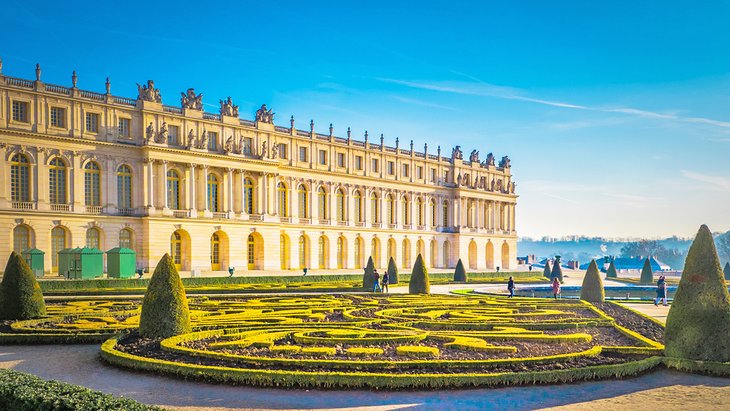
Louis XIV enlisted the renowned architect Jules Hardouin-Mansart to renovate the château of his father, Louis XIII. The Château de Versailles was transformed into a 2,300-room masterpiece of French Classicism, fitting of the new owner: "the Sun King" (" le Roi Soleil "), as Louis XIV was titled.
This incomparable château set a new standard for royal palaces, and today is designated as a UNESCO World Heritage Site .
During the reign of Louis XIV, any man with a sword and woman wearing a fine dress was allowed inside the Château de Versailles. People came to admire the magnificent interior decor and extravagant court ceremonies. Today, casually attired tourists continue to visit for a glimpse of the regal splendor.
Purchase your ticket (preferably ahead of time), wait in line, and voila , like magic, become immersed in the ambience of the 17th and 18th centuries. The ornately decorated reception halls and opulent apartments exude decadence. You start to understand the over-the-top lifestyle that went along with being the king and queen of France.
With your admission ticket to the Château de Versailles, you may visit a limited number of rooms. On a good day, your tour of Versailles might resemble an orderly parade of courtiers through the King's State Apartments. On a bad day (especially during high season), the mass of visitors may seem more like the mobs of the French Revolution. Whatever the crowds, Versailles is a must-see.
The domaine (estate) of the Château de Versailles covers over 800 hectares; this vast parkland is open to the public. Much of the palace may be visited by ticket holders.
It would take several days to cover everything at Versailles. With the Palace Ticket admission, you will see the famous Hall of Mirrors and other state reception rooms. You can also choose additional tickets that allow you to see different areas of the estate, such as the King's Private Apartment or the Domaine de Trianon (where Marie-Antoinette's hamlet is located).
Read our guide to learn more about the Château de Versailles and how to spend your time within this marvelous realm.
1. Hall of Mirrors (Galerie des Glaces)
2. king's state apartment (grand appartement du roi), 3. queen's apartment (grand appartement de la reine), 4. king's private apartment (appartement intérieur du roi), 5. the gardens (les jardins), 6. domaine de trianon, 7. le hameau de la reine (the queen's hamlet), 8. chapelle royale, 9. opéra royal, 10. galeries de l'histoire du château, how to make the most of your visit to château de versailles.
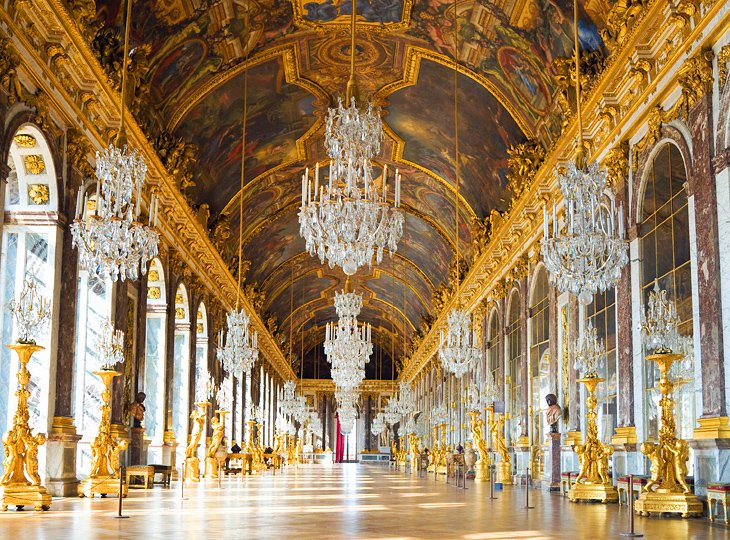
As you glide across the parquet floor of the Hall of Mirrors, try to imagine the glamour, intrigue, and opulence of court life at Versailles centuries ago. You are walking through the château's most dazzling room, where courtiers in the finest attire once waited to meet with the king and queen.
It's easy to imagine the magnificent celebrations, such as balls and wedding receptions, which took place in this room during the 17th and 18th centuries.
Look up to admire the glorious frescoed ceiling that is trimmed in gilded moldings and dripping with glittering crystal chandeliers. Peer out the windows to view the perfectly symmetrical landscaping of the formal French garden, and notice the reflection on the ornamental mirrors.
Three hundred mirror segments adorn the walls. At the time, mirrors were a luxury item. The visual effect is stunning.
Architect Jules Hardouin-Mansart created this Baroque gallery between 1678 and 1684. Mansart succeeded in achieving an ambience of grandeur that Louis XIV envisioned.
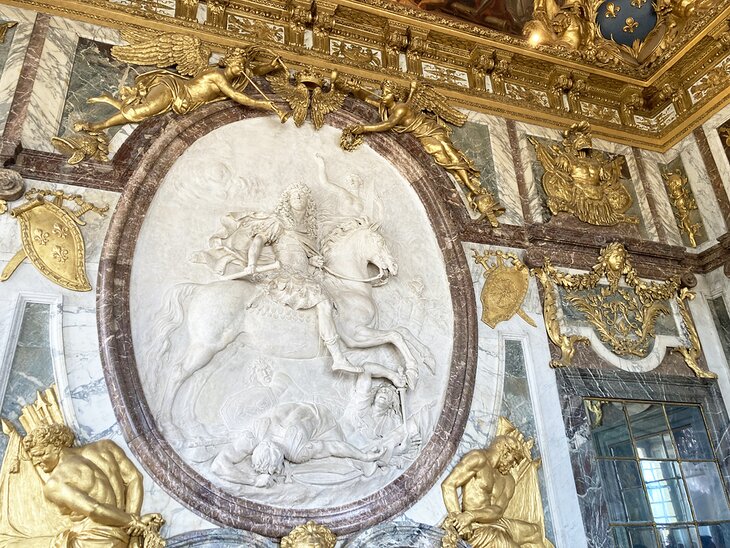
In the Hall of Mirrors, the German Empire was proclaimed in 1871 and the Treaty of Versailles was signed in 1919. At one end of the hall is the Salon de Guerre (War Salon) with paintings depicting military victories; at the other is the Salon de Paix (Peace Salon) with a ceiling painting by Charles Le Brun ( Premier Peintre du Roi ) and a portrait of Louis XVI by François Lemoyne.
For a truly memorable experience, attend the Royal Serenade held in the Galerie des Glaces every Saturday evening from mid-June through mid-September. The Royal Serenade recreates the scene of a royal court ball, complete with authentic 17th-century costumes and entertainment performed by Compagnie de Danse l'Éventail dancers and Les Folies Françoises musicians.
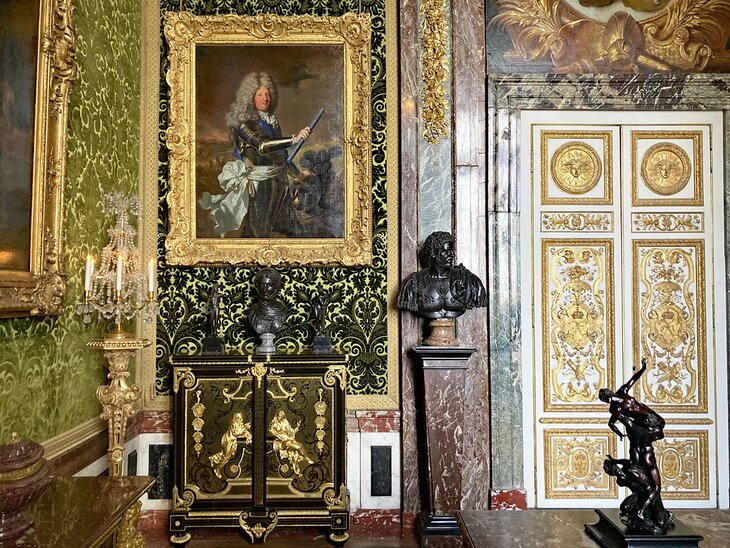
The King's State Apartment includes the royal bedchamber and other private rooms that were open to the public for daily ceremonies and official meetings.
The series of seven salons (reception rooms) was known as " L'appartement de parade " ("The parade apartment") because courtiers walked through the rooms every day before going to chapel services.
The salons are named after mythological deities, making a connection between Louis XIV's reign and the history of the Western world.
- Salon d'Hercule features one of the world's largest ceiling paintings, The Apotheosis of Hercules by François Lemoyne, as well as The Meal in the House of Simon , a masterpiece by Veronese given to Louis XIV by the Venetian Republic.
- Salon de l'Abondance is decorated with many precious objects and was where refreshments were served for evening soirees.
- Salon de Vénus shows the original marble and faux marble decor (marble walls, classical columns, and statues) that Louis XIV favored to reflect his power and glory.
- Salon de Diane displays the painting of Diana and Endymion by Gabriel Blanchard and several paintings on the theme of hunting.
- Salon de Mars is celebrated for Charles Le Brun's painting, The Family of Darius before Alexander , created around 1665.
- Salon de Mercure features a renowned ceiling painting, Mercury on His Chariot Drawn by Two Roosters , by Jean-Baptiste de Champaigne.
- Salon d'Apollon boasts a fabulous ceiling painting of Apollo in the Chariot of the Sun by Charles de la Fosse. Over the fireplace is the well-known portrait by Hyacinthe Rigaud of Louis XIV in his coronation attire (a robe featuring fleur-de-lys and trimmed with ermine).
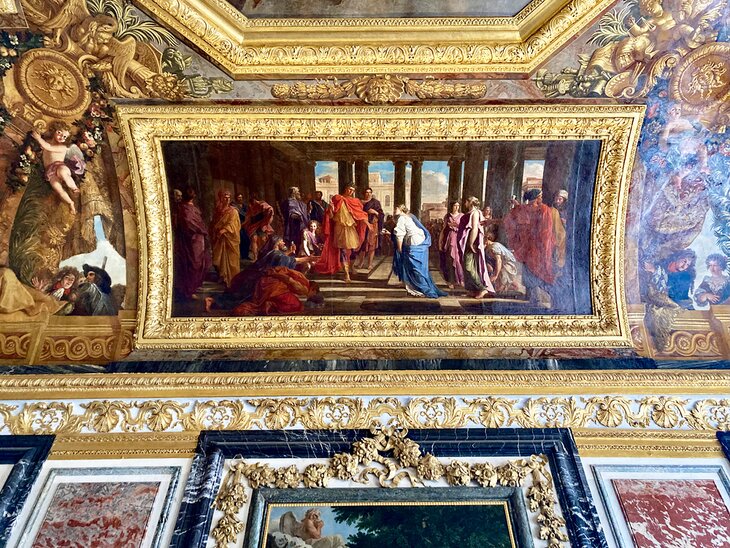
Arranged in the same layout as the King's State Apartment, the Queen's Apartment has a more feminine sensibility. The rooms are flowery and delicate in style. The decor has been preserved since the time of Marie-Antoinette.
The Queen's Apartment has recently reopened after several years of refurbishment work. The decor has been refreshed and returned to its original splendor.
- Chambre de la Reine (Queen's Bedroom): The Queen's Bedroom was created for Queen Maria Theresa (wife of Louis XIV) and updated for Marie-Antoinette. Rococo-style ceiling paintings depict the four virtues of a queen: compassion, generosity, wisdom, and fidelity. The jewelry cabinet to the left of the bed was a gift to Marie-Antoinette from the city of Paris two years before the Revolution.
- Antichambre des Nobles: This salon was Queen Marie Thérèse's antechamber. Marie-Antoinette completely redecorated the room with damask wallpaper, mahogany furniture, and a Bleu Turquin marble fireplace.
- Antichambre du Grand Couvert: In this sumptuous room, the King was served his meals according to strict protocols. The ritual was a sort of public performance in which the Royal Family would take their places at the table and once they were seated, the high-ranking duchesses and princesses were allowed to sit on stools and observe the elaborate meal.
- Salle des Gardes de la Reine (Room of the Queen's Guards): The Queen's corps of 12 bodyguards stayed in this room all day and night, to perform their duty of protecting the Queen. On October 6th of 1789 as rioters were trying to push their way into the Queen's apartment, one of the Queen's guards alerted a lady-in-waiting to Marie-Antoinette. This allowed Marie-Antoinette the time to flee and saved her life.
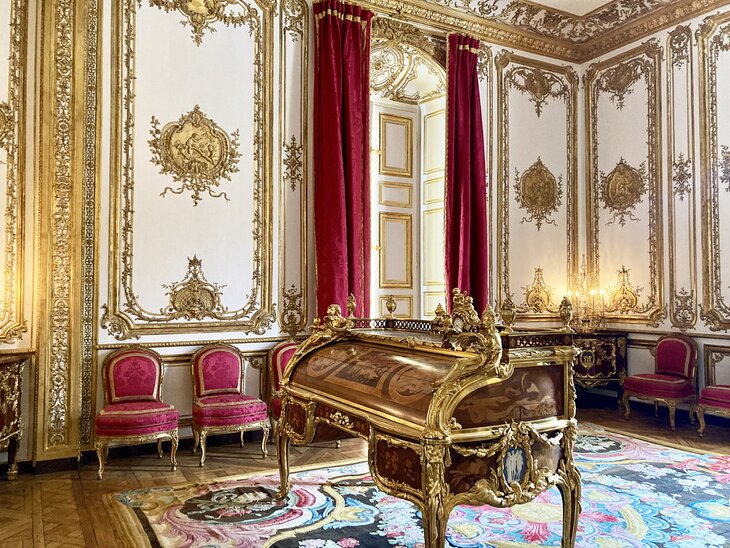
This suite of rooms provides a glimpse of the private life (including the social events) of the French Royal Family.
Note: This area of the château is accessible only by taking a guided tour. Access to the King's Private Apartment is NOT included in the standard Palace Ticket.
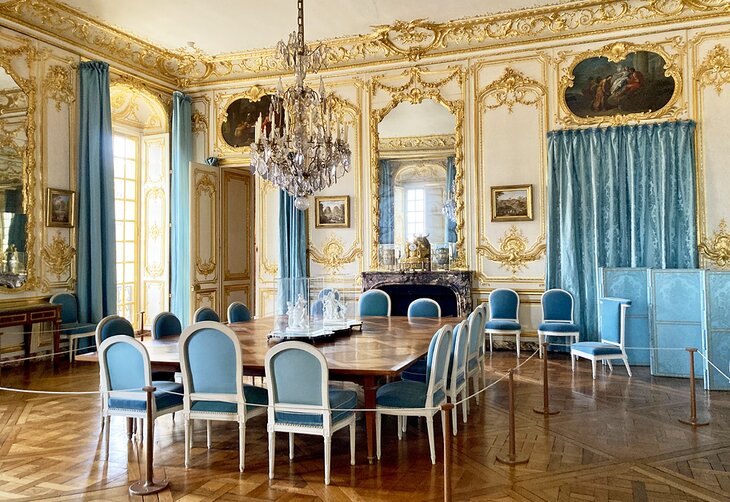
- Chambre de Louis XV (Bedroom of Louis XV): The bedchamber in the King's State Apartment was a place of formal ceremonies, from morning until night. In this smaller bedroom, Louis XV could relax and get away from the ceremonial etiquette of the court. (This room is currently undergoing renovations.)
- Cabinet du Conseil (Council Study): In this room, the king met with his ministers to discuss affairs of state. Décor includes a classical-style bust of Alexander the Great and a bronze statuette of Louis XIV supported by a mantelpiece clock.
- Cabinet d'Angle du Roi (King's Corner Room): This room contains a marquetry-paneled desk crafted for Louis XV by the renowned cabinet-maker Jean-Henri Riesener. The desk features bronze sculptural details and drawers with lock mechanisms to secure Louis XV's important papers. The desk is one of the most valuable pieces of furniture in the world.
- Cabinet de la Pendule (Clock Room): This room features a miniature version of the equestrian statue of Louis XV that stood on the Place de la Concorde before the Revolution and an astronomical clock that was created for Louis XV, who was very interested in astronomy.
- Bibliothèque de Louis XVI (Library of Louis XVI): Famous architect/interior designer Ange-Jacques Gabriel created this Rococo-style room adorned with gilded panels, a round mahogany table, and a rare piece of furniture created by Jean-Henri Riesener. Louis XVI was an extremely avid reader of literature and science books, which explains the impressive size of the library.
- Salle à Manger des Retours de Chasses (After-the-Hunt Dining Room): Louis XV hosted dinners once or twice a week in this gilded room, inviting the lords and ladies who accompanied him on hunts. Many nobles sought this prestigious invitation.
- Salle à Manger des Porcelaines (Porcelain Dining Room): Louis XVI and Marie-Antoinette had their meals here, including private dinners and official banquets. At Christmas time, Louis XVI presented gifts of Sèvres porcelain here (explaining the name of the room).
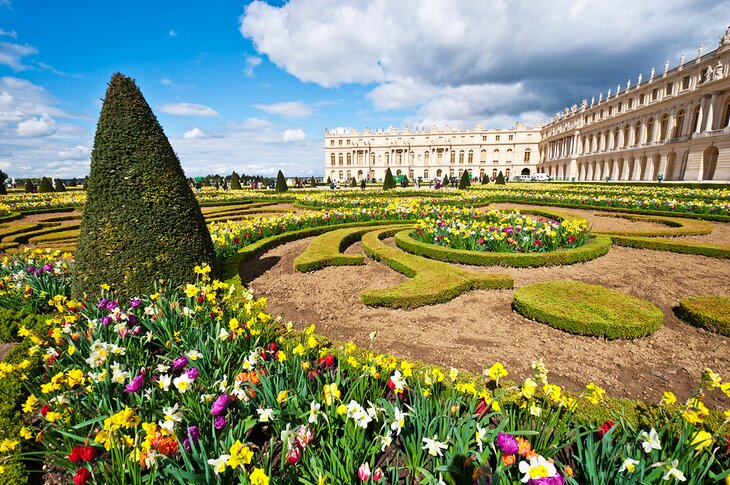
More like a piece of artwork than a scene of nature, these are no ordinary gardens. Perfectly trimmed shrubbery and tidy lawns form geometric patterns, characteristic of French formal gardens. Decorative pools and fountains balance the greenery, while bright flower beds and sculptures add further adornment.
Les Jardins are the masterwork of André Le Nôtre, the renowned landscape designer of the 17th century. Le Nôtre designed some of the most beautiful gardens in France.
Les Jardins makes its first impression with the Parterre d'Eau (Water Parterres), two ornamental pools decorated with fountains and statues. To enhance the garden's visual effect, Le Nôtre landscaped the space in a symmetrical fashion. This allowed for a sweeping view, the Grande Perspective , which stretches from the Parterre d'Eau to the Allée Royale along the garden's east-west axis.
Beyond the Parterres are Les Allées, expansive pathways that invite you to take a stroll. The Allée Royale (Royal Way) is also known as the "Tapis Vert" ("Great Lawn") and leads to the Bassin d'Apollon (Fountain of Apollo), the emblem of Louis XIV. At the center of this fountain is a celebrated statue: Apollon sur son Char ( Apollo in his Chariot ) sculpted by Jean-Baptiste Tuby, based on a design by Charles Le Brun.
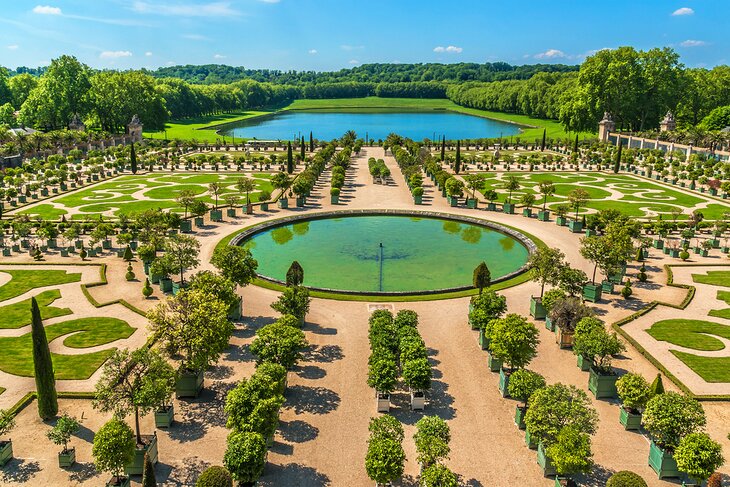
Be sure to check out L'Orangerie where Louis XIV kept orange, lemon, oleander, and pomegranate trees during the winter. Built in 1663 by Louis Le Vau, the Orangery still houses fruit trees, some of which are over two centuries old. During summertime, the trees are brought out to the Orangery parterre.
The classical Colonnade designed by Mansart is one of the most peaceful areas of the park. Farther into the park, Les Bosquets (Groves) are secluded woodland areas.
If you are visiting during spring or summer, try to attend one of the Musical Fountain shows .
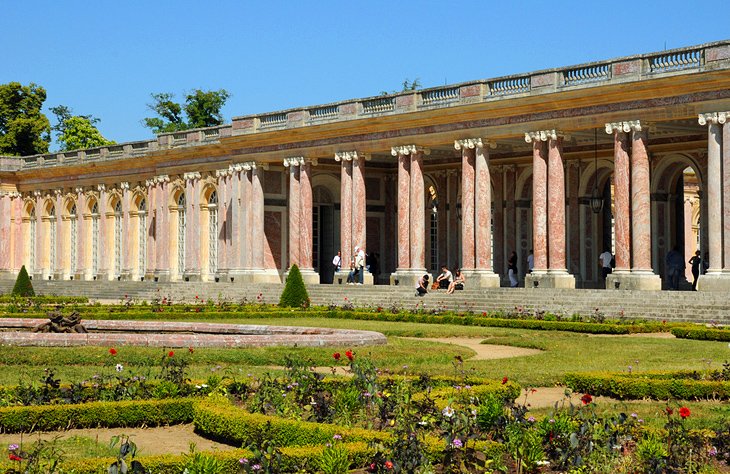
A half-hour stroll from the Chateau de Versailles leads to the Domaine de Trianon, the most refined area of Versailles. The lovely flowering gardens and delicate architectural ensemble appeal to feminine sensibilities.
Note: This area of Versailles is accessible with the Passport Ticket or the Estate of Trianon Ticket.
Le Grand Trianon is a pink marble confection created for the mistress of Louis XIV, Madame de Montespan. Louis XIV commissioned Jules Hardouin-Mansart to construct an Italian-influenced palace with exquisite features. The "Peristyle" takes your breath away, with its seemingly infinite marble columns and views over the gardens and the courtyard.
Refreshingly informal compared to the Château de Versailles, the interior decor of Le Grand Trianon is bright, cheerful, and elegant. Natural light floods the Galerie des Cotelle , with its floor-to-ceiling windows, while the walls display 17th-century paintings that depict the Versailles gardens.
The Grand Trianon palace is surrounded by delightful Jardins à la Française (French Gardens) filled with orange blossoms, roses, and tidy hedges. The gardens showcase a multitude of flower beds, planted with thousands of flowers, chosen for their vibrant colors and intoxicating fragrances.
Le Petit Trianon is a masterpiece of Neoclassical architecture, set in an expanse of greenery. Louis XV commissioned Ange-Jacques Gabriel to create this small palace for his mistress, the Comtesse du Barry. After the reign of Louis XV, the palace was gifted to Marie-Antoinette by Louis XVI in 1774. Marie-Antoinette redecorated Le Petit Trianon in her own distinctive feminine style.
Marie-Antoinette took a special interest in redesigning the landscape of the Petit Trianon estate. She commissioned Richard Mique to create a Jardin Anglais (English Garden) in the less-formal style that was fashionable at the time. This romantic garden imitates nature with meandering paths, a gently flowing stream, a waterfall, and a grotto.
A highlight of Petit Trianon garden is the Temple de l'Amour (Temple of Love), a decorative structure built in 1778 that resembles an ancient Greek temple. Marie-Antoinette's apartment looks out directly onto this monument.
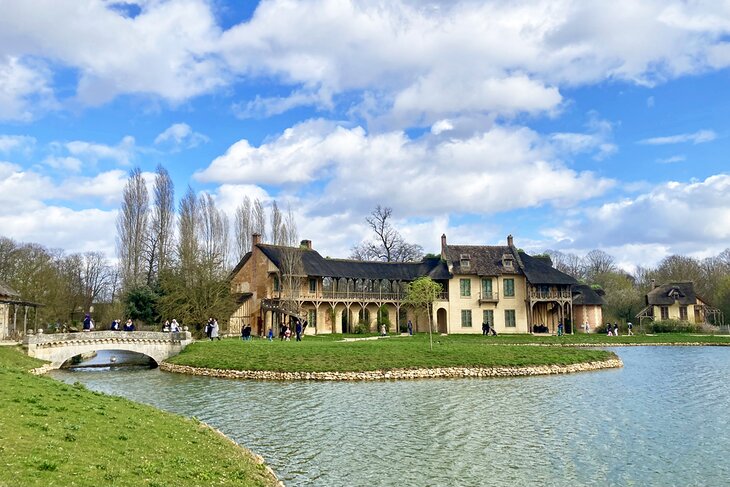
This little fantasy hamlet was where Marie-Antoinette came to escape the formalities and politics of court life. Ornamental "country" villages were a new feature of estates in the 18th century, revealing the influence of philosopher Jean-Jacques Rousseau's ideas about returning to nature.
A group of half-timbered cottages (created in 1773) at the Domaine de Chantilly was the inspiration for Marie-Antoinette's fabricated pastoral village at Versailles. About a one-hour drive away, Chantilly is one of the top day trips from Paris and is worth a detour for those interested in exploring another historic estate.
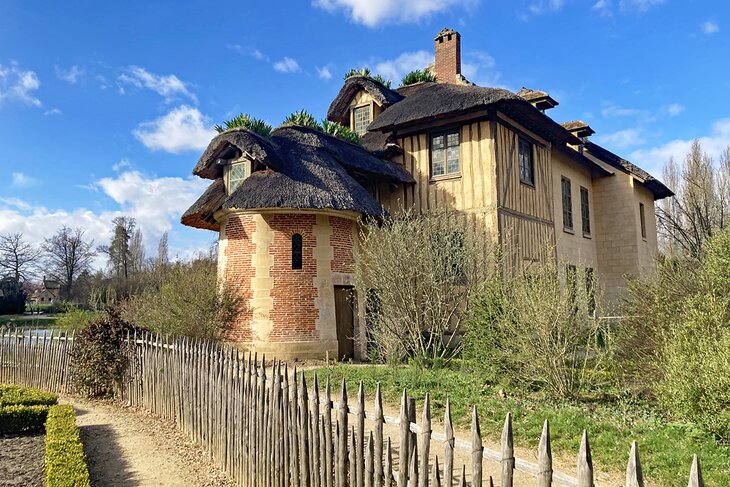
Constructed between 1783 and 1786, the Queen's Hamlet is nestled on the edge of the Château de Versailles parkland. This enchanting model village includes buildings resembling a Normandy farmhouse and thatched-roof cottages, all surrounding a tranquil lake. Behind the faux rustic facades are luxurious interiors.
A watermill, dovecote, vegetable gardens, and orchards complete the charming bucolic scene. The Queen's Hamlet maintained a working farm; a fishery with a jetty for boating on the lake; and a dairy, where Marie-Antoinette sampled products from the farm.
Marie-Antoinette hosted parties and informal social gatherings at the hamlet. A billiard room, game room, dining room, and an enormous kitchen attest to the entertaining that took place here. The Queen also used the farm for educational purposes, to teach her children about the natural world.
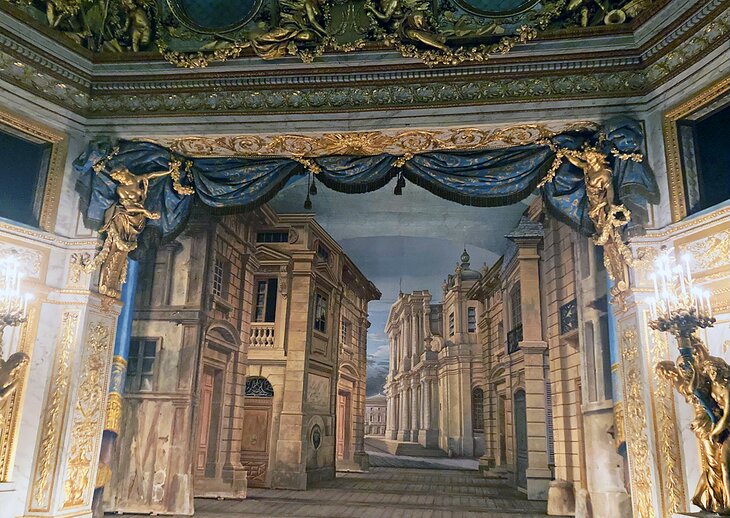
The Queen's Theatre (Le Théâtre de la Reine) is tucked away behind the garden of Le Petit Trianon. The architect of the Queen's Hamlet, Richard Mique, created this little gem of Louis Seize architecture between 1778 and 1780.
The theater is quite small and intimate. What it lacks in size is compensated for in magnificent décor. You will be surprised by the lavish interior, a contrast to the simple classical-style exterior.
Marie-Antoinette had a passion for theater, which she pursued at this one. She commissioned playwrights to create new works, and she even performed in comedy productions that were staged just for her friends. Most notably, in 1785 Marie-Antoinette played the part of Rosine in Barbier de Séville by Beaumarchais.
The theater has been recently renovated and its décor has been well-preserved, down to the most minute details. Stepping into this theater immerses you in the culture of the 18th century. You can almost imagine Marie-Antoinette appearing on stage.
Note: You may only visit the Queen's Theater on Les effets scéniques au théâtre de la Reine guided tour (currently offered as a French-language tour).

The Chapelle Royale at Versailles was begun by Jules Hardouin-Mansart in 1699 and completed by Robert de Cotte in 1710. This masterpiece of Baroque architecture blends a Gothic-inspired exterior and stained-glass windows with a serene Neoclassical nave. Supported by soaring columns, the nave's vaulted ceiling features paintings on the theme of the Holy Trinity.
Louis XIV used this chapel when it was opened in 1710. Previously, he worshiped in a chapel on the site of the Hercules salon. Every morning at 10am, the court would attend Mass. The gallery reserved for the King and royal family is the one with a tall Corinthian colonnade.
Note: The Royal Chapel is only open to the public on the Splendorous Versailles guided tour. However, you do have a chance to see the balcony of the Royal Chapel with Palace Ticket admission.
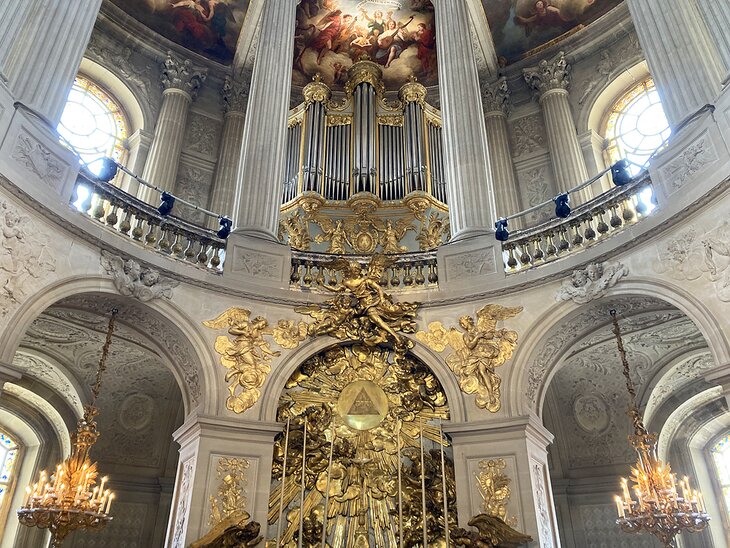
You may also see the interior if you attend one of the concerts that are held here. The Royal Chapel stages recitals of sacred music, such as Bach's Mass in E Minor, Handel's Messiah, and Mozart's Requiem. Many concerts make use of the chapel's Clicquot organ.
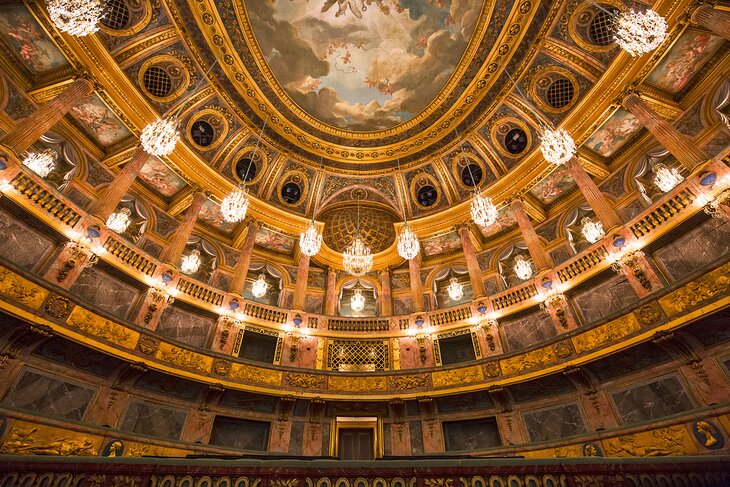
This glorious Opera House is one of the most beautiful of its kind. Designed by Ange-Jacques Gabriel for Louis XV, the auditorium was completed in 1770 just before the marriage of (the future King) Louis XVI to Marie-Antoinette, whose wedding reception was held here.
The Opera House features a harmonious Neoclassical colonnade of Ionic columns. The lavish interior is ornately decorated, with gilded bronze, marble, mirrors, and chandeliers.
Today, the Opera House hosts an impressive calendar of events throughout the year, including theater, opera, ballet, and music performances.
Note: You may visit the Opéra Royal by taking the Splendorous Versailles guided tour.
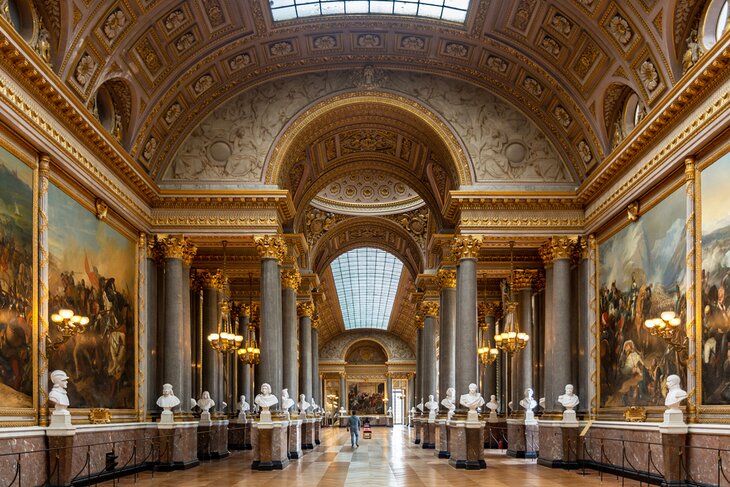
After the 1830 Revolution, the restored monarch Louis-Philippe ("King of the French") decided that the Château de Versailles should have a museum. Louis-Philippe commissioned the architect Frédéric Nepveu to create the galleries, which opened on June 10th, 1837. Victor Hugo, Alexandre Dumas, Eugène Delacroix, and other French luminaries attended the inauguration event.
Louis-Philippe had assembled a collection of paintings, sculptures, and drawings that illustrate French history dating back to the Crusades. Napoléon III later added new acquisitions to the collection related to 19th-century history.
The Galerie de l'Histoire du Château (Gallery of the History of the Palace) displays historical artifacts from specific time periods. Particularly interesting, the Salles des Croisades are devoted to the history of the Crusades from the 11th century through the 13th century.
Other noteworthy galleries include the Salle de 1792 , which shows the history of the French Revolution through a series of paintings, and the Salles de l'Empire , which commemorates the achievements of Napoléon I.
- How to Get to Versailles : You can reach Versailles from Paris by public transportation. It's best to take the train to the Versailles Château Rive Gauche station (about a 10-minute walk to the entrance of the Château de Versailles) rather than the Versailles Chantiers station, which is farther away (about a 30-minute walk to the château entrance).
- Easy Day Trip from Paris : Enjoy the convenience of a guided tour with transportation from Paris to Versailles. This takes the hassle out of getting there, plus you benefit from interesting commentary.
- Take a Guided Bike Tour : Explore the domain of Versailles by bicycle on an organized bike tour that includes round-trip transport from Paris and suggestions for a picnic lunch.
- Avoid the Crowds : The only way to avoid crowds at Versailles is to visit during wintertime . Unfortunately, the gardens are not beautiful at this time, but you will be able to walk around the château at your own pace (rather than being pushed by the crowds).
- Timing : Plan to spend about two to three hours inside the château. If also visiting the King's Private Apartment, note that the guided tour takes an additional one hour and 30 minutes. Allow two hours in the gardens and at least another two hours to explore the Trianon palaces and the Hamlet (the walk to this area takes about 30 minutes from the château).
- Book Ahead to Skip the Lines : To skip ahead of the ticket line, buy tickets online in advance. Simply proceed to Entrance A by providing the printout of your prepaid ticket. Due to the high number of visitors, it is essential to book tickets in advance most of the year.
- Ticket Options : Château de Versailles offers various ticket options: The "Palace Ticket" includes entry to the Hall of Mirrors, Grand Appartement du Roi, and Grand Appartement de la Reine. The "Estate of Trianon Ticket" includes entry to the Grand Trianon, the Petit Trianon, and the Queen's Hamlet. The "Passport Ticket" option allows entrance to the sights included in both the "Palace Ticket" and "Estate of Trianon Ticket" options.
- Reserve an Audioguide: You may reserve an audioguide (available in 12 languages) in advance, by booking online.
- Guided Tours: To gain access to the King's Private Apartment , the Royal Opera House or the Royal Chapel, you must take a guided tour (available in English and French). Guided tours of the Petit Trianon and the Hamlet of Marie-Antoinette are available in French.
- To avoid waiting in a long line, you should book a free Palace Ticket and/or Estate of Trianon Ticket at a specific time.
- Public Gardens : The grounds of the château, including the gardens and the 800-hectare domaine of the estate, are open to the public; there is no admission fee, except when Garden Shows take place.
- Summertime Garden Shows: During summer, stroll through the Versailles estate while enjoying Garden Shows (tickets required). Garden Shows include Musical Fountains on weekends; Musical Gardens during the week (Tuesday through Friday); and Night Fountains (with fireworks) on Saturday evenings and on July 14th and 15th. Some of the Garden Shows are also held during springtime and autumn. Be sure to check the schedule.
- Restaurants & Cafés in the Château: Within the Château de Versailles, you will find the Grand Café d'Orléans cafeteria (accessible via Cour des Princes); Ore café (Dufour Pavillion, access via Cour d'Honneur) open for casual breakfast, lunch, pastries, and snacks; and Angelina tea salon (with snack counter), famous for pâtisserie and hot chocolate (accessible via Cour Royale or after the Grands Appartements).
- Lunch & Snacks in the Gardens : For casual outdoor dining and picnics, try Angelina's summertime food stand at the Petit Trianon; the Girandole Café (sandwiches, crepes, salads) in the Girandole Grove; Le Dauphin (crepes, ice cream, snacks) in the Dauphin's Grove; and La Flottille take-away stand (sandwiches, crepes, salads) and tearoom near the Grand Canal.
- Fine Dining at Versailles: If you have the time and would like to indulge in a gastronomic meal, there are several options at Versailles: Ore restaurant, created by renowned French chef Alain Ducasse, serves haute cuisine inspired by historic meals, using the porcelain dinnerware designed for Marie-Antoinette. In the gardens, La Petite Venise offers Italian cuisine in a romantic dining room. For the ultimate Versailles experience, dine at the Michelin-starred Le Grand Contrôle restaurant at the luxury hotel next to the château.
- Deluxe Lodging at Versailles : Treat yourself like royalty, by spending the night at the new five-star hotel on the estate of Versailles. At Airelles Château de Versailles - Le Grand Contrôle , you step into the footsteps of 17th- and 18th-century aristocrats and courtiers. The renovated building next to the Château de Versailles has been exquisitely refurbished with authentic period decor. Highlights include exclusive tours, a spa with indoor pool, and a Michelin-starred restaurant that channels the banquets of French kings.
- Château de Versailles, Place d'Armes - 78000 Versailles
- Official site: http://en.chateauversailles.fr/homepage

More on France

- Style + Design
- Real Estate
- Discoveries
- The Galerie Artist Guide
- Creative Minds
- Life Imitates Art
- Galerie House of Art and Design
- Advertising
Follow Galerie
Sign up to receive our newsletter.

10 of the Most Magnificent Châteaux in France
Tour the most ornate castles worth dreaming about visiting right now.
While Paris might be one of the biggest draws to France, the countryside and its stately manors stand their own ground, too. From the 15th to the 18th centuries—during the country’s Ancien Régime— noble families hired the top architects of the day to design ornate châteaux, sometimes as a permanent residence and sometimes as a vacation home or hunting lodge. Today, many of these elaborate palaces have been preserved, designated as landmarks, and transformed into museums. Here, we round up ten of the most beautiful châteaux in the country.
Château de Chambord
In the 16th century, King Francis I commissioned architect Pierre Nepveu to build this 200,000-square-foot château —the largest in the Loire Valley—as his private hunting lodge. Designed in the French Renaissance style, the enormous palace, which boasts 335 fireplaces, was a symbol of his wealth and achievement. Its iconic double-helix grand staircase was inspired by Leonardo da Vinci.
Château de Chenonceau
Built over the Cher river, the Château de Chenonceau as it’s seen today was built in two phases by architects Philibert de l’Orme and Jean Bullant in the mid-16th century. Original construction was overseen by Katherine Briçonnet, the wife of Thomas Bohier, Chamberlain of Charles VIII, while Henry II’s mistress Diane de Poitiers oversaw the second phase. Over the centuries, the palace became the property of a number of notable women, including Catherine de’ Medici.
Recommended: 8 Former Palaces Turned into Luxury Hotels
Château de Versailles
Versailles might be an obvious choice for this list, but there’s no denying that it’s one of the most stunning palaces not just in France, but in the entire world. Though Louis XIV brought the château to its highest levels of grandeur during the second half of the 17th century, it was Louis XIII who originally built a much more modest hunting lodge on the site, some 40 years earlier.
Château du Champ de Bataille
While many of the grandest French châteaux are located in the Loire Valley, this mid-17th-century palace is in Normandy. After interior designer Jacques Garcia purchased the property in 1992, he began restoring the château’s extraordinary gardens, and while they are still a work in progress, they have been named one of the Notable Gardens of France by the French Ministry of Culture.
Château de Fontainebleau
This palace was a royal residence for eight centuries, housing heads of state from Louis VII to Napoleon III. The first castle on the site was built in the 12th century, but only the donjon, which houses the King’s apartments, remains from that original structure. Architect Gilles le Breton expanded the château under Charles VI, while subsequent expansions occurred under Henry II, Henry VI, and Louis XIII.
Recommended: Your Ultimate Guide to Buying a Classic French Château
Château de Valençay
Construction on this château, in the region of Berry, began in the mid-16th century by French lord Jacques d’Étampes de Valençay, but it wasn’t completed until the 18th century. Napoleon’s foreign minister, Charles Maurice de Talleyrand, inhabited the palace during the early 19th century. The château exhibits a combination of Renaissance and French Classical architecture.
Château d’Ussé
Rumored to have been author Charles Perrault’s inspiration for the castle in The Sleeping Beauty, as well as Walt Disney’s inspiration for his animated castles, this château has a long history. While the original fort on the estate was built in the 11th century, the castle was rebuilt in the 15th century, with expansions and renovations occurring over the next two centuries.
Château de Villandry
Jean Le Breton purchased these lands in the 16th century and built the château around a former 14th-century fort. Today, the palace is known for its Renaissance gardens, which were restored by Joachim Carvallo, who purchased the estate in 1906. The Carvallo family still owns the château and continually improves the gardens.
Recommended: Tour Russell Page’s Most Magnificent Gardens, from England to Italy
Château de Vaux-le-Vicomte
Architect Louis le Vau, landscape architect André le Nôtre, and decorator Charles le Brun collaborated on this baroque château for Nicolas Fouquet, Marquis de Belle Île, who served under Louis XIV. The trio would later go on to design the Château de Versailles for the king.
Domaine de Chantilly
This château, located less than an hour outside of Paris, comprises two connected buildings: The Grand Château and the Petit Château. In 1484, the property was inherited by the Montmorency family—architect Pierre Chambiges built the two châteaux for Anne de Montmorency in the 16th century. The original Grand Château was destroyed during the French Revolution and rebuilt by Henri d’Orléans in the mid-19th century. Today it’s home to the Musée Condé , an art museum.
More from Galerie

Istanbul’s Most Dazzling Hammam Returns to Glory After 13-Year Restoration
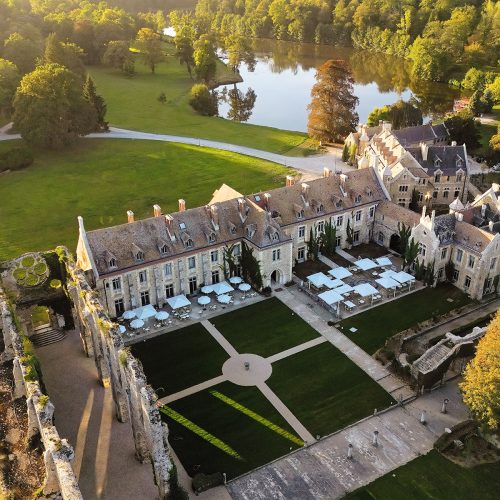
Hotel of the Week: Paris Society’s Newest Property Transforms a 12th-Century Abbey

Discover the New Ritz-Carlton Yacht Collection, a Hotel at Sea

The Colony Hotel Dazzles with a Fresh Design in Celebration of Its 75th Anniversary
Live artfully with curated stories straight to your inbox.
Sign up for the Galerie newsletter
Sign up to receive the best in art, design, and culture from Galerie


Accueil 2023
Experience french châteaux like never before, from december 1, 2023.
Exclusive tours of French Chateaux with English-dubbed , ad-free videos.
NO SPAM – 1-click Unsubscribe
A New Chapter Begins on December 1
- English-Dubbed Videos
- Weekly Newsletter
- Exclusive Store
As the leaves turn and autumn graces us, So Châteaux is thrilled to unveil a fresh chapter in our journey.
Starting December 1, immerse yourself in the world of French Chateaux like never before.
Every week for 15 weeks , anticipate a newly dubbed castle tour guided by the owner + an exclusive weekly newsletter , delivering the latest updates and insights straight to your inbox.
Coming Soon (Q1 2024): Community Platform where like-minded enthusiasts gather to share, discuss, and revel in the magic of history. From meticulously curated articles, enlightening books , to engaging quizzes that challenge your knowledge, there’s a treasure trove of content awaiting.
Join us, as we embark on this exciting new era, offering more depth, more stories, and more ways to connect with the world of French Châteaux .
Upcoming French Chateau Tours...
These episodes were recorded in French, but you’ll have access to exclusive English-dubbed versions.

There was a problem reporting this post.
Block Member?
Please confirm you want to block this member.
You will no longer be able to:
- See blocked member's posts
- Mention this member in posts
- Message this member
Please allow a few minutes for this process to complete.
- Day trips from Paris Day trips from Paris
- Fooding Fooding
- Cruises Cruises
- Find your order
- Our Sanitary Program
- +33 (0)1 44 55 60 00
Choose a place
- DESCRIPTION
- MEETING POINT
All day trip guided tour of the Loire Valley Castles with transportation from Paris
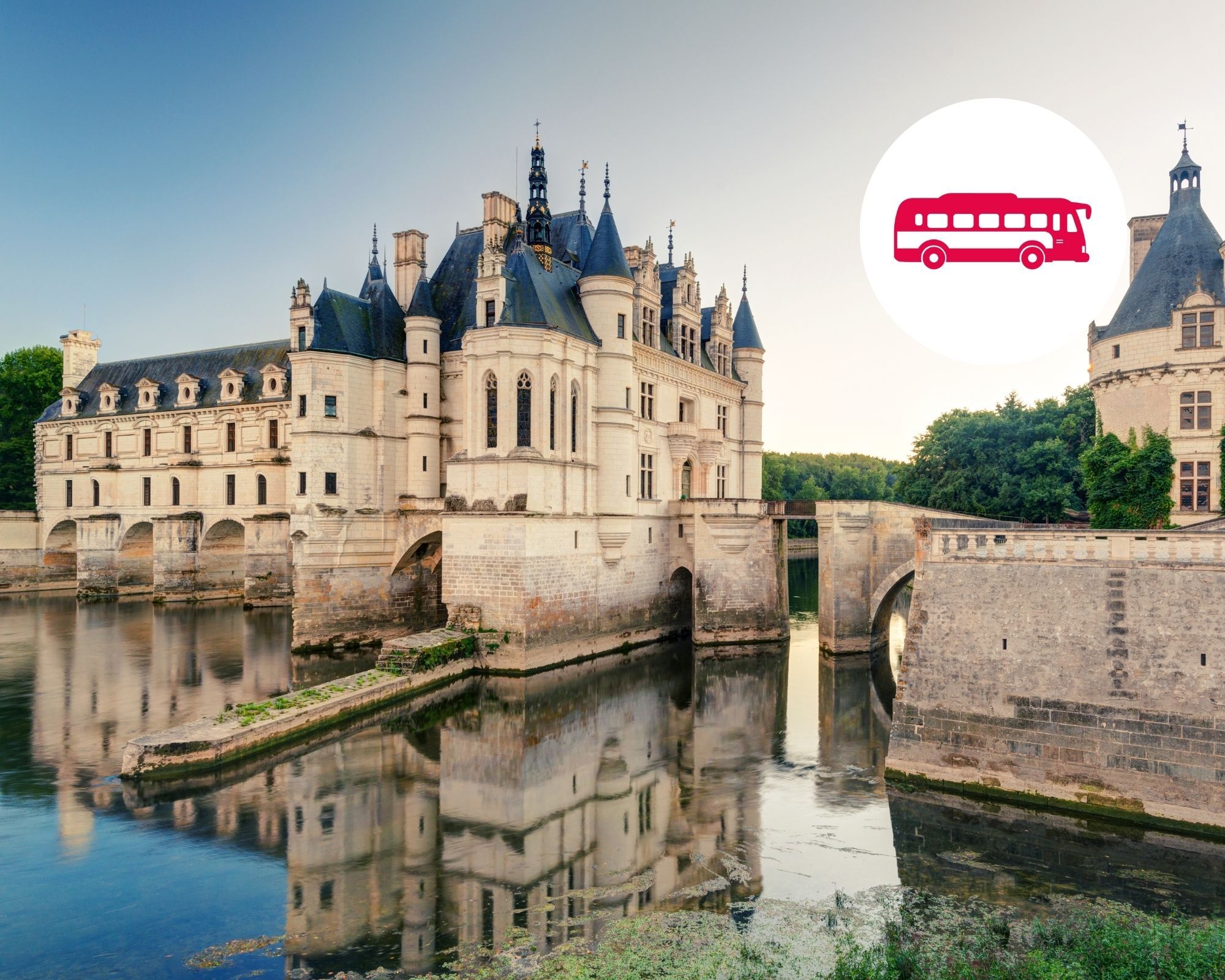
Guided tour

185,00 € / pers.
- Transportation from Paris by air-conditioned vehicle
- Experience an exceptional guided tour in the heart of France’s Loire Valley
- Discover the French châteaux that have inspired so many cinematic and literary works
- Hear stories and anecdotes about majestic places that made history
- Pick up from your place of residence (depending on option chosen)
- Guided visit of Chenonceau Castle, Cheverny Castle and Chambord Castle
- Service of a licensed guide.
Come and experience an exceptional day in the heart of the Loire Valley in France by discovering three of the greatest castles of the Loire: Chenonceau, Chambord and Cheverny with our guide. Board a comfortable air-conditioned coach to Chambord. As soon as you approach the castle, you will be amazed by the majesty of the building that rises before you. Its impressive architecture makes it the largest of the Loire castles. You will then quickly enter the interior thanks to a priority access. Our guide will lead you through some of the castle's rooms and you will take the famous "double revolution staircase" to reach the large panoramic terrace. You will enjoy a superb view of the park while listening to the comments given by our guide on the history of the castle, built during the reign of François I with the participation of Leonardo da Vinci during the 16th century. Then discover Chenonceau. You will drive through the magnificent landscapes of the Loire Valley. You will contemplate the fields as far as the eye can see and will go along the Loire River at times offering a serenity to the trip. During the journey, our guide will give you some information about the sites you will see. You will then drive along a beautiful tree-lined driveway that offers an incredible view of the castle. Our guide will give you a presentation of this sumptuous royal residence nicknamed "The Ladies' Castle" because it was maintained and enriched by several female characters over the years. The exterior setting with the building seeming to emerge from the water gives a fairy tale dimension to the castle. You will enjoy a one-hour guided tour of the castle of Chenonceau during which you will contemplate the furnished and flowered rooms, the tapestries and the period paintings. Our guide will tell you many stories and anecdotes about this castle and the importance of the female presence which testifies to the French art of living.
After this visit of Chenonceau, you will have free time to stroll in the remarkable gardens along the Cher River and have lunch around the castle. Our guide will tell you where you can have lunch. You will be invited to meet the guide directly at the bus parking lot to leave for Cheverny. In this seigniorial residence occupied by the same family for more than 600 years, you will discover the castle and its remarkable interior fittings. Outside, complete your visit with the park and its 6 thematic gardens including an orchard "le Jardin Sucré". Also known for hunting with hounds, you will be able to see its rich kennel which shelters a hundred dogs. The bus will leave around 5:00 pm for an expected arrival in Paris around 8:00 pm.
Please note :
- Please note that if you choose to be picked up at your place of residence, this will be in central Paris (zip code 75).
- The meeting with our PARIScityVISION representative takes place outside the hotel
- Lunch is not included, you will have the possibility to take it in the park of the castle of Chenonceau
- The order of visit of the castles can change (Chambord in the morning in summer)
- Pick up from your place of residence (according to the option chosen)
- Services of a licensed guide
- Guided tours of the castles of Chambord, Chenonceau and Cheverny
- Transport to and from Paris
Let's go
Book your tour
1. Define your needs
Special offer
2. Select your tour
1 adult x 185,00 €
All day guided tour of the Loire Valley Castles with transportation from Paris (Pick up off hotel)
1 adult x 225,00 €
Cancellation fees : Go to general terms and conditions of sale
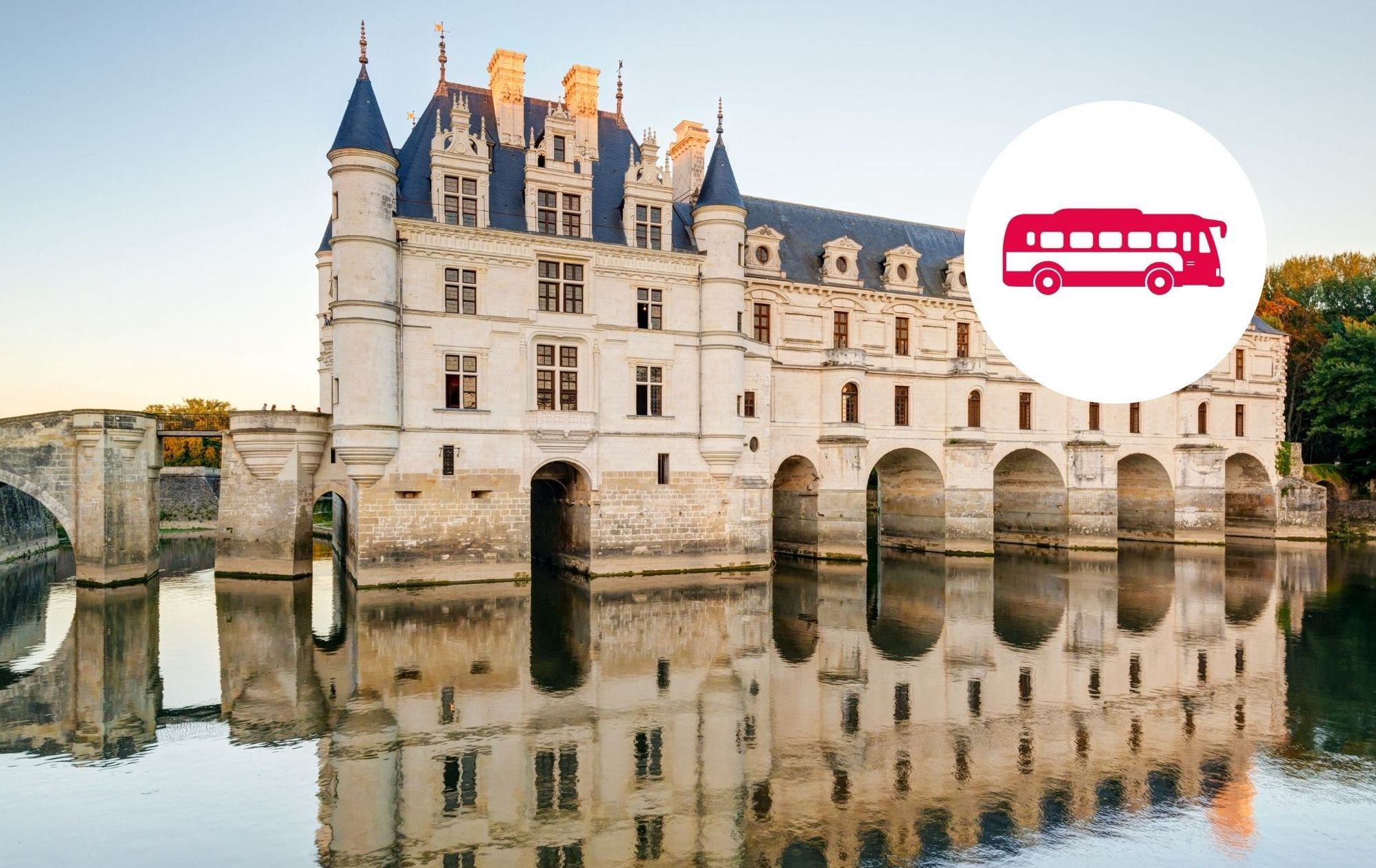
Preparation of the tour
Address : Hotel Pullman Bercy (meeting with our PARISCITYVISION representative outside the hotel, in front of the main entrance)
1 rue de Libourne, 75012 Paris
Cour Saint Emilion
Address : Hotel Pullman Bercy
Organized by PARISCityVISION
Tour Code: CL1

Get FREE email communications from Fodor's Travel, covering must-see travel destinations, expert trip planning advice, and travel inspiration to fuel your passion.
- Things To Do
- Restaurants
- Neighborhoods
11 Must-See Châteaux Outside Paris
No need to head to the Loire Valley to see magnificent homes: There are plenty of historic châteaux within an hour of Paris, by car, train, or metro that can be easily explored in a single, history-filled day. Many of these properties are little-known gems, while others contain world-class museums or are located in the midst of gorgeous gardens and untamed forests. Whatever your interests, you'll find a world of majesty, history, and serenity just a short day trip away from Paris.
by Jennifer Ladonne
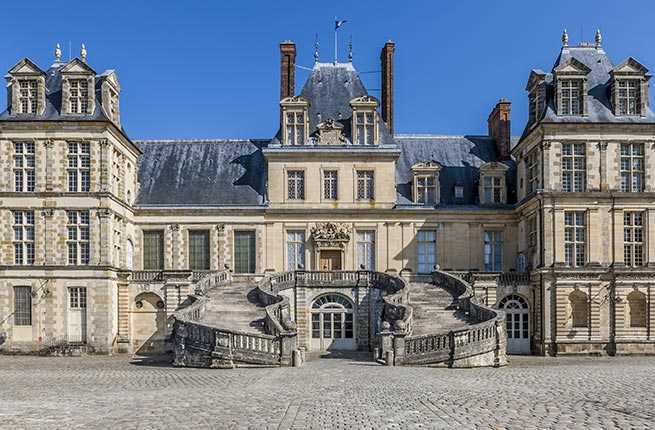
Château de Fontainebleau
King Francois I hired the best French and Italian artists to embellish every inch of these sumptuous interiors with gilded woodwork, virtuosic frescoes, and paintings (the royal collection once included the Mona Lisa ). Catherine de Medici, Louis XIV, and Napoleon Bonaparte all left their mark on the château , and you'll notice different styles reflecting the many royals who lived here over a period of 300 years. The château itself is easily seen in a day, but the gardens—by royal landscape designer André Le Nôtre—and surrounding forest, as well as the charming town of Fontainebleau, make for an excellent weekend trip.
If You Go: A short walk from the château, Michelin-starred L'Axel Restaurant draws foodies from near and far for its excellent and reasonably-priced gastronomic cuisine. (reservations necessary, €33 prix-fixe menu).
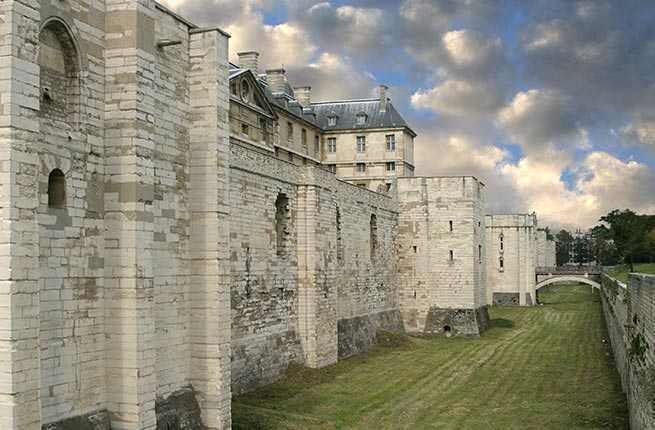
Château de Vincennes
France's largest and best-preserved medieval château, the recently restored Château de Vincennes also has the distinction of being a 10-minute metro ride from central Paris. The fortified castle, large enough to protect a 14th-century city within its walls, houses France's tallest medieval donjon, which is as famous for the royals who lived there as for its prisoners, which included the Marquis de Sade and philosopher Denis Diderot. The exquisite Sainte-Chapelle de Vincennes, sister to Sainte-Chapelle in Paris, was built to house a true relic of the crown of thorns.
If You Go: Just behind the castle is the Parc Floral, Paris's most beautiful public garden. Take in an outdoor concert, grab a bite at one of the park's two cafés, let the kids run around in the huge play area, or just stroll the acres of lush gardens and greenhouses.

Château de Chantilly (Musée Condé)
Dramatically set between water and elegant André le Nôtre–designed gardens, the Château de Chantilly houses France's finest collection of paintings outside the Louvre in the attached Musée Condé. Built around 1560 by Anne de Montmorency, the Petit Château was the ancient home of the Connétables de France (constables), a high position close to the king, and contains the beautiful Apartements des Princes and a superb library with hundreds of priceless volumes, including a Gutenberg bible. Housed in the 19th-century wing, the superb Musée Condé is not to be missed. The château's extensive grounds contain the charming Hameau, a “village” built in 1774 that was the inspiration for Marie Antoinette's village at Versailles.
If You Go: Horse-centric Chantilly also boasts the newly restored Grandes Écuries (stables), built between 1719–1740 featuring a schedule of equestrian shows that delight young and old alike, and the wonderful Musée Vivant Cheval (Museum of the Living Horse). Just down the road, the hippodrome is one of France's most famous racecourses.
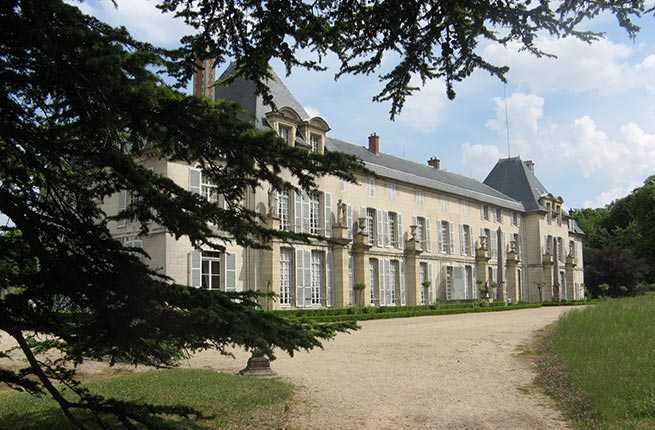
Château de Malmaison
Napoleon I's wife, Joséphine, saw the potential in this charming spot located seven miles from Paris; she took advantage of her husband's Egyptian campaign to buy the ramshackle house in his absence. He was furious at her extravagance, but slowly came around and eventually threw himself into creating a dwelling of unusual refinement, where the couple spent the happiest of their 13 years together. After the divorce, Joséphine lived here until her death in 1814, tending her famous rose garden and expanding her collection of exotic plants and animals. Restored during the reign of Napoleon III, the house features a rich collection of artwork and furniture, and the beautiful gardens remain a testament to a woman of taste and the Empire style.
If You Go: This peaceful little château is reached by car or by a quick RER train ride to La Défense (just outside Paris), then via bus 258, which drops you off at the property. There is no café on the premises, but you'll find restaurants within easy walking distance.
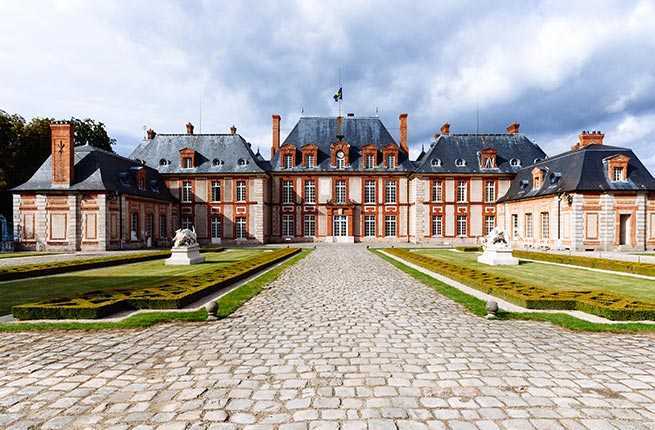
Château de Breteuil
The magnificent, privately owned Château de Breteuil has been home to the Marquises of Breteuil since the early 17th century, all of whom played an important role in the French history. Some of this stories, along with seven fairy tales by the famous French author Charles Perrault—including Puss n' Boots , Little Red Riding Hood , and Bluebeard —are charmingly recreated in the house and around the grounds via 50 lifelike wax figures from Paris's Musée Grevin. Extensive gardens, a kids' park, and a topiary maze also add to the family fun, and a café on the grounds makes it an easy place to spend the day (picnics are also permitted). And that elegant gentleman showing you around just may be the 12th Marquis of Breteuil, who lives here and conducts tours. The château is about an hour from Paris via the RER.
If You Go: Here, kids are royalty. To get as much as possible out of your trip, check online before you go; the schedule of events often includes special concerts and events for children.

Château de Maintenon
Madame Maintenon, the second wife of Louis XIV, bought this already ancient château in 1675 with money given to her by the king. Louis oversaw its improvements, employing his staff from Versailles, including landscape architect André le Nôtre. Although Madame Maintenon loved the castle's singular beauty and solitude, she was rarely able to visit her property, since Louis, whom she'd married in a secret ceremony sometime around 1686, was ever more reliant on her company at Versailles. The property's picturesque aqueduct was built in 1685 to divert water from the Eure River to feed the fountains at Versailles.
If You Go: This lovely, little-known château is a 50-minute trip from Gare Montparnasse, and a pleasant 15-minute walk from the station. Maintenon is on the same route as Chartres Cathedral and both can easily be seen in a day.
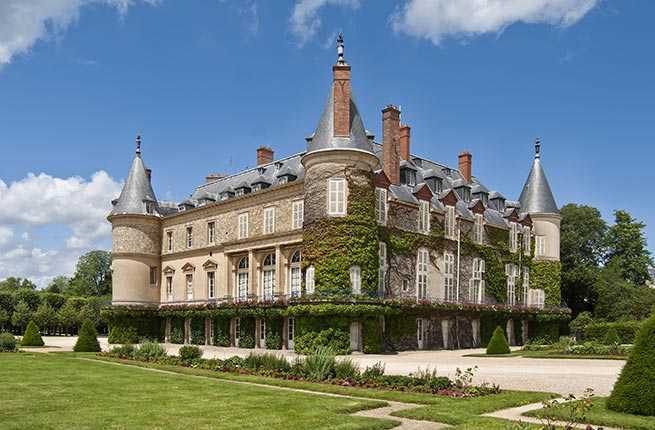
Château de Rambouillet
This handsome 18th-century château was built around a 14th-century fortified castle whose remaining central tower was named for François I, who died there in 1547. The castle's elegant interiors date to the Renaissance, although Napoleon carried out important updates (he stayed here on his way to exile) for his second wife, Marie-Louise. On the château grounds, you'll find the charming Laiterie de la Reine (Queen's Dairy), Louis XVI's surprise gift to Marie Antoinette, who hated the château, and the Chaumière des Coquillages, a classic folie whose interior was fashioned entirely of seashells. The château functioned as the summer home for the presidents of France, and the 36,000-acre forest, flower-bedecked façade, and lakeside setting all contribute to its unusual serenity.
If You Go: The château is located about an hour from the center of Paris—easily reached by train from Gare Montparnasse—where there are plenty of shops and cafés for a convenient lunch or snack. Or, grab a baguette and some cheese for a picnic on the grounds.
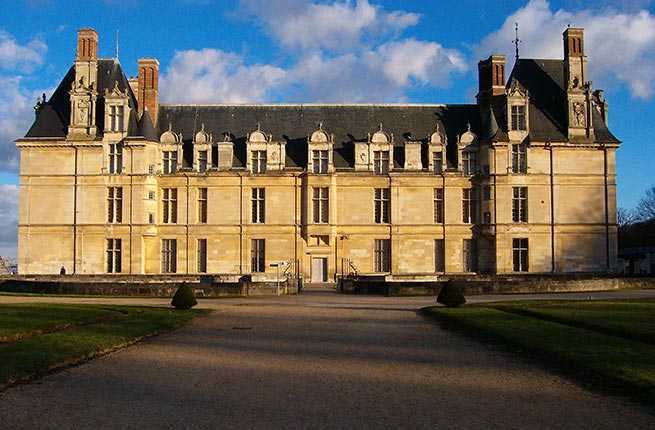
Château d’Ecouen (Musée National de la Renaissance)
This little-known gem was built in 1538–1551 by the powerful Anne de Montmorency, Constable of France and a famous aesthete who used his vast wealth to build this masterpiece of Renaissance architecture. Since 1977, the château has been home to the Musée National de la Renaissance , the only museum in France dedicated to this period, with an outstanding collection of Renaissance paintings, furniture, glassware, enamels, silverware, weaponry, and stained glass, as well as its famous ten-panel tapestry, “The Story of David and Bathsheba.” The château also houses one of the most comprehensive collections of lace in the country. Close to the quiet town of Écouen, about 19 miles from Paris, the château is surrounded by the lush Écouen forest, perfect for a stroll or hike.
If You Go: The train to Écouen-Ezanville from Paris Gare du Nord takes about 20 minutes. You can hop on a bus directly to the château, but the lovely 15-minute walk on forest paths is worth the slight detour. The château's charming Deylan restaurant and tea salon is a good place for lunch or a snack throughout the day on its outdoor terrace.
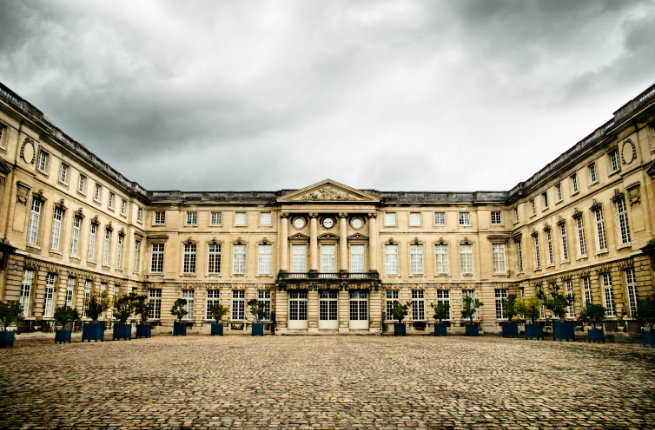
Château de Compiègne
An island of calm, this stately Neoclassical château sits at the edge of the enormous Compiègne forest, a favorite royal hunting ground since the Middle Ages. Built for Louis XV, the château was extensively redesigned in the early 1800s by Napoleon Bonaparte, and again by Napoleon III and the Empress Eugénie, who made it their autumn residence. A spectacular example of Second Empire style, the gorgeous apartments are a delight to behold, as are the exhibits of costumes and portraiture of the day, part of the Musées de Second Empire. The château also houses the wonderful transport museum, with examples of horse-drawn vehicles and hippomobiles (the first motored vehicles) from the 17th to the early 20th centuries.
If You Go: Between the forest, gardens, château, and three museums housed inside, there's plenty to keep you busy for a day, but the château's excellent special exhibitions are also worth a look. Additionally, there's a lovely café-restaurant on the premises.

Vaux-le-Vicomte
From the château gates to the imposing statue of Hercules at the edge of Vaux-le-Vicomte's classic French gardens, the impression is one of pure harmony and elegance. Louix XIV thought so, too, since he arrested the owner, Nicholas Fouquet, on trumped-up charges and hauled him off to prison before taking everything in the palace for himself and appropriating Fouquet's architect, interior designer, and landscape gardener to build Versailles. The privately owned, beautifully restored château and gardens still stand as a testament to the unfortunate Fouquet's exquisite taste and refinement. On candlelit evenings (Saturdays from May–October), the château glitters inside and out with 2,000 candles and a special dinner is served on the terrace followed by a spectacular fireworks display.
If You Go: The château can be reached from Paris's Gare de Lyon via train (30 minutes), where a taxi or the Châteaubus shuttle (weekends only) can take you directly there from the Melun station. ParisCityVision also offers a package ticket with a direct shuttle from Paris to the château.

Château de Saint-Germain-en-Laye (Musée d’Archéologie National)
Like Fontainebleau, this château also dates back to the reign of François I, but the similarities end there. As austere as the other is flamboyant, Saint-Germain-en-Laye was in a state of disrepair when Louis XIV (who was born there) gave it a facelift using his star team taken from Vaux-le-Vicomte. Louis continued to shuttle between here and the Louvre while Versailles was under construction. The stunning 12th-cenutry Sainte-Chapelle, precursor to its famous Parisian counterpart, is worth the trip alone. But the château also houses the wonderful National Museum of Archeology, chronicling the history of France from prehistory to the Middle Ages. This elegant château's museum and gardens, plus its views of Paris, make for a wonderful day trip, just 20 minutes from the city via the RER (the station is just across the street from the château).
If You Go: The affluent town of Saint-Germain-en-Laye is chock full of history, and its wide, tree-lined streets are a great place to stroll, window shop, or relax at an old-style café. Chez Alice is the perfect place for a gourmet lunch or a nice cup of afternoon tea and dessert.

A tour of France's must-see sites during and after the Paris Games
Inspiration

Reading time: 0 min Published on 13 August 2024
From natural sites to exceptional heritage and must-see sights, it's time to set off on a trip around France to discover the wonders of the French regions, accessible from Paris and the host cities of the Olympic and Paralympic Games.
Around Paris
Make the most of your stay in Paris during the 2024 Olympic and Paralympic Games to visit the region's iconic châteaux such as Versailles and Fontainebleau. If you're a gourmet, why not take a stroll along the quays and savour some delicious pastries!
Visiting Paris and the surrounding region
Take a breath of fresh air in the city's parks and gardens, savour local produce at the tables of chefs' restaurants, discover the skills of passionate craftsmen... There are a thousand and one ways to discover Paris in a different way. The City of Light can also be visited by bike, thanks to the many cycle paths that have been laid out...
Visit Paris
Hauts-de-France
In Hauts-de-France, a welcoming and authentic region, let yourself be tempted by a variety of activities such as a visit to the Louvre-Lens Museum or discovering the Baie de Somme by bike on the Vélomaritime!
Visit Hauts-de-France
In Lille, beer is king! Enjoy it (in moderation) in the historic city centre near the Grand Place or in the guinguettes. After a stroll through Old Lille, relax in the Parc de la Citadelle, then indulge in some culture at the Musée de la Piscine in Roubaix.
Visiting Lille
Pays de La Loire
The Pays de la Loire region is famous for its sumptuous châteaux, but that's not all! Come and taste some famous Loire wines and discover some remarkable landscapes, such as the salt marshes of Guérande.
Visit the Pays de La Loire
Auvergne-Rhône-Alpes
In Auvergne-Rhône-Alpes, you'll be amazed by a wide range of destinations: lavender fields, the Aiguille du Midi, the Facteur Cheval's Ideal Palace, not to mention the many culinary specialities!
Visit the Auvergne-Rhône-Alpes region
As the capital of gastronomy, Lyon has plenty of gourmet addresses, including the authentic bouchons lyonnais, where you can grab a bite to eat between two visits. From the Fourvière Basilica, accessible on foot or by funicular from Vieux-Lyon, to the Musée des Confluences, which can be reached by river shuttle, Lyon's former "sleeping beauty" is ready to surprise you.
Visiting Lyon
Saint-Etienne
The Cité du Design, the Musée d'Art et d'Industrie, the Museum of Modern and Contemporary Art, the Corbusier site... Saint-Etienne is resolutely focused on modern art and architecture. It's no coincidence that the former industrial capital has been designated a Creative City for Design by UNESCO. Just a few kilometres from the city centre, the Loire Gorges and the Pilat Regional Nature Park will appeal to nature lovers and hikers alike.
Visiting Saint-Etienne
Nouvelle Aquitaine
From the Atlantic coast to the Pyrenees and the vineyards of Bordeaux, there's something for everyone in New Aquitaine.
Visit Nouvelle Aquitaine
Bordeaux is world-famous for its vineyards, which you can discover by bike or on a visit to the Cité du Vin. Alongside the city centre, which has been classified as a UNESCO World Heritage Site, are the terraces on the banks of the Garonne where you can laze around, not forgetting the Arcachon Basin and its oyster-farming villages, less than an hour away by train.
Visiting Bordeaux
Provence-Alpes-Côte d'Azur
The Provence-Alpes-Côte d'Azur region has a lot to offer, from its magnificent Unesco World Heritage monuments to its flavoursome cuisine and Mediterranean landscapes. You'll be amazed by its charm and art of living!
Visit the Provence-Alpes-Côte d'Azur region
With 300 days of sunshine a year, Marseille cultivates the French art of living. Aperitifs on the terrace, traditional bouillabaisse or dishes reinvented by local chefs, a stroll along the seafront or a trip to the Frioul islands to discover the mysterious Château d'If and gaze out over the city of Marseille... It's a popular place to visit in all seasons!
Visiting Marseille, in Provence
Between mountains and sea, Nice la belle, as it is known, benefits from an exceptional location (and climate) for a wide range of activities. You can learn something new in the many museums that bear witness to the attachment of artists such as Matisse and Chagall to the Côte d'Azur, escape into the hinterland to discover unspoilt nature and medieval hilltop villages, admire a bird's-eye view of the Promenade des Anglais from the hill of the castle before savouring local specialities such as socca in the narrow streets of Vieux Nice.
Visiting Nice on the Côte d'Azur
The Grand Est region has something for everyone! Stroll through the lakes of the Forêt d'Orient nature park, discover the expertise of the Champagne Houses and stroll through the Petite France district in Strasbourg, Alsace.
Visit the Grand Est region
Occitanie has a surprisingly varied landscape. From the Millau Viaduct to the medieval city of Carcassonne, via the beaches of the Mediterranean and Montpellier, this endearing region is sure to give you a warm welcome!
Visiting Occitanie
Loire Valley
The Loire Valley region has a wealth of châteaux to discover on the La Loire à Vélo cycle route! It's also a land of history, where you can follow in the footsteps of Joan of Arc in Orléans.
Visiting the Loire Valley
Brittany is the ideal destination for savouring the sea air and discovering a unique heritage between land and sea: Rennes gastronomy, Cité de la Voile, the customs path, menhirs, lighthouses...
Visit Brittany
In Normandy, come and (re)discover the impressive Mont-Saint-Michel and enjoy long bike rides along the Normandy coastline. For art lovers, don't forget to visit Giverny for a better understanding of Impressionism.
Visiting Normandy
Burgundy and the Jura Mountains
The Burgundy wine route, the Basilica of Vézelay, the Cité des Climats and Burgundy wines, cycling in the Jura Mountains: discover the treasures and must-see sites of the Burgundy-Franche-Comté region.
Visit Burgundy and the Jura Mountains
Discover Tahiti and French Polynesia, the pearl of the Pacific, with a lush natural environment, delicious island cuisine and exceptional seabed to explore.
Visit Tahiti, in French Polynesia
Holidays at Galeries Lafayette

Air France, the best and most comfortable way to get to France

French Wine Tasting with Duclot La Cave

Gift vouchers for your shopping at Galeries Lafayette

The Christmas Windows Display and Characters

A Fairy Tale 1, 2, 3 Christmas!

8 Luxurious Boutiques in Paris

A historical and cultural melting pot in French Polynesia
Tahiti-French Polynesia

LOBBY Moscow

6 places in Russia where you will feel like you’re in another country (PHOTOS)
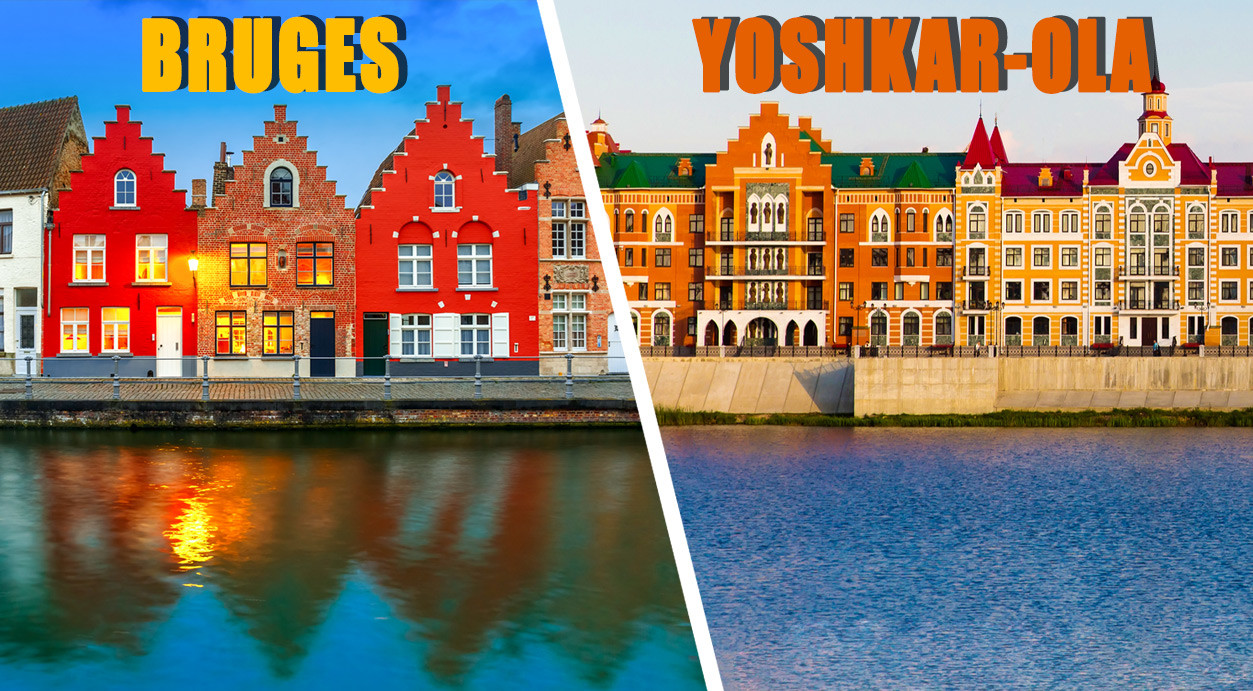
From a distance, these places could easily be mistaken for some European or Asian city, but once you get closer it becomes clear that the buildings and streets are actually just homages to world architecture.
1. A Norwegian fishing village in the Ryazan Region
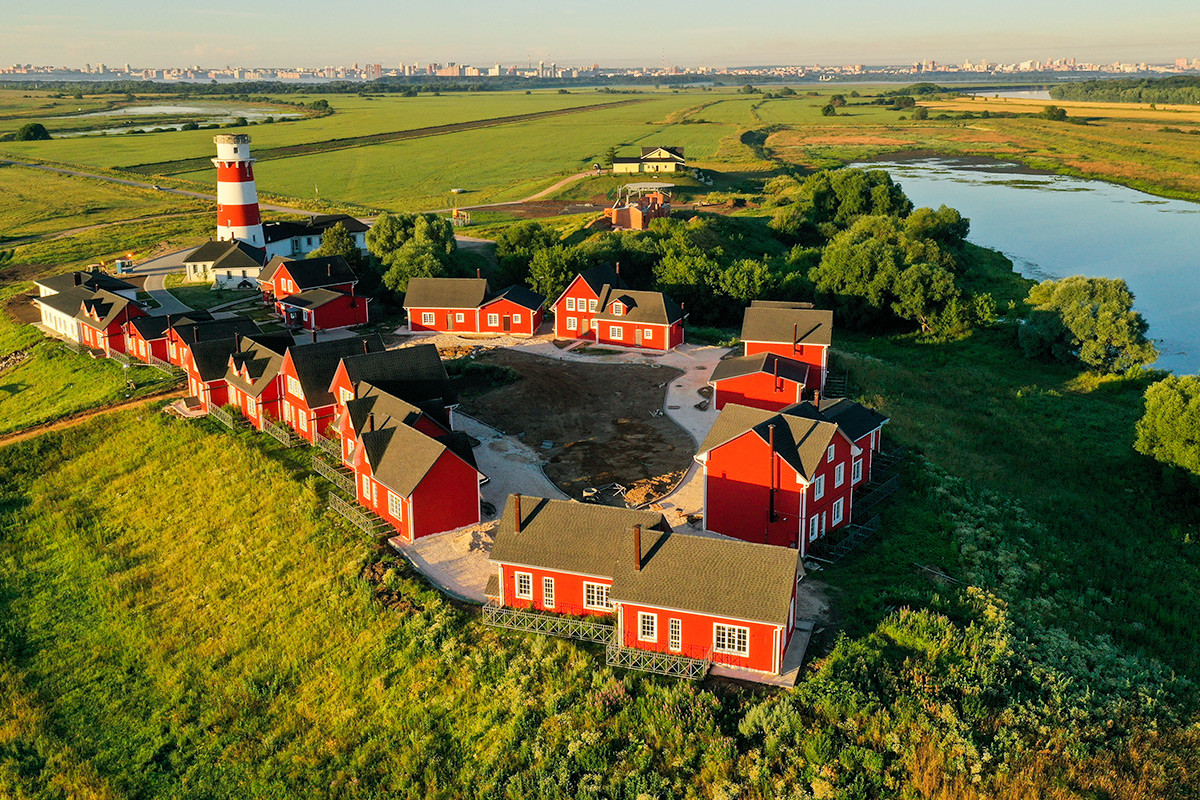
This hotel in the village of Shumash, 200 km from Moscow, is built in the style of a Norwegian fishing village, replete with a lighthouse. It was initially conceived as a holiday resort for nature and fishing enthusiasts, but construction still has not been completed. The Fishing Village is located on a picturesque site with meadows on the shores of a lake, so it may well be the most beautiful unfinished construction project in Russia. Did you notice that there aren't even fences here ?
2. A Loire Valley chateau in Moscow
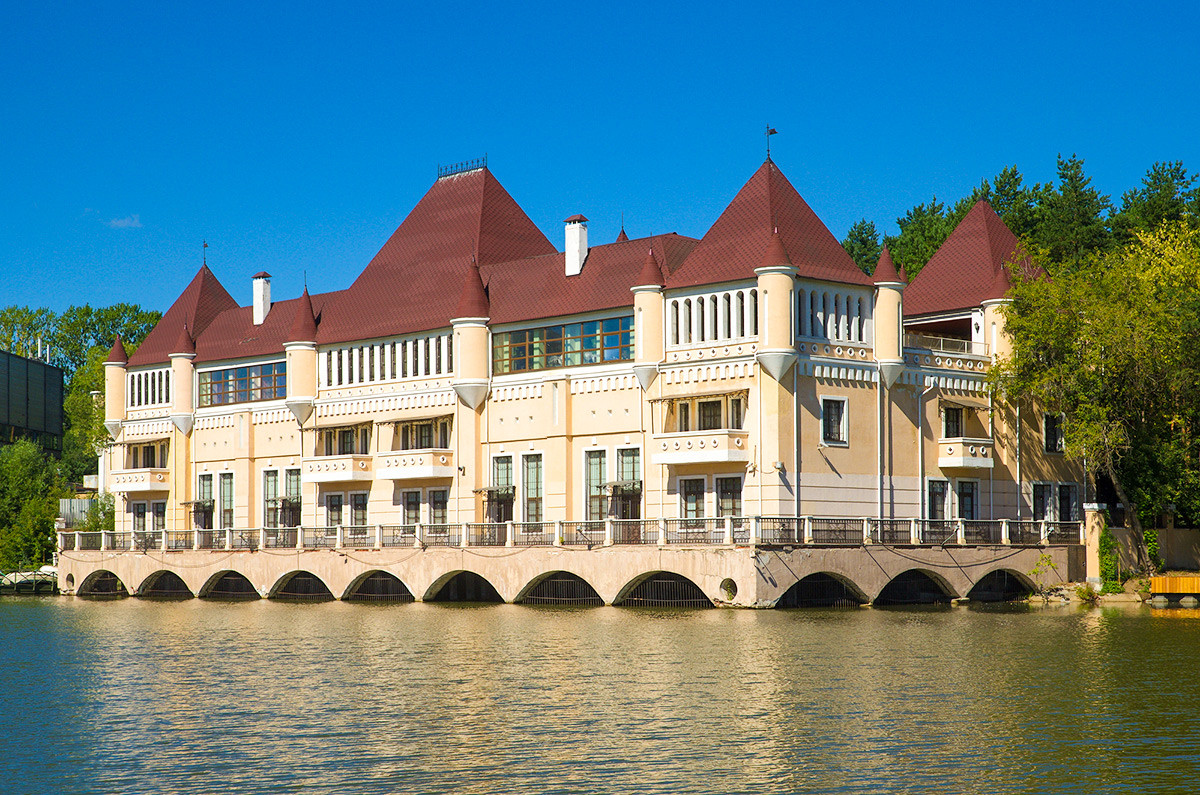
On the territory of the VDNKh park, tucked between the pavilions dedicated to fishing and rabbit breeding, stands a private mansion. It is a quiet spot, seldom reached by tourists. Nevertheless, the mansion is quite an interesting building: a copy of one of the châteaux of the Loire Valley that was built here in Moscow in the early 2000s. It has been empty for many years, so Muscovites have dubbed it a “ghost palace.” According to the administration of the VDNKh park, the palace was built without the necessary permissions and will need to be demolished.
3. Medieval Europe in Moscow Region
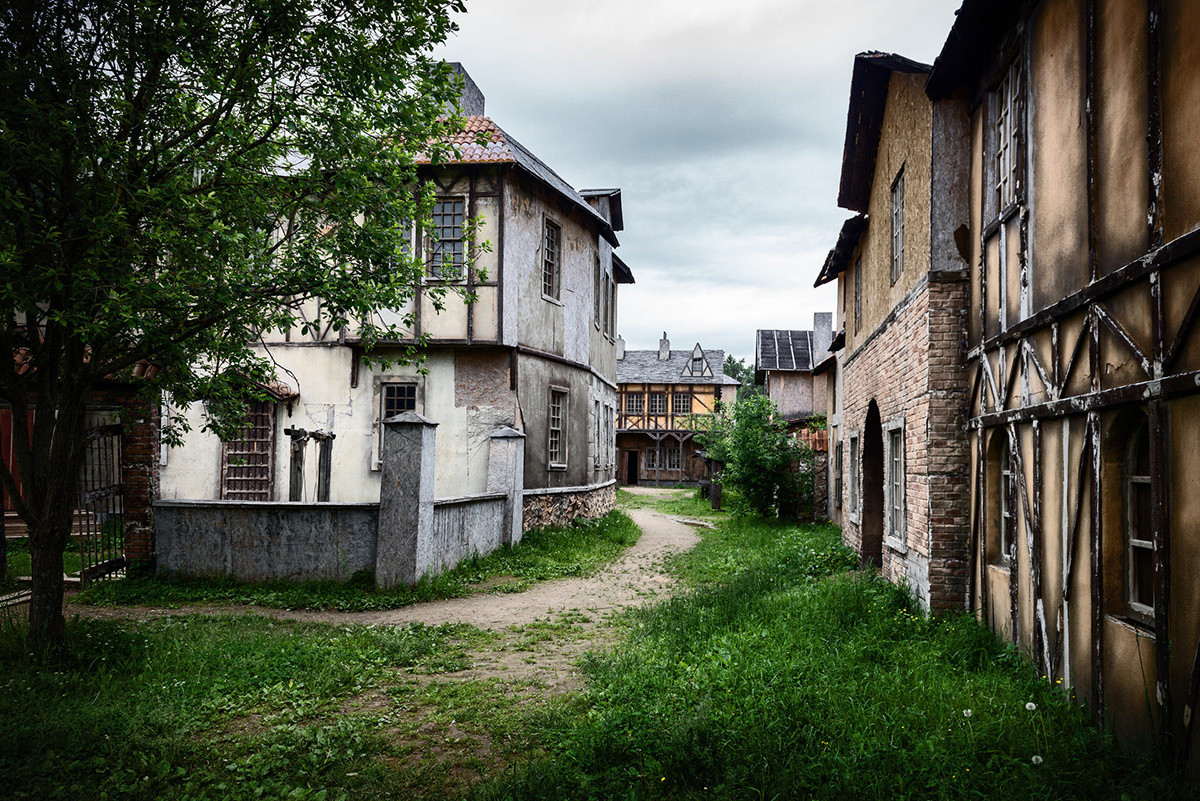
Just north of Moscow, there is a place where you can literally find yourself in the middle of an old European town. Narrow streets, pretty two-story houses, a town hall in the central square and even a cathedral. In reality, these are all old film sets that were brought here to the Kinogorodok (“Film City”) theme park. They definitely make a great background for pictures!
4. A French chateau in Kabarda-Balkaria
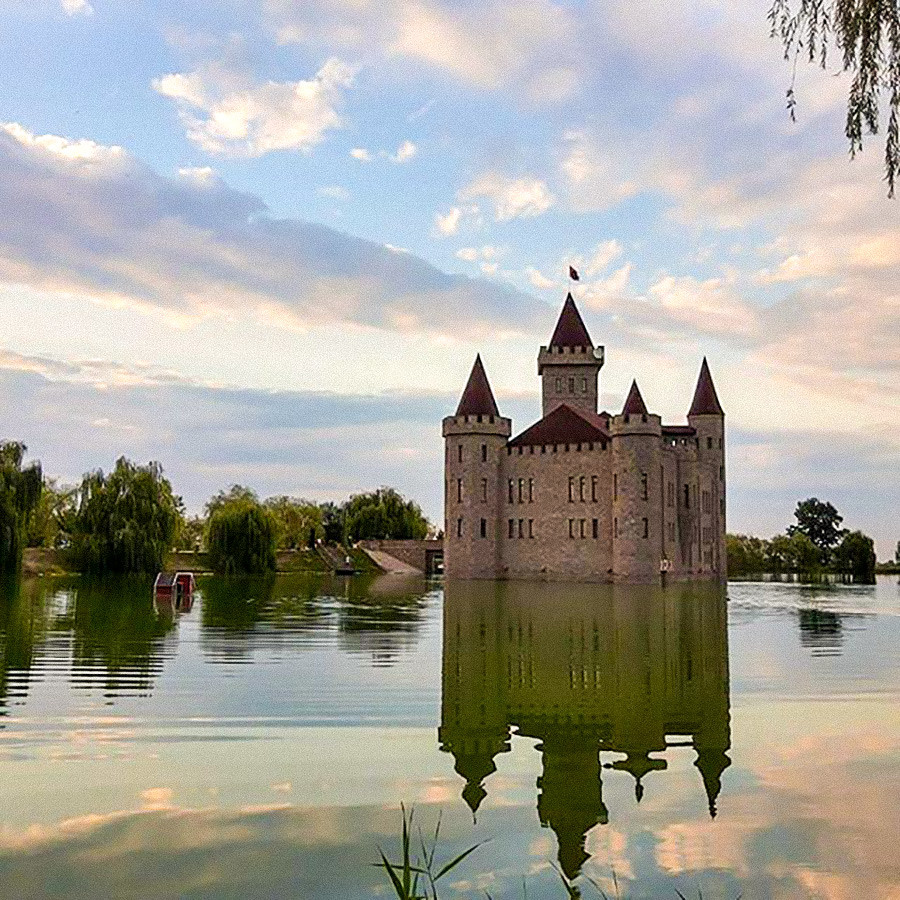
This Gothic castle with high towers, massive iron gates and a lake with swans is located in the Kabarda-Balkar Republic in the North Caucasus. Chateau Erken is a modern winery and popular venue for special occasions. The idea for building it came to a local agronomist in the 1990s who hoped Russia would develop a wine industry on a par with European countries. Most of the land around the chateau is occupied by vineyards that grow classic varieties of grapes: Merlot, Chardonnay and Cabernet Sauvignon. Visitors can test the quality of local wines in the castle's splendid tasting room.
5. Japanese pagodas in Moscow
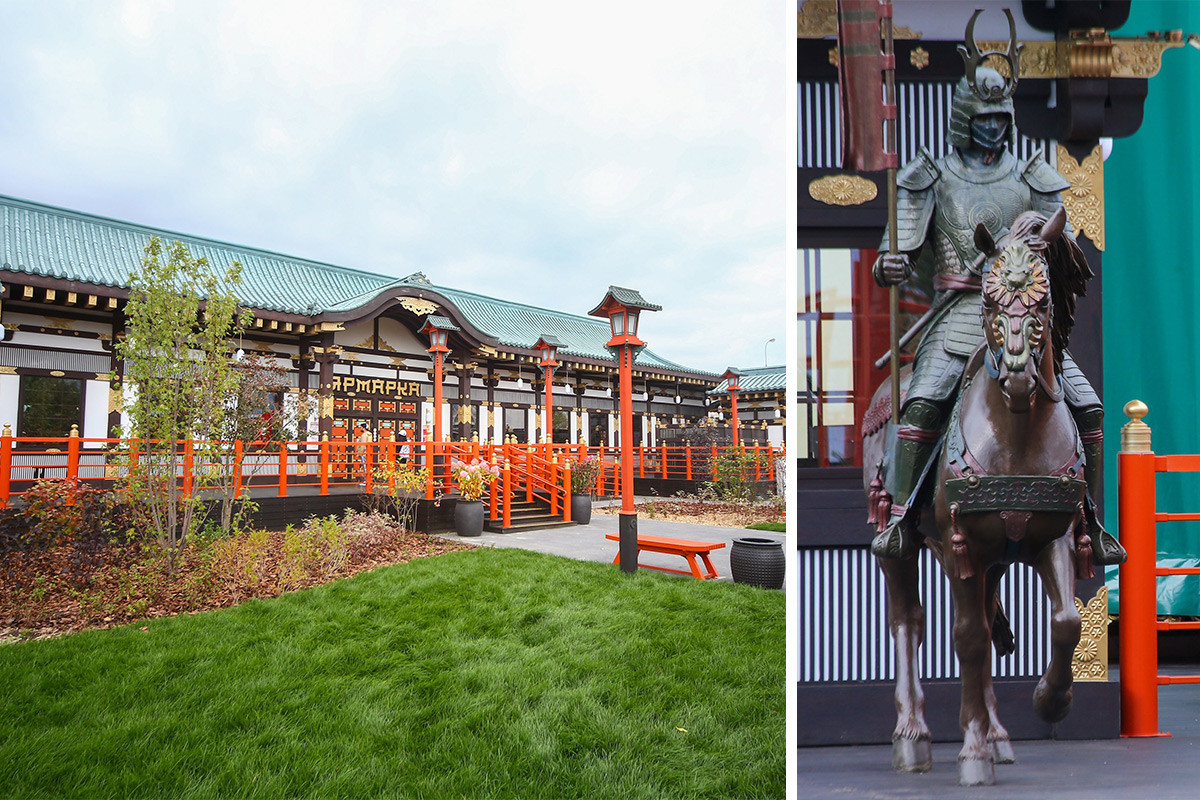
This used to be just an empty space until early September 2020, when a small park that locals call "Little Japan" opened here. Guests are greeted at the entrance by a samurai on horseback and dragon figures. In "Japanese houses" inside the park, you can buy various snacks and souvenirs.
6. Belgium and Holland in Yoshkar-Ola
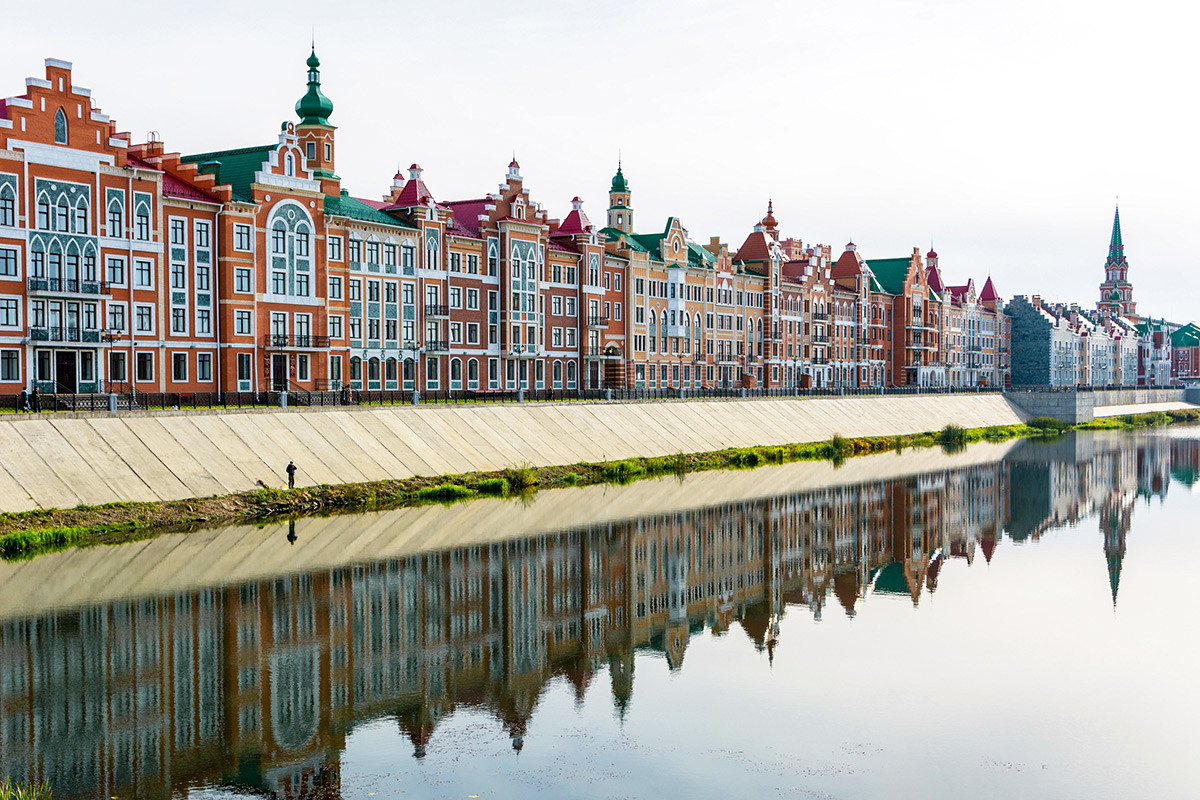
The capital of the Republic of Mari El is famous throughout Russia for its copies of famous world sights. One waterfront is a copy of Bruges, another of Amsterdam, and they are connected by a bridge stretching from the Moscow Kremlin. Here you will find the Spasskaya Tower and Piazza San Marco, and even—because why not?—a monument to Grace Kelly. All these attractions were built at the initiative of the city's mayor in the early 2000s, and local residents liked their "European" quarter so much that new buildings are still being added to this neighborhood.
If using any of Russia Beyond's content, partly or in full, always provide an active hyperlink to the original material.
to our newsletter!
Get the week's best stories straight to your inbox
- 10 places in Russia that barely look Russian at all (PHOTOS)
- The 7 most beautiful villages in Russia (PHOTOS)
- Russia's most beautiful waterfronts (PHOTOS)
This website uses cookies. Click here to find out more.
- Israel-Gaza War
- War in Ukraine
- US Election
- US & Canada
- UK Politics
- N. Ireland Politics
- Scotland Politics
- Wales Politics
- Latin America
- Middle East
- In Pictures
- Executive Lounge
- Technology of Business
- Women at the Helm
- Future of Business
- Science & Health
- Artificial Intelligence
- AI v the Mind
- Film & TV
- Art & Design
- Entertainment News
- Destinations
- Australia and Pacific
- Caribbean & Bermuda
- Central America
- North America
- South America
- World’s Table
- Culture & Experiences
- The SpeciaList
- Natural Wonders
- Weather & Science
- Climate Solutions
- Sustainable Business
- Green Living
Was Ukraine’s role in big Wagner defeat an own goal in Africa?

As Ukraine’s foreign minister completes his latest tour of Africa, his country risks paying a serious diplomatic price for helping separatist rebels in northern Mali inflict a severe defeat on the Russian military operator Wagner at the end of last month.
The ambush at Tinzaouten on 27 July reportedly killed 84 Wagner fighters and 47 Malian soldiers.
It was a painful military blow for the mercenary outfit once headed by the late Yevgeny Prigozhin, but now controlled by Russia’s official defence command structure.
Just two days later Andriy Yusov, spokesman for Kyiv’s military intelligence service (GUR), said that ethnic Tuareg rebels in Mali had “received necessary information, and not just information, which enabled a successful military operation against Russian war criminals”.
Subsequent reports suggested that Ukrainian special forces had trained the separatists in the use of attack drones.
Yet for many Africans, this was yet another case of outside powers exploiting the continent as a bloody playing field for their own rivalries.
Predictably, Mali’s ruling military junta, and the allied regime in neighbouring Niger, protested by breaking off diplomatic relations with Kyiv.
But much more significant was a statement from the regional bloc, the Economic Community of West African States (Ecowas). Despite its own diplomatic issues with the military regimes in Mali, Niger and Burkina Faso, it was clear in its rebuke.
It declared its “firm disapproval and firm condemnation of any outside interference in the region which could constitute a threat to peace and security in West Africa and any attempt aiming to draw the region into current geopolitical confrontations”.
The anger will have been strengthened by suggestions that some jihadist militants joined the Tuareg separatists in mounting the Tinzaouaten attack.
The Senegalese foreign ministry summoned the Ukrainian ambassador in Dakar to protest after he posted a Facebook video about Mr Yusov’s gloating comments.

Ukrainian Foreign Minister Dmytro Kuleba was touring Malawi, Zambia and Mauritius last week. But after the harsh words from Ecowas and Senegal he may now have to engage in some serious fence-mending in West Africa.
What many sub-Saharan African governments - even those that privately mistrust Moscow - will probably view as Kyiv’s unhelpful outside military adventurism could dispel the goodwill so painstakingly cultivated over the past two years through peaceful Ukrainian diplomacy.
Of course in narrow military terms, helping to inflict the heaviest-ever African defeat on Wagner was a success for the Ukrainians.
The mercenary contractor - now officially renamed Corps Africa after being brought under Russian state control - had doubled its manpower to an estimated 2,000 in Mali over the past two years.
So news of the heavy losses in Tinzaouaten came as a shock, particularly given that the Malian army and Wagner forces had seized Kidal, the Tuareg rebel “capital”, last November.
The Tinzaouaten incident has signalled the separatists’ return to the offensive –with, it soon became clear, the support of a new partner.
Kyiv’s hints of direct involvement confirm how far it is prepared to reach in taking its fightback against Russia’s President Vladimir Putin well beyond the home battlefield.
In fact this is not the first such direct intervention against Wagner military operations in Africa.
There were strong indications that last August and September Ukrainian special forces carried out drone raids in Sudan in support of the military regime led by General Abdel Fattah al-Burhan.
For more than a year, it has been engaged in a brutal power struggle with its former allies the paramilitary Rapid Support Forces (RSF) led by Gen Mohamed Hamdan Dagalo, better known as "Hemedti", who has been assisted by Wagner.
Some Ukrainian military commentators, such as Evgeniy Dikiy, former commander of Ukraine’s Aidar battalion, depict their country’s reported African military interventions very much in terms of a battle for survival after Russian forces invaded in February 2022.
Mr Dikiy has argued that Kyiv has no Africa policy but does have scores to settle with Russia and Wagner in particular.
But the administration of Ukrainian President Volodymyr Zelensky may not see things in quite such simplistic terms.
For it knows that the fightback against Moscow is not only conducted on the battlefield. Diplomacy and trade matter too.
And in the immediate aftermath of the 2022 invasion, Kyiv was painfully reminded of this truth, particularly in regards to Africa.
In the UN General Assembly on 2 March that year, only 28 of the 54 African member states voted to condemn the invasion.
While only a few close allies of Moscow actually voted in support of Russia’s action, many other African governments, including some generally perceived as firmly pro-Western, actively abstained or absented themselves from the vote.
And later, when President Putin pulled out of the deal allowing both Ukrainian and Russian grain exports - many destined for Africa - to safely transit through the Black Sea, many sub-Saharan governments chose to view this setback in neutral terms rather than blaming Moscow.
While that particular issue has faded in significance, because Ukraine has largely recovered its freedom to ship grain after striking the Russian Black Sea fleet, the foreign ministry team in Kyiv has remained convinced of the need to rebuild their political and economic networks across Africa.
Mr Kuleba has now made four African tours. And while his campaign to earn goodwill and build partnerships south of the Sahara has not always advanced without a hitch - hopes of being received by President Cyril Ramaphosa during a visit to South Africa late last year were disappointed - there have also been important successes.

Zambia, for example, attended the Ukraine Peace Summit in Switzerland in June and, unlike some other participants, did sign the final communiqué (whose terms satisfied Kyiv).
And last week Mr Kuleba visited the Zambian capital, Lusaka, where he was received by President Hakainde Hichilema.
In reaching out to African countries now, Ukraine is seeking to make up for the diplomatic ground lost during the first three decades after its independence when it was largely preoccupied with its internal affairs.
While Russia inherited the worldwide diplomatic presence of the old Soviet Union, newly independent nations such as Ukraine had to build up their networks from scratch.
With limited resources, over 30 years Kyiv managed to open only eight embassies across the entire African continent - in Algeria, Angola, Egypt, Ethiopia, Kenya, Nigeria, Senegal and South Africa.
But after being so uncomfortably reminded in 2022 of the need to win friends and influence people, Kyiv is pushing rapidly to expand its coverage, aiming to build a 20-embassy African network, with the first 10 extra missions already announced.
April saw Kyiv’s special envoy for the Middle East and Africa, Maksym Soubkh, in Abidjan to open the embassy in Ivory Coast.
And Kyiv is proposing more than diplomatic co-operation.
Eight sub-Saharan countries have already benefitted from its “Grain from Ukraine” food aid initiative.
It also plans to build up its development assistance, strengthen two-way trade and provide more university places for African students.
Contentious military adventures targeting Russian mercenaries look an ill-judged risk that could jeopardise all the diplomatic goodwill and economic returns that Ukraine hopes to gain from its broad-based positive sub-Saharan strategy.
Paul Melly is a consulting fellow with the Africa Programme at Chatham House in London.
You may also be interested in:
- Boost for Wagner as Mali shuns UN troops, but at what cost?
- Why Wagner is winning hearts in the Central African Republic
- How the Russian mercenary group has rebranded in Africa

Go to BBCAfrica.com for more news from the African continent.
Follow us on Twitter @BBCAfrica , on Facebook at BBC Africa or on Instagram at bbcafrica
Africa Daily
Focus on africa.

- Grand Rapids/Muskegon
- Saginaw/Bay City
- All Michigan
Chocolate shop in Michigan named one of the Top 10 in the entire country
- Updated: Aug. 13, 2024, 10:51 a.m.
- | Published: Aug. 13, 2024, 8:15 a.m.

Bon Bon Bon, known for its bonbons, has locations in Detroit and Ann Arbor. Photo provided by Bon Bon Bon
- Edward Pevos | [email protected]
HAMTRAMCK, MI - A Michigan chocolate shop has been listed as one of the Top 10 in the entire country.
Bon Bon Bon has landed at No. 7 on USA Today’s 10 Best Chocolate Shops in the U.S. list.
“This Hamtramck-based artisan chocolate company creates bonbons with clever flavor combinations and eye-catching designs that look as delicious as they taste,” USA Today wrote.
Bon Bon Bon founder and Head Chocolatier, Alexandra Clark, started the business 10 years ago in the back of a Coney Island restaurant.
Since then, she has landed on Forbes “30 under 30 ″ list as she and her chocolatiers make more than 100 different varieties of custom hand-made chocolates with two locations in Detroit and one in Ann Arbor .
“In their handiwork, Bon Bon Bon’s confectioners — lovingly nicknamed ‘The Babes Babes Babes’ — apply classic French techniques with Detroit ingenuity, along with local ingredients, to make these delectables,” USA Today added.
And just this month, Clark announced she will open her first chocolate shop outside of Michigan, not including pop-ups. The shop will be in Boston.
Here are the other chocolate shops on the 10Best list:
- No. 1: Pizzelle’s Confections - Huntsville, AL
- No. 2: Piety and Desire Chocolate - New Orleans
- No. 3: Saratoga Chocolate Co. - Saratoga Springs, NY
- No. 4: Chocolat Uzma - Chicago
- No. 5: LaRue Fine Chocolate - Greenville, SC
- No. 6: Videri Chocolate Factory - Raleigh, NC
- No. 8: Mon Aimee Chocolat - Pittsburgh, PA
- No. 9: Eldora Chocolate - Albuquerque, NM
- No. 10: Ragged Coast Chocolates - Westbrook, ME
USA Today has numerous 10Best lists which are first nominated by a panel made up of editors from both USA Today and 10Best.com. The Top 10 is then determined by a public vote. Here is everything in Michigan ranked in USA Today’s 10Best for 2024 so far:
- Campus Martius Park in Detroit - No. 1 Public Square in the U.S.
- Detroit Institute of Arts - No. 1 Art Museum
- Grand Rapids - No. 1 Best Beer City
- Frederik Meijer Gardens in Grand Rapids - No. 1 Sculpture Park in the U.S.
- Chateau Chantal - No. 1 Wine Country Hotel
- Ludington, Michigan - No. 1 Historic Small Town
- Mackinac Island - No. 1 Best Summer Travel Destination
- Hop Lot Brewing Co. in Suttons Bay - No. 2 Beer Garden
- Saugatuck - No. 2 Coastal Small Town
- Mackinac’s Lilac Festival, Holland’s Tulip Time - No. 2 & No. 3 Flower Festival
- Michigan Science Center in Detroit - No. 3 Science Center
- Petoskey and Traverse City - No. 4 & No. 8 Small Towns
- Detroit’s Street Art - No. 5 Street Art Scene
- Marquette - No. 5 Small Town Cultural Scene
- Electric Forest - No. 6 Music Festival
- Bell’s Brewery in Comstock - No. 6 Best Brewery Tour
- Traverse City - No. 8 Best Small Town Food Scene

Stories by Edward Pevos
- Sheetz will soon be all over the place in Michigan
- Hell, Michigan featured in new travel book on real-life devilish destinations
- ‘Lord of the Rings’ star surprises diners and servers at Michigan restaurant
- Cookie Plug opening second Michigan shop with buy 4, get 8 free on opening day
- Baby gorilla born at the Detroit Zoo for first time in its 96-year history
If you purchase a product or register for an account through a link on our site, we may receive compensation. By using this site, you consent to our User Agreement and agree that your clicks, interactions, and personal information may be collected, recorded, and/or stored by us and social media and other third-party partners in accordance with our Privacy Policy.
Wednesday, August 14, 2024 12:10 pm (Paris)
- International
- War in Ukraine
How the Ukrainian army easily entered Russia and is holding its positions
Moscow considered the border zone in the Kursk region, a no-man's-land five to 10 kilometers wide, to be low-risk. Military experts say that instead, all attention was focused on the Donbas.
By Marie Jégo and Faustine Vincent
- Share on Twitter
- Share on Messenger
- Share on Facebook
- Share by email
- Share on Linkedin
Subscribers only
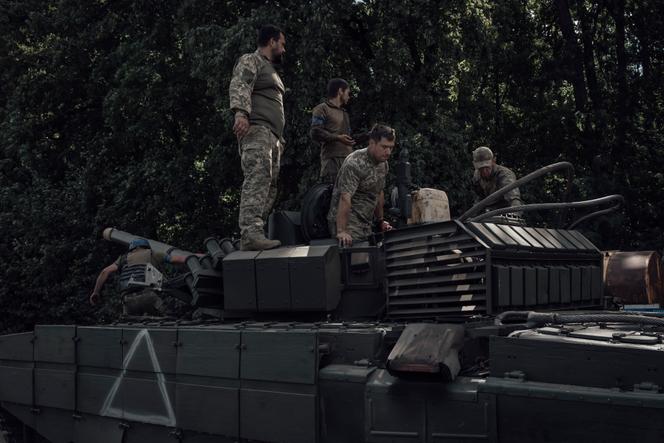
The well-planned Ukrainian army's incursion into the Kursk region highlighted the vulnerabilities of the Russian army and dealt a blow to the official narrative that the country was spared from hostilities. On Tuesday, August 6, thousands of Ukrainian soldiers crossed into Russian territory without encountering major resistance.
The checkpoints set up on the Russian side along the 245-kilometer border that the Kursk region shares with Ukraine were manned mainly by poorly trained conscripts from the border guards from the FSB (the Russian security service) and lightly equipped army infantry units.
The Ukrainians made their breakthrough with disconcerting ease. "It wasn't very hard," said Stéphane Audrand, an international risk consultant and reserve officer. "Since the spring of 2022, the northern border of the Donbas had been quiet, apart from a few small raids. So there were just two fairly simple lines of trenches, a few minefields and few men − a few hundred FSB and Russian National Guard personnel." The area, a no-man's-land five to 10 kilometers wide, was considered low-risk by Moscow. Meanwhile, all eyes were on the Donbas, where the fighting has been concentrated for months.
According to the military expert, the Ukrainian forces were able to enter with greater ease because their enemy had begun to clear the area of mines in preparation for an offensive. "For some time, the Russians had been quietly preparing an attack on Sumy [Ukraine] from the border zone. Demining had begun, but they hadn't massed any troops." Warned by drones and radar, the Ukrainians saw "an effect of opportunity" and decided to "pre-empt the attack" by launching themselves first, continued Audrand. "It's clever, they took the initiative again, whereas, since November 2023, Russia had been imposing its tempo."
The element of surprise was even more impactful because Moscow was convinced that Ukraine was not in a position to launch an attack and was instead focused on the Donbas and Crimea. Yet a few weeks before the incursion, Kyiv had massed thousands of soldiers in the Sumy region. Why didn't these movements catch the attention of Russian intelligence? "I can't believe [they] didn't know," said retired general Andrei Guruliev, vice president of the Defense Committee of the State Duma, Russia's lower house of parliament, speaking to the online media Svobodnaya Pressa on Monday, August 12.
Meticulously preparation
This setback sheds a harsh light on the inner workings of Moscow's army high command. According to the Russian Telegram channels Rybar and VchK-OGPU, General Esedulla Abachev, in charge of border protection at Kursk, had reported an abnormal concentration of Ukrainian troops in the Sumy region to his superiors a few weeks ago. However, the general staff either didn't believe it or didn't want to believe it.
You have 56.97% of this article left to read. The rest is for subscribers only.
Lecture du Monde en cours sur un autre appareil.
Vous pouvez lire Le Monde sur un seul appareil à la fois
Ce message s’affichera sur l’autre appareil.
Parce qu’une autre personne (ou vous) est en train de lire Le Monde avec ce compte sur un autre appareil.
Vous ne pouvez lire Le Monde que sur un seul appareil à la fois (ordinateur, téléphone ou tablette).
Comment ne plus voir ce message ?
En cliquant sur « Continuer à lire ici » et en vous assurant que vous êtes la seule personne à consulter Le Monde avec ce compte.
Que se passera-t-il si vous continuez à lire ici ?
Ce message s’affichera sur l’autre appareil. Ce dernier restera connecté avec ce compte.
Y a-t-il d’autres limites ?
Non. Vous pouvez vous connecter avec votre compte sur autant d’appareils que vous le souhaitez, mais en les utilisant à des moments différents.
Vous ignorez qui est l’autre personne ?
Nous vous conseillons de modifier votre mot de passe .
Lecture restreinte
Votre abonnement n’autorise pas la lecture de cet article
Pour plus d’informations, merci de contacter notre service commercial.
Netherlands' Hassan grinds out thrilling marathon gold in sprint finish
- Medium Text

SPRINT FINALE
Sign up here.
Reporting by Helen Reid; Editing by Peter Rutherford and Hugh Lawson
Our Standards: The Thomson Reuters Trust Principles. , opens new tab

Thomson Reuters
London-based reporter covering the European retail sector through a global lens. Focusing on companies including Adidas, H&M, Ikea, and Inditex and analysing corporate strategy, consumer trends, and regulatory changes, Helen also covers major supermarket groups like Ahold Delhaize, Carrefour, and Casino. She has a special interest in sustainability and how investors push for change in companies. Previously based in Johannesburg where she covered the mining industry.

Dutch convicted rapist considers quitting beach volleyball after Olympics criticism
Netherlands beach volleyball player Steven van de Velde, a convicted rapist, says he will consider quitting the sport if his participation in international tournaments continues to meet objections.


IMAGES
COMMENTS
The chateau was built at the end of the 15th century and is surrounded by 85 acres of grounds and woodlands. Top Map Itinerary Features Images In Depth References Dates & Prices ... in an awesome location with an amazing tour guide. The French Castles tour was an exceptional deposit in our memory bank and we cannot wait to follow Astrid again! ...
Château de Fontainebleau. Around 50km south of Paris, Château de Fontainebleau is another of France's largest châteaux with 1,500 rooms and 800 years of history. Today an enthralling tribute to French art, history and architecture, the 12th-century building once served as a residence for French monarchs.
Bienvenue! Welcome to the enchanting world of the Loire Valley, where history, romance, and architecture converge to create an unforgettable journey. If you're a traveler with a penchant for fairy-tale castles, you're in for a treat. This comprehensive guide will take you on a 7-day adventure through the magical realm of French chateaux.
Enjoy tours dubbed in English (from French), capturing every detail and story in your language. Crisp 4K Ultra HD Quality: Witness every intricate detail and the breathtaking beauty of each château in stunning clarity. Bi-weekly New Episodes: Discover a new château every two weeks. A continuous journey through France's architectural marvels.
3-Day Guided Normandy : D Day Beaches, Mont Saint-michel And Loire Valley Chateaux From Paris (NBC3) Loire Valley Castles. The Crusader Trail - Cathar Castles Walk. Castles of the Loire Valley - Amboise to Blois. Loire Valley Classic - Villandry to Chambord Castle Tour. Romantic France ( 8 days )
A visit to France isn't complete without a tour of an extravagant French castle, known as a chateau. France has quite a few to offer. Gothic, Renaissance, and Medieval-style castles are all at a traveler's fingertips. With tours about art, history, and gardens to wander, the French castle scene is one not to miss! First things first.
Simply clear your schedule, fork over 20 euros, and indulge in the regal luxury and history. Here are eight beautiful French châteaux to visit on your next trip. 1. Château de Versailles. Where: Versailles, France. When to visit: Open from 9 a.m.-6:30 p.m; palace is open year-round except Mondays and May 1. Visit: Palace tickets start at ...
Stroll through the châteaux of Chenonceau, Chambord, and Amboise on this full-day tour from Paris to the UNESCO-listed Loire Valley. Admire Chenonceau's amazing floral gardens, and marvel at the sheer grandeur of Chambord, the largest chateau in the valley. At Amboise, see the quarters of King Francois I and the tomb of Leonardo Da Vinci. Learn from an informative guide about each site, and ...
CHEVAUX & CHÂTEAUX. Château Living offers a unique opportunity to have a weekend away combining all-inclusive French chateau vacations, wine tours and Horse & Carriage experiences. It is a magnificent way to travel and takes your enjoyment of the châteaux and vineyards to another level. You can literally be transported back to another era!
The best Tours, France Castle & palace tours are: Chenonceau Castle Admission ticket. From Tours: Chambord, Chenonceau & Lunch at Family Chateau. Tours/Amboise: Chambord, Chenonceau Day Trip & Wine Tasting. From Tours: Chenonceau and Chambord Castles Guided Tour. Tours: Chateaux Azay-le-Rideau and Villandry Morning Tour.
Exclusive Tour of one of the most beautiful French Chateaux, guided by Alexandre de Vogüé, co-owner of Château de Vaux-le-Vicomte.You will discover the story...
The exterior, though, will take your breath away. First up is the three-hectare French garden, with its parterres, consisting of geometrical boxwood hedges, bright flowerbeds and yew topiary. Beyond this are the organic vegetable garden and a 30-hectare English-style park with a network of woodland paths and some remarkable tree species.
The French King Louis IX turned Château de Peyrepertuse into a crucial part of his defense line against Aragon. In 1242, King Louis IX decided to strengthen the castle and add a second part, the Donjon Sant Jordi (Saint Jordi's Keep), located higher up on the crest. ... Tours de Merle was a feudal fortress (castrum) built between the 12th ...
Swirling in Renaissance romance, 16th-century Château d'Azay-le-Rideau, a short hop south of Tours, is quite possibly the Loire Valley château of your wildest dreams - a graceful, perfectly proportioned vision of creamy stone, steep slate roofs and silver turrets, vainly admiring its reflection in the waters of its moat.
Afternoon at Chateau de Meung-sur-Loire. Start off your castle exploration with a lesser-known Loire Valley chateaux, Chateau de Meung-sur-Loire, a 30-minute drive southwest of Orléans. (16 Place du Martroi, 45130 Meung-sur-Loire.) Once the residence of the Bishop of Orléans, the castle has been rebuilt numerous times, with the oldest parts ...
A half-hour stroll from the Chateau de Versailles leads to the Domaine de Trianon, the most refined area of Versailles. ... Private Apartment, the Royal Opera House or the Royal Chapel, you must take a guided tour (available in English and French). Guided tours of the Petit Trianon and the Hamlet of Marie-Antoinette are available in French.
Château de Valençay. Construction on this château, in the region of Berry, began in the mid-16th century by French lord Jacques d'Étampes de Valençay, but it wasn't completed until the 18th century. Napoleon's foreign minister, Charles Maurice de Talleyrand, inhabited the palace during the early 19th century.
As the leaves turn and autumn graces us, So Châteaux is thrilled to unveil a fresh chapter in our journey. Starting December 1, immerse yourself in the world of French Chateaux like never before. Every week for 15 weeks, anticipate a newly dubbed castle tour guided by the owner + an exclusive weekly newsletter, delivering the latest updates ...
MEETING POINT. Duration 13:15 hour (s) Highlights. Transportation from Paris by air-conditioned vehicle. Experience an exceptional guided tour in the heart of France's Loire Valley. Discover the French châteaux that have inspired so many cinematic and literary works. Hear stories and anecdotes about majestic places that made history.
ParisCityVisionalso offers a package ticket with a direct shuttle from Paris to the château. Pack-Shot / Shutterstock. 11 of 11. Château de Saint-Germain-en-Laye (Musée d'Archéologie ...
DENVER (KDVR) — A chateau in the Villages at Castle Pines has closed for $6.5 million, marking the second-highest sale price in the city of Castle Rock. The house, located at 329 Paragon Way ...
Bordeaux. Bordeaux is world-famous for its vineyards, which you can discover by bike or on a visit to the Cité du Vin. Alongside the city centre, which has been classified as a UNESCO World Heritage Site, are the terraces on the banks of the Garonne where you can laze around, not forgetting the Arcachon Basin and its oyster-farming villages, less than an hour away by train.
From Normandy to Provence and everywhere in between the owners of these chateaux-including decorators, antique dealers, artists, and collectors—represent the epitome of French culture and taste. Each chateau is presented in double-page full-color spreads that feature alluring interiors and information about the hosts and their design ...
THE 10 BEST Moscow Walking Tours. 1. Moscow Private Tours. We got a good and knowledgeable guide Maria she explained everything in detail and guided us so patient. 2. Moscow Free Tour. We were on a free walking tour around the centre, enjoyed it immensely. The guide was cool and friendly.
A French chateau in Kabarda-Balkaria. Chateau Erken. This Gothic castle with high towers, massive iron gates and a lake with swans is located in the Kabarda-Balkar Republic in the North Caucasus ...
As Ukraine's foreign minister completes his latest tour of Africa, his country risks paying a serious diplomatic price for helping separatist rebels in northern Mali inflict a severe defeat on ...
Chateau Chantal - No. 1 Wine Country Hotel; Ludington, Michigan - No. 1 Historic Small Town; Mackinac Island - No. 1 Best Summer Travel Destination; Hop Lot Brewing Co. in Suttons Bay - No. 2 Beer ...
Moscow considered the border zone in the Kursk region, a no-man's-land five to 10 kilometers wide, to be low-risk. Military experts say that instead, all attention was focused on the Donbas.
The Paris course, taking athletes out to the Chateau of Versailles and back, was designed to commemorate a protest during the French Revolution in which thousands of women marched on Versailles to ...